



Adelaide’s Siva Selvakulalingam OAM FREE Vol. 18 No. 5 (1) • February (1) 2011 • www.indianlink.com.au • FORTNIGHTLY SYDNEY Level 24/44 Market St, Sydney 2000 • GPO Box 108, Sydney 2001 • Ph: 18000 15 8 47 • email: info@indianlink.com.au Published Sydney • Melbourne • Adelaide • Brisbane • Perth Australia Day honours Melbourne’s Dr. Mukesh Haikerwal AO Perth’s Ramdas Sankaran OAM

2 <> FEBRUARY (1) 2011 INDIAN LINK

FEBRUARY (1) 2011 <> 3 NATIONAL EDITION
VEGETARIAN PARATHAS
Poodina Paratha
Lachha Paratha
Palak Paratha
Aloo Paratha
Methi aloo Paratha
Oriental style stir fry

paratha
Mushroom and pea paratha
Stuffed vegetable and cheese Paratha
Paneer Paratha
Methi Paratha

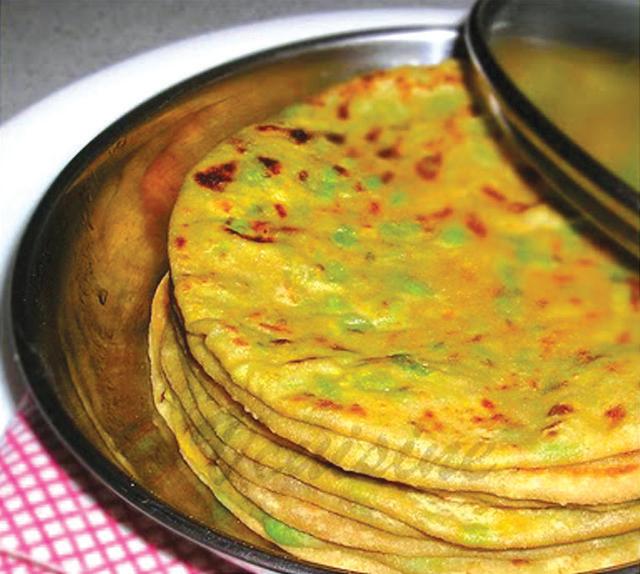
Mooli Paratha
Gobi Paratha
Mattar Paratha
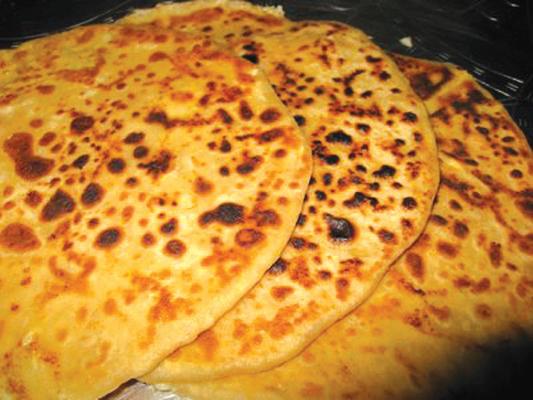
NON-VEGETARIAN PARATHAS


Keema Paratha
Chicken Paratha


Egg Paratha
DESSERT PARATHAS
Shakkar Paratha
Chinni Paratha
4 <> FEBRUARY (1) 2011 INDIAN LINK 139 STEPHEN STREET BLACKTOWN PHONE: 9671 7820 The true taste of Punjabi food and our Sydney famous special Paranthas Quality Quantity Service
139 STEPHEN STREET BLACKTOWN PHONE: 9671 7820 Call now on 0404 086 254 Quality Quantity Service Take-away Catering from $9pp UNLEASH THE FLAVOUR of traditional Indian food
INDIAN LINK
PUBLISHER
Pawan Luthra
EDITOR
Rajni Anand Luthra
ASSISTANT EDITOR
Sheryl Dixit
MELBOURNE
Preeti Jabbal
CONTRIBUTORS
LP Ayer, Sai Narayan, Malavika Santhebennur, Tim Blight, Mamata Salakapurapu, Tanveer Ahmed, Roy Lange, Mark Sharma, Noel G deSouza, Dilip Jadeja, Madhuchanda Das, Gaurav Pandey, Jitarth Jadeja, Thomas E King, Farzana Shakir, Akriti Goel, Ian Neubauer, Rani Jhala, Nancy Sood, Shraddha Arjun.
ADVERTISING MANAGER
Vivek Trivedi 02 9262 1766
ADVERTISING ASSISTANT
Drishya Sharma 02 9279 2004
GRAPHIC DESIGN AND LAYOUT
Kaye Martin
Indian Link is a fortnightly newspaper published in English. No material, including advertisements designed by Indian Link, maybe reproduced in part or in whole without the written consent of the editor. Opinions carried in Indian Link are those of the writers and not necessarily endorsed by Indian Link. All correspondence should be addressed to
Indian Link
Level 24/44 Market St, Sydney 2000 or GPO Box 108, Sydney 2001
Ph: 02 9279-2004 Fax: 02 9279-2005
Email: info@indianlink.com.au


A new world order?
The world is at interesting cross roads. In early January, the masses in Tunisia forced their President Zine El Abidine Ben Ali to flee the country to end his 23 years of rule. This was a wholly unprecedented happening in the Arabic world where dictators have forced their will on the people. This unrest seems to have spread across to other neighbouring countries most notably Egypt. At the time of going to press, the stalemate in Egypt was in the 11th day with little indication of progress from either side. While Egypt’s president of 33 years Hosni Mubarak has offered to resign in due course, the anti-government protestors want him to step down now. Fearing this malaise can spread further, even Jordan’s King Hussein has been urged by his supporters to fast track changes in his kingdom.
The fire is spreading and seems to have taken the observers such as the United States by surprise.
Some of the reasons behind the revolts in these countries are now becoming clear. Besides the urgent cry for democracy and the desire of the masses to express their views, there is also the fact that with an increasing younger population, there is rising
BY PAWAN LUTHRA
unemployment. While these countries have enjoyed economic growth earlier in the last decade, the meltdown due to the global financial crisis has found its way into the economies of these countries, whether through a sharp downturn in the economic growth, the introduction of governmentimposed austerity measures (though not mandated as in some European economies) or a lay-off in employment.
Globalisation, which benefited these countries in past decades, is now sucking the very oxygen which fuelled their prosperity. The spread of technology – internet and social media – is also educating and guiding the younger generations.
Higher food prices, better education, greater exposure to world trends and general overall knowledge, are creating a generation of frustrated and intelligent middle class. If these are the ingredients of a popular
uprising, communist countries such as China need to pay heed as to the voices of the public which at times can rise to a crescendo, calling for drastic changes. China does rule its citizens with an iron fist but then so did Mubarak. With Australia’s economy so intertwined with that of China, the issues in the Arabic world and the causes behind it need to be analysed and understood by the policy makers of this country. When people realise they are not getting the best deal and feel they have had enough, they then take to the streets, as evidenced in Egypt. The protestors here seem to be more the thinking middle class rather than extremists. In Egypt, television pictures of burqa-clad women amongst the antiMubarak protestors, have shown the depth of the community participation in this rally. Directions in this revolt do not seem to be coming from the distant hills and hideouts in Afghanistan.
A new world order which seems not to be tainted by extremism, seems to be emerging. As to how long it perseveres, or whether it will be tainted with extremism, remains to be seen.
FEBRUARY (1) 2011 <> 5 NATIONAL EDITION www.indianlink.com.au EDITORIAL
What’s On
SPIRITUAL
Mysore spiritual leader visit Sat 19 March Sri Anaghadatta Inc presents Sr Sri Ganapathi Sachidananda Swamiji performing a Sri Chakra Pooja and Ganapati Homa at Redgum Function Centre, 2 Lane St, Wentworthville, 9.30am.
Sun 20 March Healing and Meditation Music at Marana Auditorium, 16 MacMahon St, Hurstville, 5.30pm.
Details Santosh Vanka 0412 677 670.
Chinmaya Mission events
Feb 21 – 26 Free public talks True Goal of Spirituality with Br Gopal Chaitanya. 7.30pm9.00pm at Chinmaya Sannidhi Ashram. Thur 3 March Mahashivratri festival 7.30pm to midnight.
Details Chinmaya Sannidhi 02 8850 7400 / 0416 482 149.
Brahma Kumaris weekend retreat
1 – 3 April Brahma Kumaris Raja Yoga Meditation Centres, Sydney invite you to a weekend Hindi Retreat to understand and explore the secrets to establish easy and constant link with the Almighty Authority for inner peace in the self. Venue: Inner Space Centre for Spiritual Learning, 150 Macarthur Drive, Wilton. Details Asha Bhen 0435 196 146 or Devendra Bhai on 0431 446 056.
STAGE
Sydney Gay and Lesbian Mardi Gras
Feb 18 – 27 As part of the 2011 Sydney Gay and Lesbian Mardi Gras festival, Trikone Australia presents a stage production In The Space Between dealing with homosexual themes within the Indian context as well as within Australian-Indian context (and features stunning costumes, foot-tapping music, sweeping dance numbers, promising
an evening of quintessential Bollywood entertainment). Cleveland Street Theatre, 199 Cleveland Street, Redfern. Details Akash Arora 0430 933 234.
Sri Purandharadasa Aradhana
Sun 20 Feb A classical tribute to one of Carnatic music’s greatest composers, 9:00 am – 2:00 pm, Ermington Community Hall (8 River Road, Ermington).
Details Anu Ananda 9764 4587.
FUNDRAISERS
I-India Project for Rajasthani kids
Wed 23 Feb I-India Project Australia’s fundraising dinner for the Jhag Children’s Village in Rajasthan will be held at one of Sydney’s favourite Chinese restaurants, Golden Century at Fox Studios, Moore Park, at 7.30pm. This year’s dinner celebrates the 2011 Chinese New Year, the Year of the Rabbit, with a ten course banquet. The cost is $110 per person. Lucky door prizes, raffles, auctions and entertainment will add to the evening’s fun. Funds raised will help ongoing work at the Jhag Children’s Village which is a residential and educational facility for vulnerable children in Rajasthan that yearn for brighter futures. RSVP is the 16th February. Details 0402 958 582 or visit www.i-indiaproject.org.au

Holi Hullad
Fri 25 March Rekha Rajvanshi presents Holi Hullad, a fundraiser for the Queensland flood affected. Enjoy the spirit of Holi with Bollywood songs, dances, humorous poetry, tambola and Bollywood trivia and traditional Holi dinner. 7.30pm-11.00pm at Parravilla Function Centre, 42 Campbell St Parramatta. Details Rekha Rajvanshi 0403 116 301.
FILM
The Future Makers
Tue 8 Feb Climate Action Burwood Ashfield together with Ashfield Council are putting on a free movie night featuring the documentary The Future Makers. Venue Cadigal Room, Ashfield Pool, cnr of Elizabeth and Frederick Sts, Ashfield, 7pm for 7.30 showing.
Free tea and coffee provided.
The film tells the story of key Australians leading the way on the world stage in renewable energy. Some are designing a future based on models in nature. Others are creating a sustainable energy model for a 21st economy. It features the Indian origin scientist Dr Prame Chopra who is leading Australian research in the field of geothermal energy.
Exhibition
Until February 18. India – Past, Present and Abroad, a new exhibit of Indian art as seen through the eyes of three contemporary photographers, is on at the Macquarie University Art Gallery.
Through their work, the exhibit’s three photographers, Effy Alexakis, Nathalie Hartog-Gautier and Jon Rhodes document the overlaps, ambiguities and commonalities of the everyday conveying the rich and varied communities throughout India and its global diaspora.
Alexakis’ portrait series beguiles the viewer through a stimulating visual representation of the immense diversity and complexity of Sydney’s Indian presence. HartogGautier says she became fascinated by the representation of botanical specimens in the architecture of Rajasthan. Jon Rhodes’ photographs were taken while traveling
in Calcutta, West Bengal and Godalpuron-Sea in South Orissa during 1978 and 1979. Rhodes says his photos reflect a tiny fraction of day-to-day happenings yet also leave him with so many unanswered questions about India, its contrast and extremes.
Details 02 9850 7437 or at www.artgallery. mq.edu.au
LECTURE
Wed Feb 16 Dr. Jane Chapman, a Professor of Communications at the UK’s Lincoln University presents a talk entitled India’s Secret Heritage – a Tale of Two Cities at Macquarie University, 6.00pm. Dr Chapman, who specialises in the communications history of disempowered groups, will speak on aspects of India’s recent past that still need to be uncovered by historians.In particular, Dr Chapman will focus on two little known episodes in 20th century Indian history when newspapers expressed the emerging citizenship of protest by the freedom movement in India. The episodes took place in Allahabad, United Provinces (Uttar Pradesh) in British India and in the French territory of Pondicherry (Tamil Nadu). Details email rhonda.davis@mq.edu.au or phone 02 9850 7437.
MISC
UIA’s community forum
Sat 5 March Women’s Forum
Sat 19 March Seniors Forum
Both events will be held at 10.00am at Parravilla Function Centre, 42 Campbell St., Parramatta. Working lunch will be provided on both days. Details Aruna Chandrala 0410 338 900.
6 <> FEBRUARY (1) 2011 INDIAN LINK

FEBRUARY (1) 2011 <> 7 NATIONAL EDITION


8 <> FEBRUARY (1) 2011 INDIAN LINK
Mukesh Haikerwal, AO
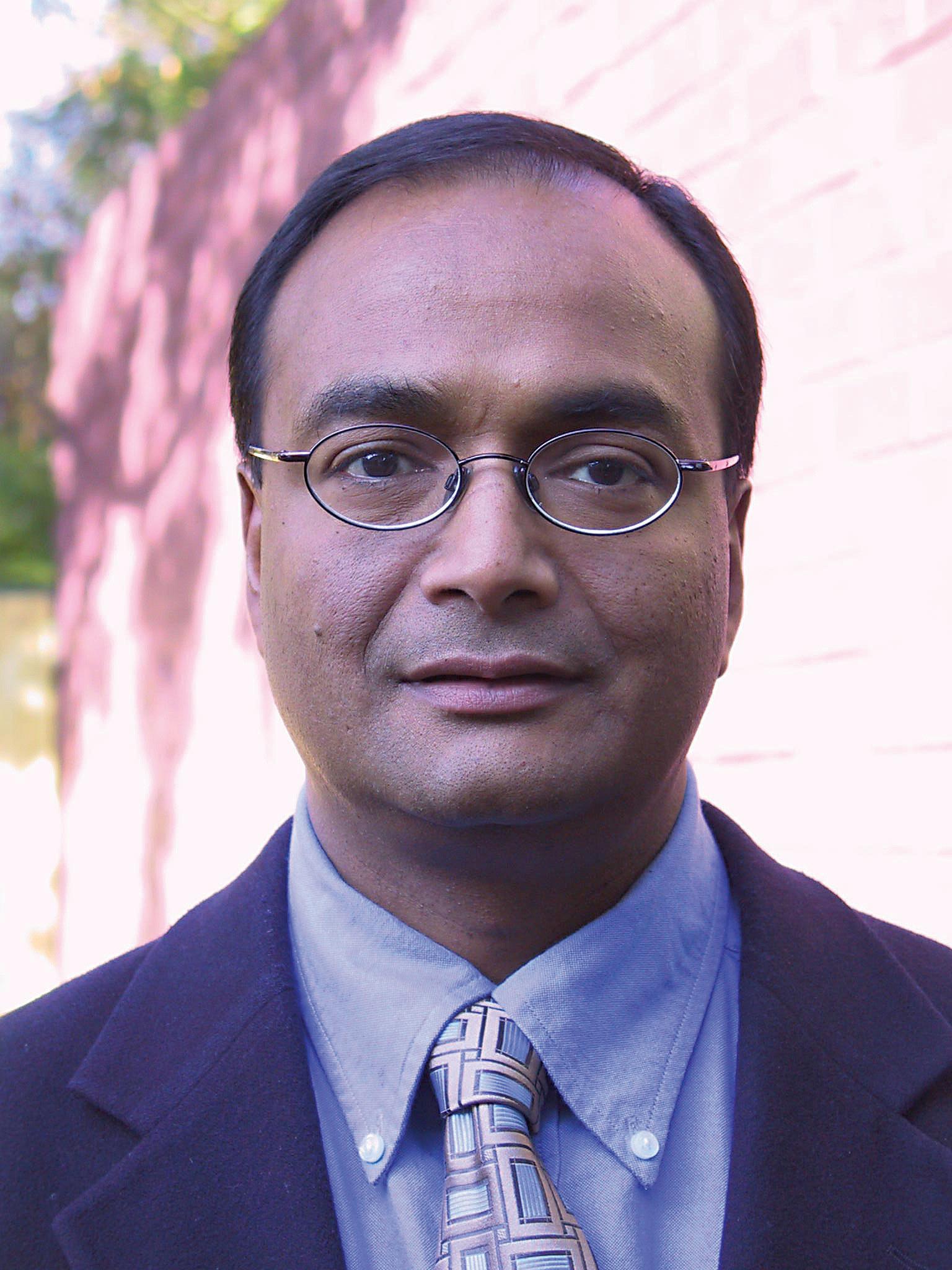
A well-deserved honour for a prominent member of the Indian community, a distinguished doctor and an exemplary person
BY PREETI JABBAL

On Australia Day 2011, Indian-born Dr. Mukesh Haikerwal was among those who were appointed as Officer of the Order of Australia, one of the country’s highest civilian awards. Dr Haikerwal is only the second Indian after Mr. Neville Roach to be felicitated with this highly prestigious award. He received the honour ‘for his distinguished service to medical administration, to the promotion of public health through leadership roles with professional organisations, particularly the Australian Medical Association, to the reform of the Australian health system through the optimisation of information technology, and as a general practitioner’. Former Australian Medical Association President and GP (Western suburbs), Dr Haikerwal has considerable influence in the field of Australian medicine.
When asked if he had any inkling that he was on the Australian Honours list this year Dr. Haikerwal revealed, “The letter notifying me of the Honour was sent in December and was a complete surprise to me. It had to be kept under wraps till the official announcement in January.
I was obviously pleased to receive such a major honour especially as someone new to the country; it shows that Australia lives up to its promise of being a ‘destination country’. It provides the opportunities to everyone to get ahead in their chosen field and gives everyone a fair go,” he said.
When asked who would feature in his vote of thanks he said, “I am thankful to my family, my colleagues and my patients who have all been very accommodating and allowed me to pursue my dreams, especially my wife who supported me through the years.” Dr. Mukesh Haikerwal is married to Dr. Karyn Alexander and together they have three sons - Ajay, Suresh and Jeevan.
Dr. Haikerwal once said in an interview that his sons were over watching him on TV and quite immune to his media profile. What did they think of this award? “My children think it is very ‘cool’ that I was honoured, but I don’t think it has made any great impact on them. These things are relished more in adult life and they are too young to grasp the importance of the recognition,” he added with a smile.
Dr. Mukesh Haikerwal was famously quoted as saying, ‘You can make improvement without a revolution’. I asked whether he still holds that opinion to which he replied, “Absolutely!
I still maintain that there is no need for a revolution or aggression especially in relation to health in Australia. There is a lot to do but Australia is a strong country and it is managing health in a struggling, but effective way. Having worked and studied in Leicester (UK) I can make comparisons and the Australian system is unlike the British or American. Contrary to what people think it is not ‘just like England with a sun’. People in Australia want and receive care in a different way to that in England. We are working towards acquiring a good balance of public and private health in Australia.”
In September 2008, Dr. Haikerwal had a near fatal experience after being bashed and robbed near Dennis Reserve in Williamstown, Victoria. He sustained serious head injuries in the attack and was in a coma for 24 hours, remaining in hospital for two months. He underwent emergency brain surgery and has had to re-learn how to walk and talk. I asked him whether he sees life differently after that incident and has he felt the need to make any changes to his lifestyle, work or philosophy? “After a life threatening incident like the one I faced, you start taking stock of your life and your philosophy
changes,” he replied. “Things that would upset me earlier no longer affect me. I am consciously seeking and making efforts towards a more balanced life,” he added.
With relation to Indian community he said, “There are an increasing number of people of Indian origin in Australia. With someone from an Indian origin like me getting honoured, it reiterates to them that there is a chance of progressing in Australia as well. It is a country that gives everyone a fair go,” he stressed again.
Dr. Haikerwal, who as a victim of violence himself, has been very vocal in comments about safety and security in Australia. “The violence against Indians appears to have calmed down which is very good. In a sense the media scrutiny from last two years has brought many issues to the fore. This has been instrumental in cleaning up the Australian International education system of rogue operators and dodgy colleges. People overseas are now more aware of what they will gain by studying here and they are also aware of people and places that were not giving them the real deal and trust that they deserved,” he said in conclusion.
Dr Haikerwal has an impressive list of credentials to this name. In July 2010, Australia’s leading independent medical publication Australian Doctor named him as one of 50 Australians currently most influential in General Practice in Australia. He was commended for his
passion and belief of e-health and the impact it can have in enhancing the safety and quality of healthcare. Dr Haikerwal has been recognised for his work in various public roles, including that of commissioner on the National Health and Hospitals Reform Commission. Apart from practicing as a GP, he is currently Head of Clinical Leadership and Engagement, National Clinical Lead, National e-Health Transition Authority (NEHTA), and is playing a pivotal role in e-health reform in Australia.
Dr Haikerwal has enjoyed roles as Professor,
School of Medicine, Faculty of Health Science, Flinders University, Adelaide; Chair Finance and Planning Committee World Medical Association; Member NH&MRC Health Care Committee; 19th President, Australian Medical Association and Former Commissioner, National Health & Hospitals Reform Commission.
FEBRUARY (1) 2011 <> 9 NATIONAL EDITION
www.indianlink.com.au
COVERSTORY
“There is a lot to do but Australia is a strong country and it is managing health in a struggling, but effective way”.
“I was obviously pleased to receive such a major honour especially as someone new to the country; it shows that Australia lives up to its promise of being a ‘destination country”.
Keeper of the faith
An award-winning entrepreneur, Siva Selvakulalingam OAM is now a devoted temple official
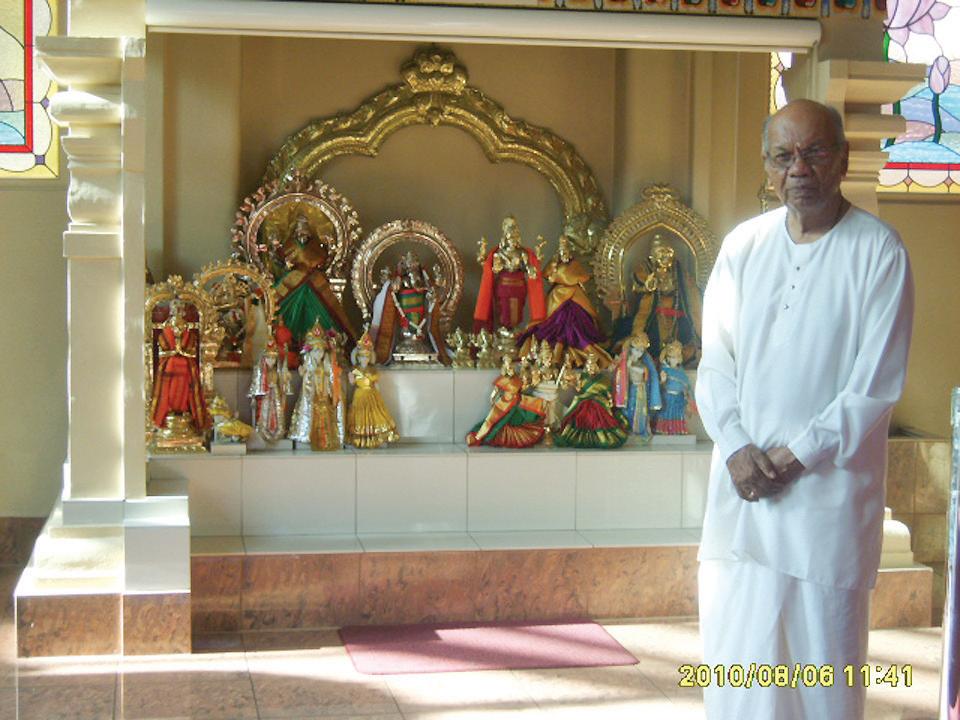 BY LP AYER
BY LP AYER
South Australia’s Hindu community received well-deserving recognition on Australia Day when its president, Siva Selvakulalingam, was named among the recipients of the Medal of the Order of Australia (OAM).

Selva, as he is popularly known, was given this honour for his services to “the community through the Hindu Society of South Australia”.
A mechanical engineer by profession, Selva arrived in Australia in 1988 as a business migrant after working as Managing Director of a well-known British woodworking machinery firm in Malaysia. On arriving here he set up a timber importing business jointly with a partner, and later started his own enterprise making wine racks under the brand name Bordeaux, using off-cuts that would have normally ended up as firewood in Malaysia. His innovative technique and export success earned him State Government awards for small and medium industries on two occasions in 2002 and 2005. Since retiring four years ago at 68, he has been devoting all
his time to his favourite hobby of managing the local temple with which he was involved almost from the day he arrived in Adelaide.
What’s the big deal in running a temple, every capital city has one or more of them, one may ask. Unlike the eastern seaboard cities, Adelaide had, and still has, a much smaller community and it was a major achievement to establish a temple way back in 1986 only two years after the Hindu Society was formed, and one that was possibly only the second in the country after Helensburgh SVT. The ‘devoted dozen’ of the Society bought a disused church and after ceremoniously installing a Ganesha idol, converted it into a place of worship that also served for new arrivals as a place to meet and make friends, and help themselves in their struggle to settle down in a new country. The temple still serves in the role of a social and cultural hub to a much larger number of new immigrants as evidenced by the attendance on any given day

Since early 1990s, several proposals were made for the temple that still wore the look of an old church, to have a makeover. In 1998, the Committee with the active backing of its president decided to re-build it in the style of a traditional Indian temple. After two years of work, the Adelaide skyline came

to be dotted with a new spiritual edifice with a unique glass roof and a colourful ‘gopuram’ that attracts every passerby. The purchase of the old church and the new temple’s building work were all financed by donations from the local Hindu community without any loan or external financing. That is an achievement in itself.
In all this work Selva played a key role and, since becoming the Society’s President in 2001, he has been its guiding hand in more ways than one. One can spot him every Sunday at the temple, in his floppy hat, trimming hedges, pruning roses or sweeping the car park, while his wife Sivanes cleans the floors inside. At other times, wearing a snow-white dhoti and kurta, Selva is around to ensure that every ceremony is conducted according to established traditions. In many ways he resembles a conductor of an orchestra. In between, he thinks up ways of raising funds and keeping the books in a healthy state. Such is his devotion. His liaison with the State and local government circles has helped the Society to create a name for itself.
The temple is more than a place of worship; it serves as an educational centre holding Indian language classes, maintaining a well-stocked library, offering spiritual
discourses by visiting scholars, yoga and meditation courses and also providing its premises for family functions like weddings and anniversaries. The temple has evolved into a multi-purpose centre helping to enrich the lives of local Hindu community members.
The temple has evolved into a multi-purpose centre helping to enrich the lives of local community members.
Another unique feature is regular weekly visits by private and public school students who receive a briefing on the salient aspects of the deities there, thus helping other sections of society understand and appreciate our culture.
Continuing to play a key role in all these, Selva can be proud of the honour bestowed on him He was happy to admit that his wife “deserves to share his award” since she does as much as him.
Being very devout, Selva greets everyone with the words “Hari Om!” Now we can respond, “Hari OAM”!

10 <> FEBRUARY (1) 2011 INDIAN LINK
www.indianlink.com.au COVERSTORY
Selva at Adelaide’s Ganesa Temple
Mentor of multiculturalism
Ramdas Sankaran OAM was a promoter of unity and equality long before he joined the Ethnic Communities Council of WA.
BY SAI NARAYAN
Ramdas Sankaran received the prestigious Medal of the Order of Australia for services to multiculturalism and to the community of Western Australia, on Australia Day 2011. Besides this exemplary honour, he was presented the Western Australian Premier’s Multicultural Ambassadors Award in 2003, in recognition of his commitment to the realization of equality for all people and communities for over 25 years. The Federation of Ethnic Communities Council of Australia also awarded him a medallion in recognition of his contribution to multiculturalism.
I met Mr. Sankaran to talk to him about his work, and he came across as highly personable with a great sense of humour. Mr. Sankaran came to Australia in 1978 with qualifications in medical and psychiatric social work. He encountered entrenched racism as Australia was just emerging from the shadows of the White Australia policy. However, he took it in his stride and acknowledged the complexities of racism beyond the traditional whites versus the rest.
He went on to serve the community by organising and working toward a racism-free society, promoting human rights awareness, aboriginal reconciliation and developing services for ethnic minorities in the areas of aged care, mental health, disability etc. Mr. Sankaran has been the Executive Director of the Multicultural Services Centre of Western Australia (MSCWA) since 2002 and in his interesting career of 32 years, he has served as President and Executive Officer of the Ethnic Communities Council of WA, as well as Co-Founder and Administrator of Ethnic Disability Advocacy Centre, among others. (Readers can access www.mscwa.com.au if they are keen to know more about the work of MSCWA).

Mr. Sankaran is passionate about his work against racial discrimination and making the community more aware of the phenomenon of racism. “I don’t know many people who can look in the mirror and say that they have not said, done or thought something other people would describe as racist,” he says. “I certainly cannot. It’s about getting people to look at racism in a more comprehensive
way and getting government agencies and media itself to become more conscious of it. Only then will we treat each other equitably, fairly and in a more courteous way, and that would give me much pleasure”.
On a lighter note, Mr. Sankaran relates an incident where someone called his son Ashwin a “blackie” in school. His son shot back, “Thanks for the compliment!”
Mr. Sankaran calls this the ‘Ashwin Sankaran strategy’ to combat racism!

About his adopted country, he says, “We have an opportunity to make a great country greater or watch it slide down a slippery slope of social inequity and exclusion. I opted for the former.” Freedom of speech and the right to make one’s opinion heard are wonderful strengths of this country and as citizens he feels that we have a duty to make good use of it to enhance our democracy.
Behind every great man is a great woman. Mr. Sankaran acknowledges that without the support of his wife Bagia who works as a nurse and midwife and is highly regarded by her patients, it would have been very difficult to sustain
the level of commitment that his work demanded. There were many weekends when he literally lived out of his office. Their two sons are now in their twenties; Ashwin has an accounting practice and lectures part time, and Ahkash is studying computer engineering.
For Mr. Sankaran, more than any honour or award, the most satisfaction has come from seeing the work he conceived and launched for various dis-enfranchised sections of the community come to fruition. He also mentions the tireless work of countless volunteers, staff and board members in his organisation, who do not receive an award but without whom nothing could have been achieved.
In a message to the Australian Indian community, Mr. Sankaran states that he would like to see them more actively involved in asserting their rights when discriminated against by writing to relevant government agencies and politicians. He also wants to see greater involvement of Indians in politics at all levels of government.


FEBRUARY (1) 2011 <> 11 NATIONAL EDITION
www.indianlink.com.au COVERSTORY
Do you have experience in Fast Food Industry? Do you have between $25000 – $100,000 to invest? Are you interested in owning and operating fast food franchise outlets (Pizza, Chicken, Coffee, Indian, Thai) in partnership with a hands off investor on a profit sharing basis? Please send your Resume and details of experience to cafenew@ymail.com Business Opportunity Food Industry Parkus Technologies Pty Ltd Suite 33, 2 O’Connell Street, Parramatta, NSW - 2150 Office: + + 61 2 96332003 : Mobile : 0402 172 777 Email: info@parkus.com.au Visit us @ www.parkus.com.au Parkus Technologies is as CISCO authorised Learning Partner Associate, offering Associate and Professional level courses at an amazing promotional price for each discipline. The benefits of joining Parkus are:
Ramdas Sankaran with his wife Bagia and sons Ashwin and Akash

12 <> FEBRUARY (1) 2011 INDIAN LINK





FEBRUARY (1) 2011 <> 13
Caring for the community
BY MALAVIKA SANTHEBENNUR
Australia Day 2011 was a memorable one for 18-year-old Kirandeep Kaur. She was the recipient of the 2011 Bankstown Council Young Citizen of the Year Award for exceptional contributions to her school and community. A fresh graduate from Beverly Hills Girls High School, Kiran has just completed her HSC, and during her time at school, left an indelible impression on both teachers and students as well as the wider community in Bankstown. Her involvement in extensive youth, school and community-based activities, and her position as school vice captain has earned the young lady many awards, finally leading to this pinnacle award.
“It was really nice to receive the Young Citizen’s Award because it felt like all the work I do was being acknowledged,” Kiran said. “In fact, I didn’t expect it at all… but it hasn’t changed anything for me; it has motivated me to continue my efforts in being an active member of the community. And that is the role I intend doing, and even spreading – the idea of community involvement and how special it feels to help others and promote the feeling of togetherness in society.”
The award was presented to Kiran during Bankstown City Council’s Australia Day celebrations by Mayor Clr. Tania Mihailuk, and Channel 10 personality, Dr. Lisa Chimes ( Bondi Vet ). Bankstown Council described Kiran as an excellent ambassador for her school and her community. The council also appreciated her love for Indian culture as well as her Australian identity.
Kiran has been a socially aware person from a very tender age, nursing a passion for spreading messages of gender equality and helping people in unfortunate circumstances. She was a tutor at her school maths club since its inception, and has been a mentor of the school’s environmental committee. She was also a member of the peer tutoring program, SASSY (Successful Aspiring
Students Supporting Youth), which assists students at the Intensive English Centre (IEC) with their English speaking skills. Every Friday, Kiran gave up her lunchtime to help students with their reading and pronunciation skills, and this was very special for Kiran.
“Many of these students have had a tough time in their countries and are often seeking refuge in Australia as soon as they are out of asylum,” Kiran said. “It’s really nice to be able to help them out, and we also learn so much about them. This interaction helps bring the community together and helps them build confidence in their English language skills”.
Among Kiran’s impressive trove of awards is the cherished Excellence in Senior Public Speaking certificate and trophy during her senior years in high school. She has used her public speaking skills at events like Harmony Day, at the Anzac Day commemorative ceremony at Kingsgrove RSL (where she recited the oath of remembrance), and at the Leaders of Today & Tomorrow conference (where she mentored young students on leadership skills and gave a presentation entitled ‘Leaders in Action’).
This exemplary student is just as adept in sporting and social activities. “I’m a very keen soccer player and with my six years of soccer with Panania Youth Soccer Club, I’ve helped the club fundraise via events like Trivia Night,” she said.
One of Kiran’s finest achievements was receiving the 2009 Zonta Young Women in Public Affairs Award. She won it for the Botany Bay region, and went on to represent the region at the national level. “This event gave me the opportunity to voice my views on women’s rights. I have had this thing about women’s power and rights since I was young, and I definitely and truly believe that each woman can contribute to the empowerment of other women around the world by striving to take advantage of opportunities. We can all influence positive change,” said Kiran vehemently.

Kiran also continually supports the Jane McGrath Foundation, founded by cricketer Glenn McGrath whose wife Jane died from cancer a couple of years ago. She has received many other awards
including the Reuben S. Scarf award for commitment to school leadership and community, the Australian Defence Force Long Tan Leadership Award and the Student Representative Council Award for Young Women Can Do Anything. She has also been nominated for the Marie Bashir Peace Award.

Finishing off with an ATAR of 93, Kiran intends to pursue her passion for mathematics by studying Bachelor of Science in Mathematics and Finance at the University of Technology, Sydney. Kiran credits her father for her passion in mathematics, who is a maths teacher.
Along with a penchant for numbers, Kiran also loves the Italian language, and



Italian Continuers was one of her HSC subjects.


“I have a very profound interest in the language, the culture and the country of Italy,” she says.
“I love Italian food, Italian films and Italian music. Tiziano Ferro is my favourite artist and I also like the band ‘Sonhora’, as their music is soft, tranquil and inspiring.” But right now, she is taking advantage of her holidays to catch up on reading. When she isn’t reading a Jane Austen novel, she is probably kicking back with an Aamir Khan or a Hrithik Roshan movie. Bollywood movies are her second favourite pastime!
Sant Mat is a practical spiritual path based on meditation, ethical living, service to others & love for all creation. Its goal is to enable the soul to return & merge into its source; the purpose of human life described by mystics of all traditions. Discipline & dedication are essential, as is the help of a competent living master. Entry is via a preparation program. There is no charge at any stage.
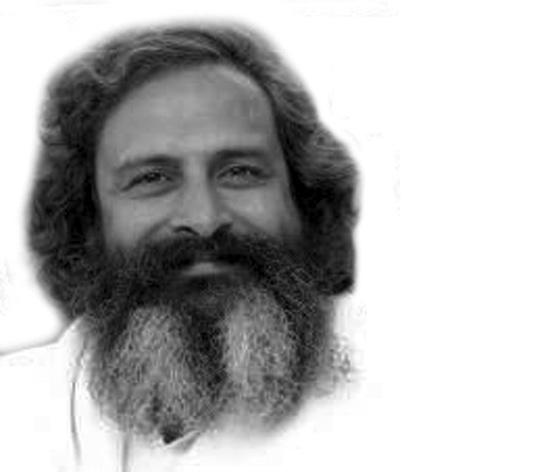
14 <> FEBRUARY (1) 2011 INDIAN LINK
With an already impressive list of awards to her name, Kirandeep Kaur is determined to continue to make a positive change in the community
www.indianlink.com.au COVERSTORY
(6 months waranty provided to all jobs) We Treat All Pests • Cockroaches • Rats, mices • Ticks • Bed bugs • Fleas • Spiders • Termites (Save your houses) We accept all cards, cheques, cash ABN 77259217613 CALL SHAUN (SAROJ) 0421 936 489 $155 (Conditionsonly Apply) 10% discount to all restaurants, pensioner No.1 No.1 Pest Pest Control Control KNOW THYSELF
more information...
AS SOUL For
155 www.santmat.net.au Know Thyself As Soul Foundation is a not for proft association incorporated in NSW
Contact Sita 0408 880
BY JYOTI SHANKAR
Nolan Bushnell once said, “Everyone who’s ever taken a shower has an idea. It’s the person who gets out of the shower, dries off and does something about it who makes a difference”.
Speaking to Lalitagauri Nadkarni, winner of the 2011 Australia Day Young Citizen of the Year award from Ashfield Council, one gets the impression of such a person who is out to make all her ideas a reality, and in the process, make a difference to her community.
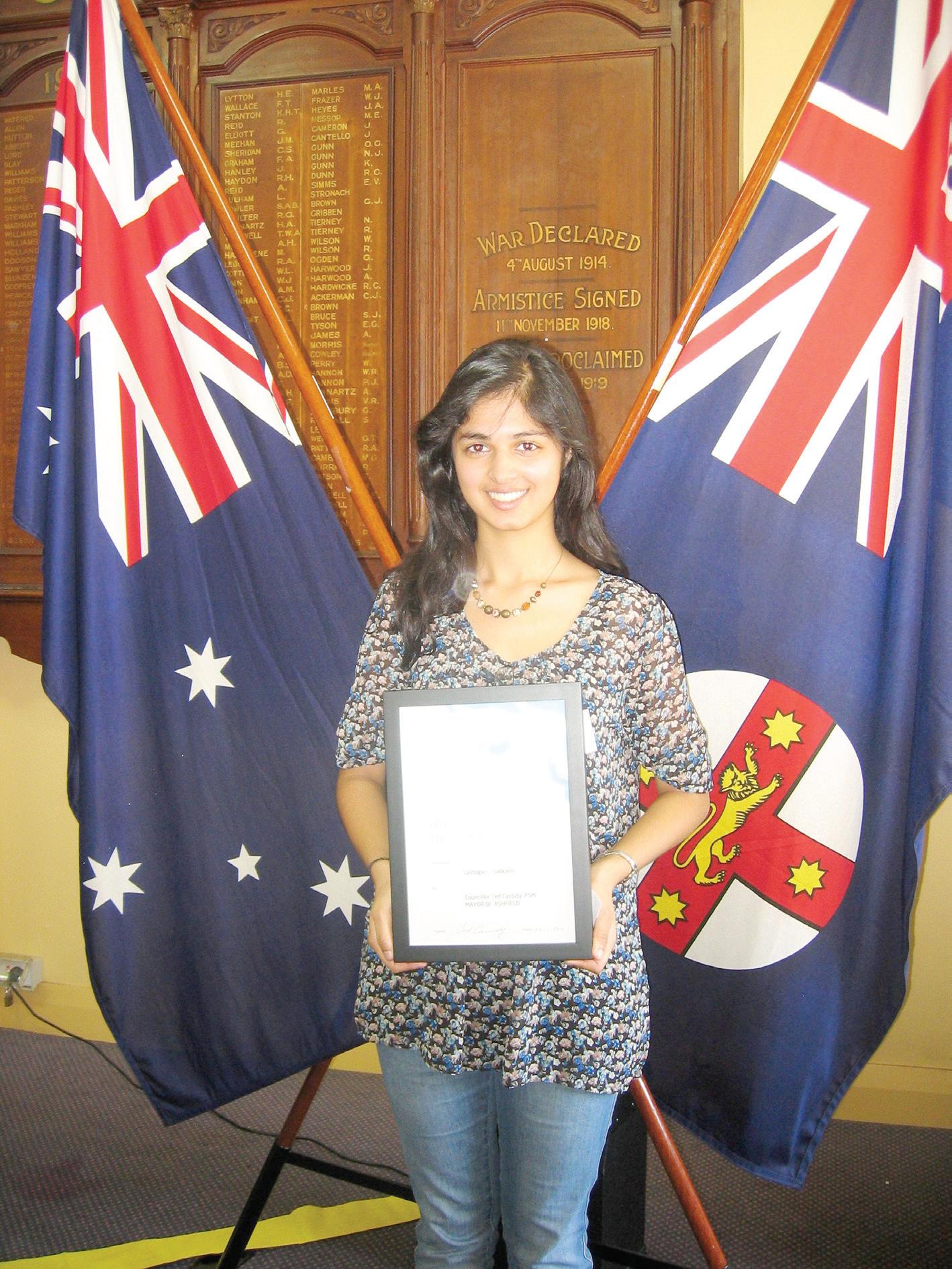
Empowering the youth

environmental initiative, and advised the council on its Street Entertainment Policy and Reconciliation Action Plan,” revealed Lalitagauri. She cited an example of the Council Graffiti Committee, where the Youth Committee tried to not just prevent graffiti, but aimed at finding ways to engage the youth creatively. “I love the idea of having murals and street art, and getting young people involved in them is a good way to express themselves creatively in a legal way,” she said.
Lalitagauri’s inspiration has been the people she met while volunteering as part of the community service segment of completing the Duke of Edinburgh Bronze and Silver awards. She volunteered at Anglicare Burwood, the Ashfield library
Lalitagauri’s involvement in the Ashfield Youth Committee, though since less than a year, has been impressive enough to bring her this honour. This young achiever has been instrumental in petitioning the Council to have a youth representative on each of its Standing/Advisory Committees like the Library, Environment and Community Services committees. “If the youth are not part of the process of policy-making but are only involved in giving feedback after the policy has been implemented, it is a bit harder to implement any change,” says Lalitagauri. “After attending the Shift This 2010 Youth Leadership Conference, it occurred to me that it was important for local government to consider the youth perspective early on. That way, we can provide input while policies are being formed instead of afterwards, and I suggested that we should be given voting power so our opinion has a definitive impact.”
Lalitagauri or Gauri as she is popularly

called, was born in Mumbai, India and moved to Sydney with her family when she was 2. Her mother is a microbiologist and her father is an architect. Her older brother is doing a degree in Commerce, but this Year 12 student of Sydney Girls High School wishes to be a psychiatrist. She says, “I really like to keep up my activities even when doing my HSC.
So I am continuing to learn the clarinet, play
basketball and work on the youth committee. It is a productive way to have down time!”
Over the past year the Ashfield Youth Committee (AYC) has been involved in many activities. “The AYC organised a How to Land Your First Job workshop to teach young people CV writing and interview skills, provided input to the Greenway team on how to engage young people in their great
and has been a netball umpire. “People who volunteer showed me how rewarding the experience can be. It is also incredibly enjoyable. My supervisor at Anglicare was amazing in the way she dealt with people. She was so incredibly warm with even total strangers and that was very inspiring,” said the young woman.
Lalitagauri’s family visits India often, and on being asked what she perceives to be the difference in growing up in India and here, she replied, “Each lifestyle has its merits and its demerits. I wouldn’t have the opportunity to engage in so many activities while growing up there as I do here, but at the same time there is so much life and buzz in Mumbai, people are well connected to family and culturally. I feel at home in India, but Sydney is also my home. My cousins wouldn’t swap their life for anything, and neither would I!”
A very balanced and responsible head on young shoulders indeed!
FEBRUARY (1) 2011 <> 15 NATIONAL EDITION COVERSTORY
www.indianlink.com.au
“If the youth are not part of the process of policy-making but only involved in giving feedback after the policy has been implemented, it is a bit harder to implement any change”
“I love the idea of having murals and street art, and getting young people involved in them is a good way to express themselves creatively in a legal way”
Nadkarni is
of the Year • Fine dining Indian restaurant located in Eastern Sydney • Cover up to 15 suburbs with no competition • Very good location 4-5 min from Maroubra and Coogee Beach • 50 plus seater with 3 bedroom apartment upstairs • Fully licensed and B.Y.O, with plenty home deliveries, takeaways and plenty free parking • Great food reviews from customers online Indian Restaurant for Sale Please call: 0433 552 122 or 0433 195 344
Lalitagauri
Ashfield Council’s Young Citizen
Remembering the home country on Republic Day
The 62nd Indian Republic Day was celebrated with grandeur this year at the home of the Consul General of India (Sydney) Amit Dasgupta.
The festivities began at 9 o’clock sharp, with the flag hoisting getting a round of applause from the guests. The Consul General hoisted the national tricolour and led the gathering in the singing of India’s national anthem. There was a special vibe running through the 500-strong crowd, as the guests sang Jana Gana Mana with pride.
Mr. Dasgupta then read out the message of the President of India Pratibha Patil, to the nation on the occasion. The president has called for changes to deal with corruption in order for development and good governance to take place. She also pointed to terrorism and labelled it ‘the single most detrimental threat to the progress of humankind’, and pledged India’s commitment to combat this threat as part of its role as a nonpermanent member of the UN Security Council. Highlighting the need for programs for women, the youth, girls, marginalised sections of society and people with disabilities, she stressed that opportunities need to be made available to them to allow them to flourish to their fullest.
The President also made note of the recurrent interruptions to Parliament proceedings, which could impinge on people’s faith in democratic institutions.
About the Consulate General in Sydney Mr. Dasgupta reassured everyone that it hopes to achieve more in 2011 than it did in 2010. He also paused to remember
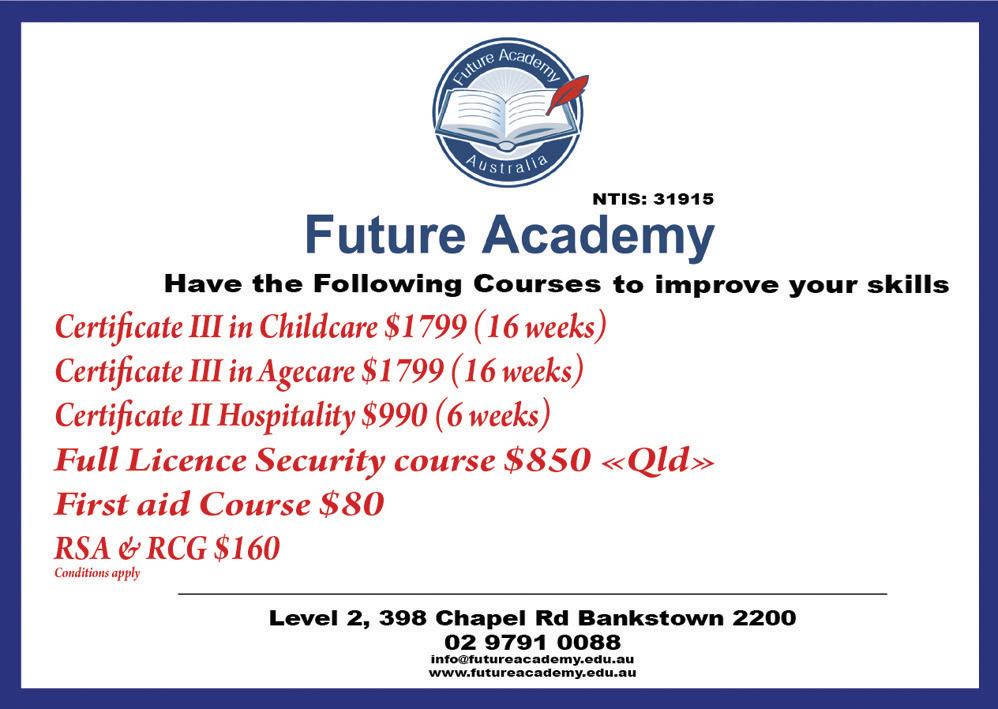

the victims of the devastating Queensland floods with the reconstruction of the economy and lost homes.
“It is tragedy that brings people together on the strength of humanity and, I would say, brotherhood,” he said.
Mr. Dasgupta hoped that the youth in the Indian community would continue to participate in events of significance to their mother country.
“I hope they don’t lose links with their mother country. I hope they don’t forget that Indianness is something that they can take with them wherever they are, irrespective of whether they have a passport of another country; it’s something integral to them and they should take that with a sense of pride and dignity.”
For Padmanabhan Karamil, President of the Sydney Malayalee Association, who was present at the occasion, the Indian national anthem brings back special memories of the homeland.
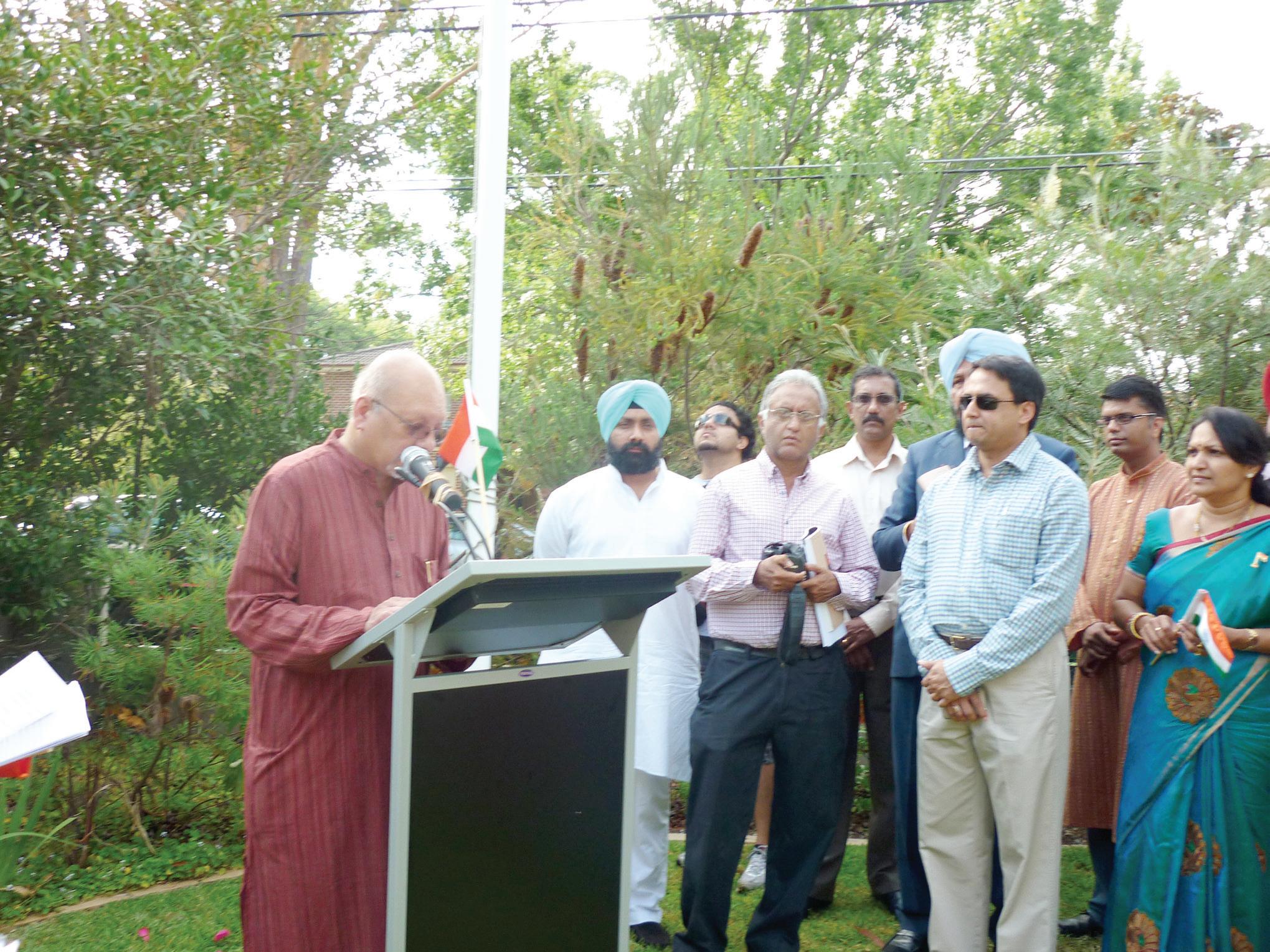
“It’s very nostalgic,” he said. “And it made me very, very thrilled to sing it here today”.
United Indian Associations President Aruna Chandrala, noted that for ex-pat Indians here, celebrating Republic Day in Australia also meant celebrating Australia Day. While the former is a celebration of the motherland, the latter is a celebration of the adopted land and this is the opportunity to give thanks to this adopted land, she said.

16 <> FEBRUARY (1) 2011 INDIAN LINK
www.indianlink.com.au COMMUNITYSCENE
Malavika Santhebennur
Suite 2, Level 2, 398 Chapel Rd, Bankstown NSW 2200 Mob. 0416 000 222 Ph. 1300 827 188 info@futureacademy.edu.au www.futureacademy.edu.au Super special offer Hurry seats are limited (give them an opportunity to get a job in this field ) We do speak Indian Certificate III in Children services $ 995.00 Certificate III in Aged Care $ 995.00 First Aid $100.00 RSA & RCG $ 150.00 ( for both) Liquor Business for Sale • Sydney Western Area • Weekly Turnover $18,000 + • Outstanding Opportunity • Great profit margin • High Density Residential Area • Ample Parking • 3+5+5 Years Lease • Asking $ 350,000+ STOCK Contact on 0403 493 824
If you are a student looking to settle down permanently in Australia, or have any other visa requirements, look no further than Australian Visa & Migration Consultancy Services. We know your problems and challenges. We also know ways to succeed and save you time and money. We are a team of ex-students with over 15 years experience, so you are in good hands at AVMCS. 95

Fax: 02 98912872
email: info@avmcs.com.au

FEBRUARY (1) 2011 <> 17 NATIONAL EDITION
Wigram Street, Harris Park, NSW 2150 Tel: 02 98939606
delay, call us today on 02 9893 9606 Contact Sanjay Deshwal on 02 98939606 or 0412 462 344
3 MINUTES FROM HARRISSTATION!PARK
web: www.avmcs.com.au Don’t
JUST
New organisation arrives with a bang
It’s heavyweights galore at the maiden event of the newly launched Council of Indian Australians (CIA)
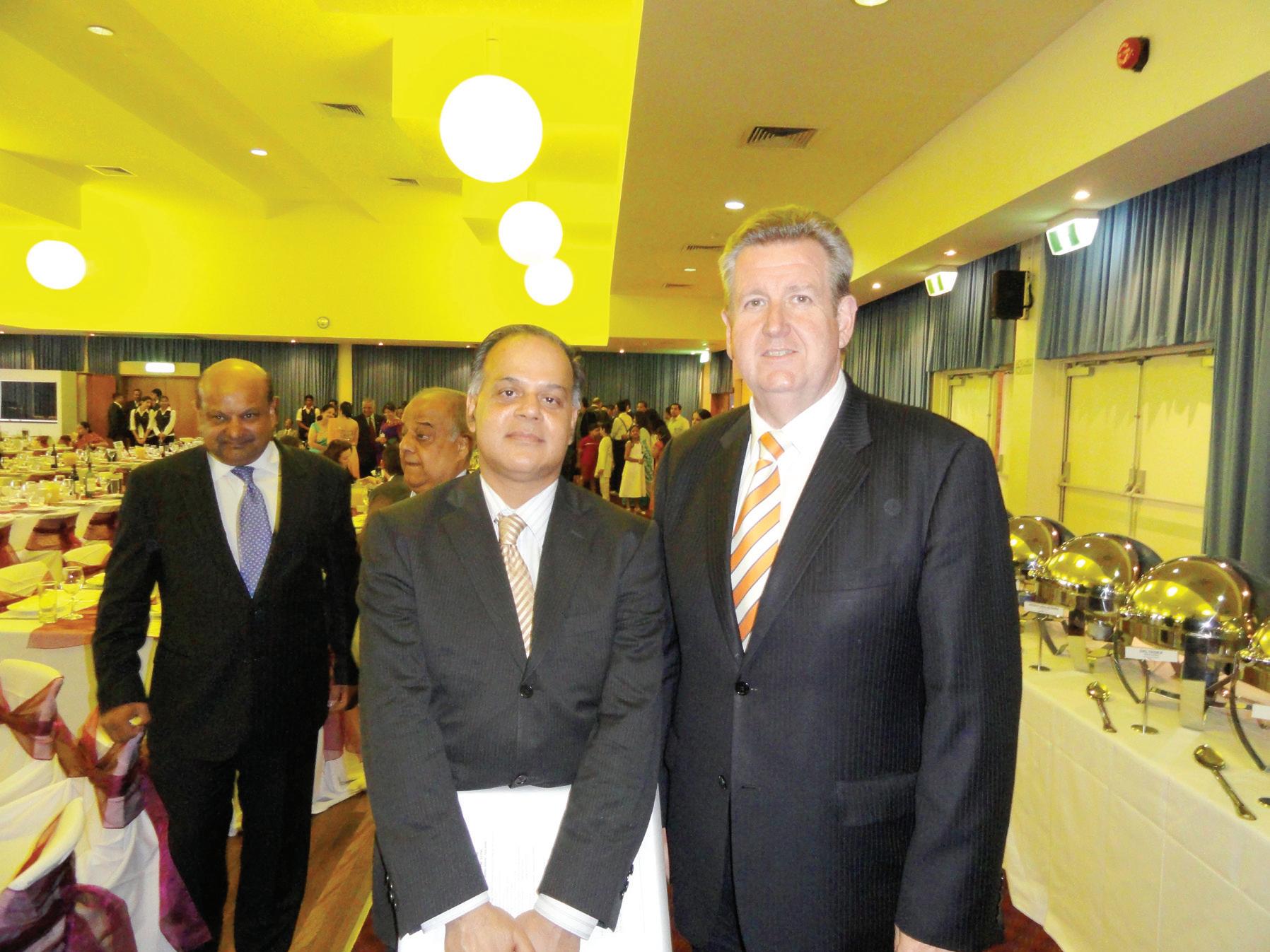 BY PAWAN LUTHRA
BY PAWAN LUTHRA
If it was meant to display its growing strength, the new organisation Council of Indian Australians’ (CIA) celebration of Australia Day and India’s Republic Day, certainly achieved its objective. At Blacktown’s Bowman Hall, the room was filled with over 500 cheering Indian Australians as they enjoyed an evening of camaraderie, celebrations, and a touch of patriotism interspersed with speeches from diplomats and top politicians.
Local Indian Australian Yadu Singh is not a man known for his modesty. His zeal to move the Indian community forward in NSW is well-known. Also well-known are his views of the existing Indian organisation United Indian Association (UIA) - his criticism of them revolving around issues of transparency and accountability. It was no surprise that the newly founded Council of Indian Australians of which Dr Yadu Singh is President, has as its creed “integrity, accountability and good governance”.
The evening was organised in the backdrop of Queensland floods and the forthcoming State elections. Both were acknowledged during the course of the evening which started about an hour behind schedule as the main guests scrambled to get to the venue on a Friday evening. Entertainment by local artists set the pace of the evening, helped along by MC Lucky Singh.
It was a who’s who of State politicians who were present: Premier Keneally decided to dress Indian for the occasion, looking like a Bollywood actress in her beautiful summery salwar kameez. State Labor members included Peter Primrose, John Robertson, Barbara Perry, Paul Lynch, and Amanda Fazio while from the Federal side of Labor, Michelle Rowland and Laurie Ferguson were present. The Liberal party has represented by the leader of the opposition, Barry O’Farrell, Gladys Berejiklian, David Clarke, Stuart Ayers and Ray Johnson. Mayors and councillors from various local councils were also present.

With elections just weeks away, State politicians were keen to be seen by an increasingly large voting block, that of Indians Australians. While State Labor seems to have lost favour with the local public as per the latest polls, the Coalition is looking to romp in. Sensing this, it was interesting to note the Labor party clustered one table and the Liberal party strategically scattered around the five hundred people there.
Other than the celebrations of the day, the speeches by the chief guests were well delivered. Starting off, Dr Singh introduced CIA not only to the dignitaries present but also to the Indian community at large. “As we reach 100,000 in numbers in NSW, let’s acknowledge that we have new people and new problems in our midst. It follows therefore that we need new leadership”.
He went on to detail the work he himself has done to help Indian international students,
which he claimed he did selflessly, seeking no personal gratification in the press or otherwise. “We will put community interests first”.
Michelle Rowland, speaking on behalf of Prime Minister Julia Gillard, detailed the growing relationships between India and Australia. Marise Payne representing the Leader of the Opposition Tony Abott, mentioned more personal contacts, such as her in-depth discussions with Indian leader Rahul Gandhi. In her flawlessly delivered speech, Kristina Keneally spoke of the Indian presence in our state, whether in the banking sector in the Sydney CBD, IT in Parramatta, mining in the Illawarra, agriculture in Riverina, in the entertainment scene (AR Rahman at Sydney Festival), or in the arts scene (Parramasala).
Barry O’Farrell picked up cleverly on Yadu Singh’s “new leadership” dig at UIA, and turned it into his own. “Your comment brought a smile to my lips,” he said tonguein-cheek at the start of his speech, looking squarely at the Premier as she chose that very moment to leave the function. He went on to make an equally strong speech, going back 222 years and claiming Indian links to the start of modern Australia in terms of the made-inIndia ships that brought the first settlers here, and the Indians he has met whose ancestors came here 100 years ago. And then he came straight on to electioneering mode. “You come here for better opportunities, but if the systems are not adequate here - transport, roads, hospitals, schools - it will affect those very opportunities”.
If the pollies had intended to reach out to the Indian community at election time, they had all done their homework very well indeed!
of the Community Relations Commission and recently honoured with the AO, congratulated the community for its “coming of age” in the face of the students’ crisis of 2009. “You stood up to help the students here, and also defended Australia in the face of rampant criticism back home. You had a role to play as bridge builders, and you came through with flying colours”.
(Sydney) Amit Dasgupta admitted 2009 is a year he’d like to forget, but claimed 2010 was a good year. 2011, he hoped, will be “fantastic”, thanks to a number of new initiatives, a major one being the cultural centre being set up in Sydney at the Consulate’s new offices. “The formal institution of two Chairs – Tagore Chair at Macquarie University’s IRC and the Rajiv Gandhi Chair at UTS – are equally exciting, and we hope to have a third Nehru Chair at Sydney University soon,” he said, adding, “We are pleased to note that Australia sees the possibility of building long-term relationships in terms of academic work”.

CIA also took the opportunity of honouring a community member Dr. Chandrashekhar Gowda, a medical practitioner with many years of selfless social work both here and in India.
As the formal part of the evening concluded, it was time for giving something back to the people of Australia. A sum of over $7,100 was raised in donations to the Queensland Flood Relief Fund, largely from
a filling part of the end of an evening of celebration.
CIA has done well in organising and presenting a function of this magnitude as its maiden public event. The team of Yadu Singh, Stanley D’Cruz, Keyser Joshi and Subba Rao Varigonda along with Praful Desai, Mark Sharma, Tony Colaca, Ajay Ghosh, Gautam Raghunath and Shailendra Wadhva have hit the ground running in their endeavour to serve the local community. It will be interesting to see their future plans unfolding and whether they will be successful in complementing other well wishers of the community in an open, accountable and transparent manner.
For more details on CIA, visit their website www.cia.org.au
18 <> FEBRUARY (1) 2011 INDIAN LINK
www.indianlink.com.au COMMUNITYSCENE
Premier Kristina Keneally and Leader of the Opposition Barry O’Farrell both reach out to the Indian community at the CIA function

FEBRUARY (1) 2011 <> 19 NATIONAL EDITION
Gee, to be on ZEE…!
Sydney girl Divya Dhingra makes her debut on Indian TV

 BY MALAVIKA SANTHEBENNUR
BY MALAVIKA SANTHEBENNUR
Imagine this scenario. You go back home to India for a brief holiday. You’re on a break from your IT job in Sydney and just want to chill: catch up with the cousins, go shopping… Yet when you return only a few weeks later, a glamorous new career, that too in the cut-throat word of Indian TV, is at your fingertips. Stuff of dreams?
For full-time Oracle employee and parttime MBS student Divya Dhingra, dreams have a habit of coming true. One such
“Yes, it was like a dream come true,” laughs Divya, who beat hundreds of girls to win the role of anchor. “Working so closely with one of the top stars of the music industry there, and that too for a TV show, was just unbelievable!”
The petite Strathfield girl is not new to the stage. Sydney’s Indian community has seen her do the MC role many times, even performing on stage at many functions. At a recent Kavi Sammelan (poets’ meet) in Sydney, she not only hosted the show but also presented her own work, which she wrote as a tribute to her dad on Father’s Day.

The opportunity to go international came when she chanced upon a billboard in
interest, and she decided to audition.
“It was totally unexpected,” Divya recalls. “Dad was like, ‘Div, let’s give it a go’. I was like, ‘I don’t know…’ But then I thought, why not? At the auditions, there was a long queue of girls, all dressed up in their heavy lehengas and saris - I was in a simple dress!”
Audition was an arduous and exhausting eight-hour day. “Many of the girls were born and brought up in India, and others had flown in from places like London just to audition for this role”.
There were various rounds - interviews, screen tests and written tests.
“First round, we met the judges individually. They asked me about prior experience, and what I want from the future and stuff, so it was just a basic interview. Second round, was screen tests and voice modulators, and then a written exam, in which we had to write an opening speech to introduce Malkit Singh. I wrote it with the audience in mind, but also allowing my own personality to shine through. Next, the judges gave us the title of one of Malkit Singh’s songs, and we had to introduce the song in a way that incorporated the theme and title of the song. We got fifteen minutes to write. Then one by one, we got up on the stage under the spotlight and the video cameras, and presented it the judges and the other girls”.
Divya came through each round with flying colours. Her confidence and poise won over the judges just as much as her flair for language, her oratory and poetry. “There were times when everything was falling so perfectly in place at every stage, at every audition round and every interview I gave, that at times I doubted if it was all a dream.”
Meanwhile, a male anchor had been selected through the very same process.
“But that was just the beginning,” Divya recounts. “Because then it was time for rehearsals - there were rehearsals galore - dress rehearsals,
venue rehearsals, video camera rehearsals, voice recorder/audio rehearsals and repeated script rehearsals”.
It was going to be a four-hour show, broadcast live across the country from the capital’s famed Siri Fort auditorium.


“And that just put extra pressure on us as the hosts because we had to get absolutely everything right in the first go.”
Spontaneity was the call of the day, and so there were no teleprompters on the night of the concert, as this would have hampered the anchors from moving around the stage and talking to the audience. Other than basic facts such as the artist’s songs and sponsor information being scripted, Divya and her co-host had to improvise the rest.
Divya also wrote a speech and composed poetry in pure Hindi to introduce the guest of honour, Delhi Chief Minister Sheila Dixit, to the 4000-strong audience. It turned out to be a winner. Even Malkit Singh stopped to appreciate her efforts, noting that it was heartening to see a ‘pravasi bharatiya’ (NRI) take such pride in her language.
Divya loved every minute of it. She also got to experience the glamour of it all, as top costume designers dressed her up with exclusive clothes, jewellery and shoes, which she got to keep. She also received adulation from the audience.
“I was swarmed afterwards. Everyone was like ‘can I have a photograph please?’ It was amazing. I was signing autographs on tickets, pieces of paper, even bare hands!”
As she sits back in her office at Oracle now, absorbing what has been, she feels the doors are open.
“What I learnt is, to take a leap of faith in yourself and seize the opportunity, because you never know what doors it will lead you to. The truth is, opportunities do not come with their values stamped on them. I really believe it now, because I had no idea how big the ZEE event was going to be!”
So has the world’s biggest entertainment industry come back with any more offers?
Divya won’t give a firm answer just yet, and will only smile knowingly.
20 <> FEBRUARY (1) 2011 INDIAN LINK
Sydney girl Divya.
www.indianlink.com.au STAGE
Pehli nazar mein, aisa jadoo kar diya
ANJALI SHARMA sang along with others in the audience at Atif Aslam’s Sydney concert
Temperatures were soaring as the crowds lined up at the Sydney Olympic Park Sports Centre - and not just because it was a hot summer’s day.
They were there for Atif Aslam, the Pakistan-born pop singer who has taken the subcontinent by storm. They lined up patiently in the sweltering heat, just tere liye, mate.
In fact, one large enthusiastic mob in the queue even regaled others with an impromptu rendition of that huge Atif hit Tere liye, just to show off their fervour.
Atif Aslam is part of a new breed of singers that is changing the entertainment industry in India. He splashed on to the music scene in Pakistan in 2004, and within a year, was invited across the border to sing playback for Bollywood films. With his very first number Woh lamhey (Zeher) Atif made his mark, joining other contemporary singers like KK, Shaan and Kunal Ganjawala in creating that new sound that has come to dominate Hindi film music.

Atif’s entry on to the stage was by zip line, but unlike Hugh Jackman, he executed it to perfection
The new kids on the block are like a breath of fresh air - so different from the genre which held the fray for decades before. With their youthful energy and rock influence, they have expanded the boundaries of their art. And they love to perform – even show off –on stage. But this is no grunge: their lyrics are still deep and meaningful, soulful even, and their tunes still supremely hummable. They have made Mukesh, Kishore and Rafi, the greats of a well and truly bygone era.
Of these new artistes, Atif Aslam stands out with his particular style of music. His unique voice-belting technique conveys emotions so passionately that he leaves the young maidens crying out for more. Of course his film-star good looks help just as much…
It is no wonder that Aslam sold out a stadium full of seats at Sydney.
But wish the organisers (Amin Events) had heard the fans in the queue singing Tere liye. And they could not have missed the army of voices screaming ‘Atif Atif’ inside the venue…. the show was scheduled to begin at 7.00 pm, and it was already 8.30.
Still, when Atif finally came on stage and started off with Woh lamhey, it was as if he was telling them to forget and forgive woh scorching lamhey of intezaar. And of course they did!
(Atif’s grand entry was by way of zip line, flying on to the stage amidst cheers, rather like Hugh Jackman during that ill-fated entry onto Oprah Winfrey’s Opera House stage. Unlike Jackman, though, this cricketer-turned-singer made no mistake in applying the brakes at the
NATIONAL EDITION
www.indianlink.com.au STAGE



22 <> FEBRUARY (1) 2011 INDIAN LINK

FEBRUARY (1) 2011 <> 23 NATIONAL EDITION
Special prayers for Qld flood victims
The recent floods in the state of Queensland had devastating impact causing loss of life, destroying thousands of homes and impacting many families and communities.

In the aftermath of this calamity, the young children of BAPS Shri Swaminarayan Mandir, Sydney held special prayers on 29 January 2011 for those affected. Over 80 children in attendance joined in prayer for all those who lost their lives, were injured or suffered loss as a result of the floods, and for peace and normalcy to be restored as soon as possible.



Such prayers are able to offer comfort and support in a lasting and meaningful way. Through their involvement in such a prayer, the children also learnt how to empathise with the difficulties of others.
BAPS in Australia and worldwide continue to pray and offer support for those affected by the floods. For more information on BAPS visit www.baps.org
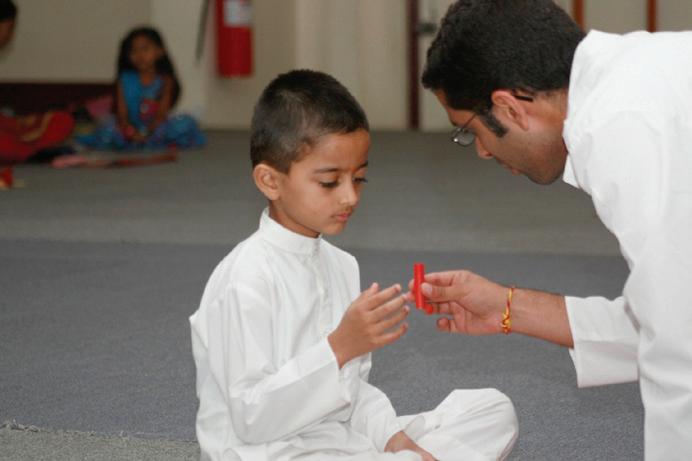
24 <> FEBRUARY (1) 2011 INDIAN LINK
www.indianlink.com.au COMMUNITYSCENE

FEBRUARY (1) 2011 <> 25 NATIONAL EDITION
They now call Aus

Melbourne’s Australia Day parade is a huge success, reflecting the multicultural and harmonious pulse of this nation
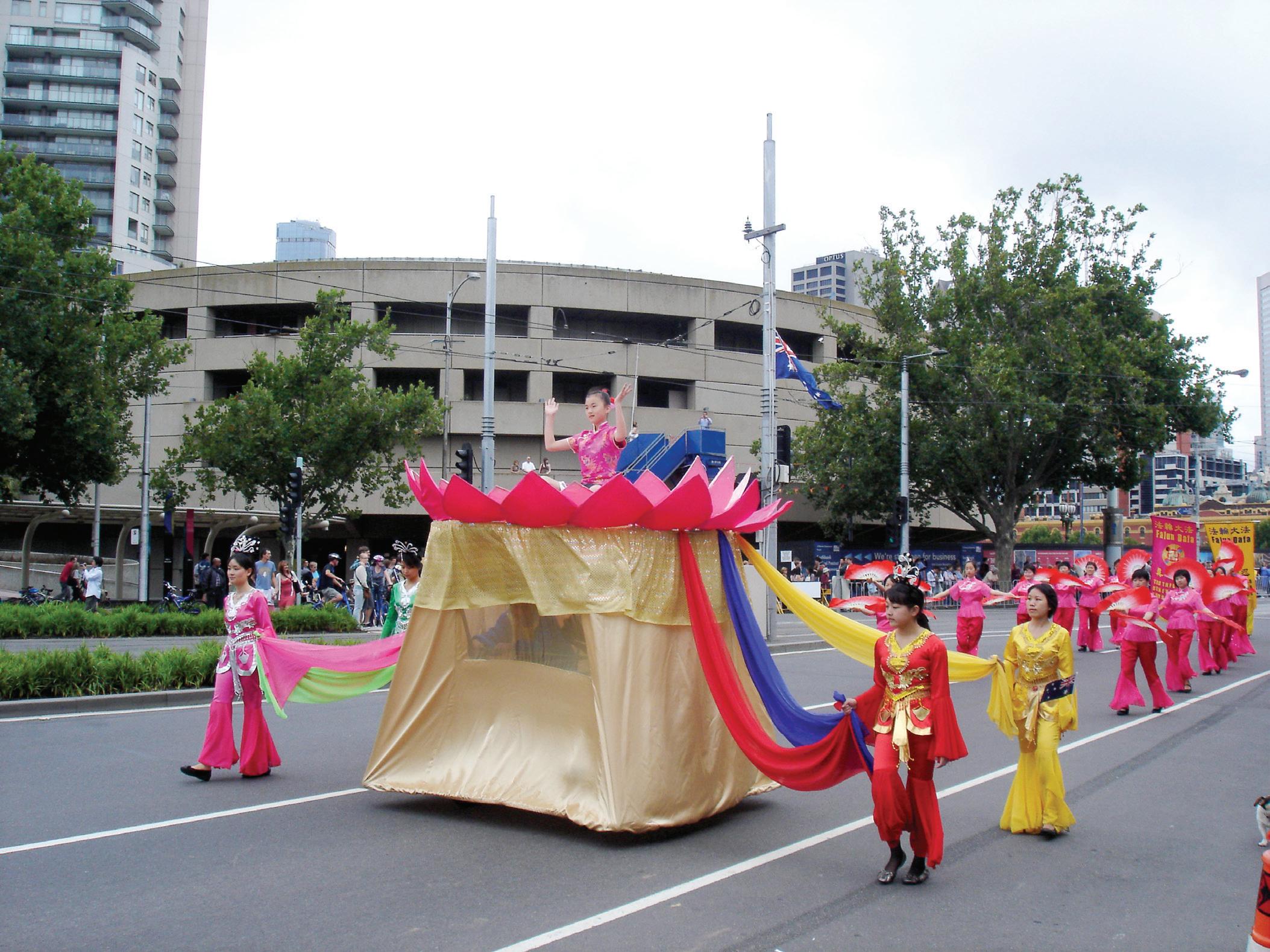
 BY TIM BLIGHT
BY TIM BLIGHT
Indians in Australia, of course, have two reasons to celebrate on January 26, as the day marks both Australia Day and India’s Republic Day. The centre of Melbourne came to a standstill with sections of Swanston Street and St Kilda Road closed for a parade of cultures. The day began with a military parade and presentation at the Melbourne Town Hall, before the procession turned and headed towards the Kings Domain Gardens on the CBD’s southern fringe. The military parade was followed by an extensive and colourful ‘parade of nations’, with up to fifty different nations, religious groups and support networks taking part.
The Indian contingent of the parade was represented by FIAV (Federation of Indian Associations of Victoria). This umbrella organisation coordinated the combined effort which featured FIWAA (Federation of Indian Women’s Associations of Australia), VIBC (Victoria Indian Business Council), AIBCV (Australia India Business Council Victoria) and FIMDV (Federation of Indian Music & Dance Victoria). Dressed in vibrant saris and kurtas, the large Indian group marched about midway through the parade proudly carrying both Australian ensign and the tiranga. Those marching came from a wide variety of backgrounds; north, south, east, west, Hindu,

Muslim, Christian, Parsi and Buddhist. The fact that so many cultures could be represented as just a sample of the Indian community, is testament to the rich cultural heritage of India which was equally celebrated as part of Australia Day.

Following closely behind the ‘Victorian Indian Community’ was a separate entry from the Sikh Council of Victoria. In true north Indian style, the largely Punjabi crowd danced along the street in a mélange of vivid turbans, and churidar kurtas beating tablas and dhols. Other South Asian cultures were present, such as West Bengal and Bangladesh who were represented by the Western Region Bengali School, and the Hare Krishna Movement, with several western followers. The Sinhala Cultural and Community Services Foundation marched just before the Indian section, holding the Sri Lankan flag aloft with wide smiles. A large group from Pakistan marched together as the Australian Federation of Pakistan Organisations and the Shamama Association of Australia represented Afghanistan.

The fact that so many cultures could be represented as just a sample of the Indian community, is testament to the rich cultural heritage of India which was equally celebrated as part of Australia Day.
Hardip Madan, chairperson of the Sikh Welfare Council of Victoria, spoke of the importance of raising children with multicultural awareness. Her organization teaches the Punjabi
language to students, along with traditional dance and sport. Jasreen Banwait teaches some of the students, and proudly announced that only four weeks preparation had gone in to the Sikh Council’s exciting Australia Day display. Costumes had been generously organized by Ms Ajay Pal, while the dhol players were all volunteers, coordinated by Ms Madan’s son Richi who operates his own events company, Rhythm and Spice.
Further afield, the all-singing, all-dancing Filipino community was first to march, followed by kilted Scottish marchers and then the striking costumes of Australia’s neighbours, the Solomon Islands. Picture perfect Thai ladies came next with their male counterparts, some of whom wore seriously scary traditional Thai masks. Melbourne’s Turkish community waltzed along to music replete in red robes, although they couldn’t compete with the riot of colour represented by the Chinese community. Giant dragons, flags, hats and traditional costumes all contributed to make the Chinese entry one of the most memorable. Following them, the Falun Gong movement of China submitted a large gold float draped in spectacular bold ribbons and a complete marching band. More somber colours marked out the Lebanese entry, while the irrepressible Korean dancers and drummers kept the show going.
On a lighter note, Viking horns were worn by the group named “Danish (not pastry) people”, and “Slovaks in Australia”, the Sicilian and Macedonian communities continued the European theme. Buddhists and Muslims were represented by a group for their supra-national religions, while the Kurdish
26 <> FEBRUARY (1) 2011 INDIAN LINK
AUSTRALIADAY
tralia home
community represented a culture without a nation. Smiling and waving, Iranians, Burmese, Tibetans and Vietnamese marchers thanked Australia for their new home. Sponsored by RACV, vintage cars also featured in the parade, along with an over-thetop limousine which attracted hoards of youngsters, craning their neck to take a look. Noticeably absent was the Australian Aboriginal community, many of whom consider January 26 to be a day of mourning, not celebration.



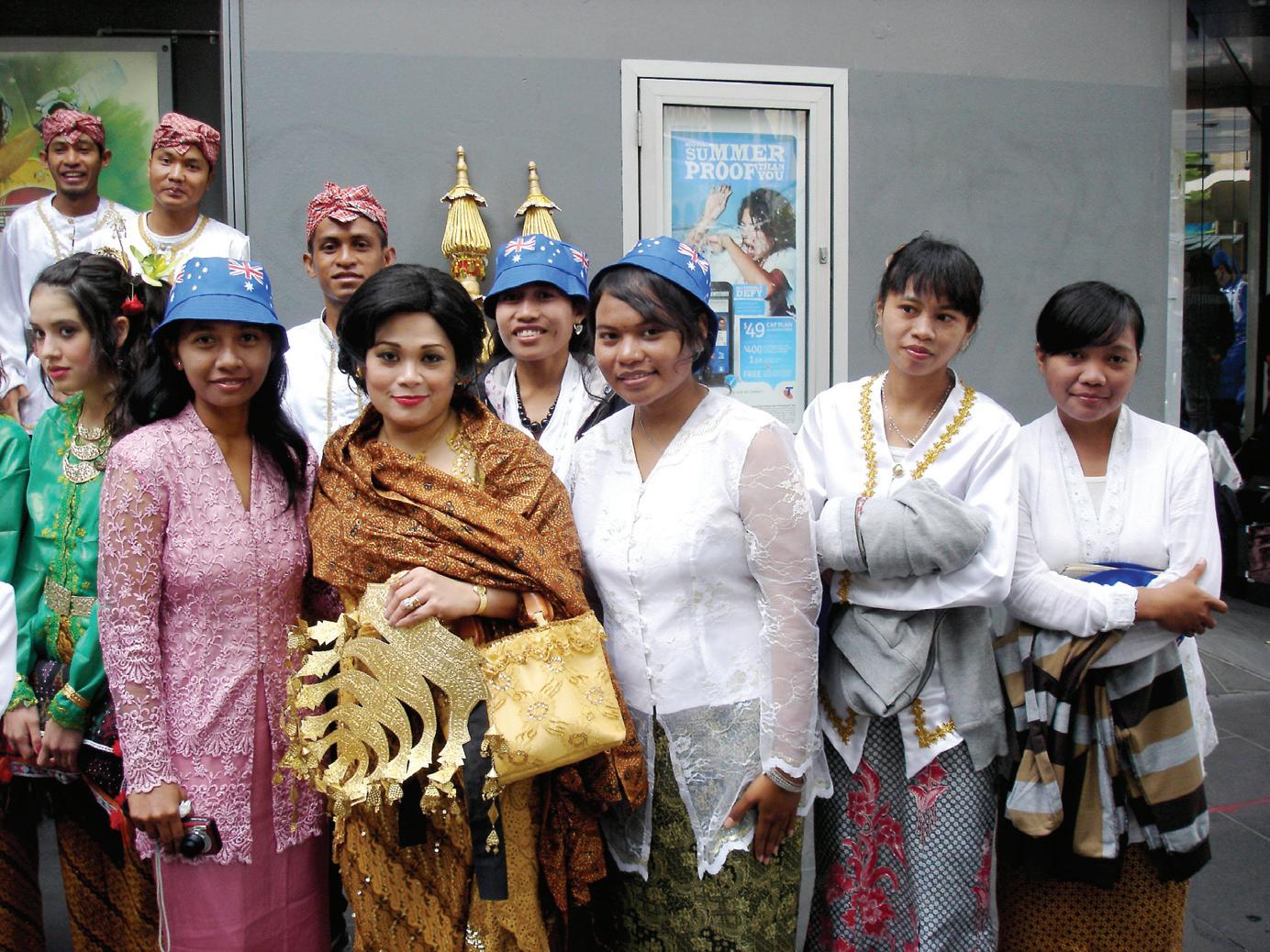

Once the parade reached the Kings Domain Gardens, a carnival atmosphere ensued with lunch served, amusements for families and several of the cultural groups settling in for a picnic. Most visible were the Indians, particularly the Sikh community, who broke out into dance with members of other groups joining in. In a heartwarming display of humanity, Indians of all backgrounds danced to the beat of the dhol, along with Sri Lankans, Bengalis, Pakistanis and members of the Slovak, Scottish, Anglo-Australian and Danish communities. Meanwhile, nearby, the Hare Krishna movement spread the love with their irreverent dance and costume, inviting all who dared to join in. Those who were invited broke away to join a lunch at the Indian Consul General’s office.
Wandering around the gardens after the parade offered many an opportunity to reflect on their place in Australia. Kirandeep Kaur attended with her child, Sahed, and spoke of the positive style of government in Australia that has resulted in today’s modern nation. “It’s a harmonious society,” said Ms Kaur, who came to Australia from Delhi one and a half years ago. Asked whether she planned to stay in Australia, she smiled and
said, “I’m not sure!” adding that she still called India home. Marie Singh, an Anglo-Australian whose husband Kanwarjit is originally from India, could not heap enough praise on India and the Indian people. “It is a lovely country, and lovely people.” While they reside in Australia, they were celebrating both Australia and Republic Days. Marie, who requires the use of a wheelchair following an accident, looked at an emotional Kanwarjit and announced that she was determined to walk again.
In a heartwarming display of humanity, Indians of all backgrounds danced to the beat of the dhol, along with Sri Lankans, Bengalis, Pakistanis and members of the Slovak, Scottish, Anglo-Australian and Danish communities.




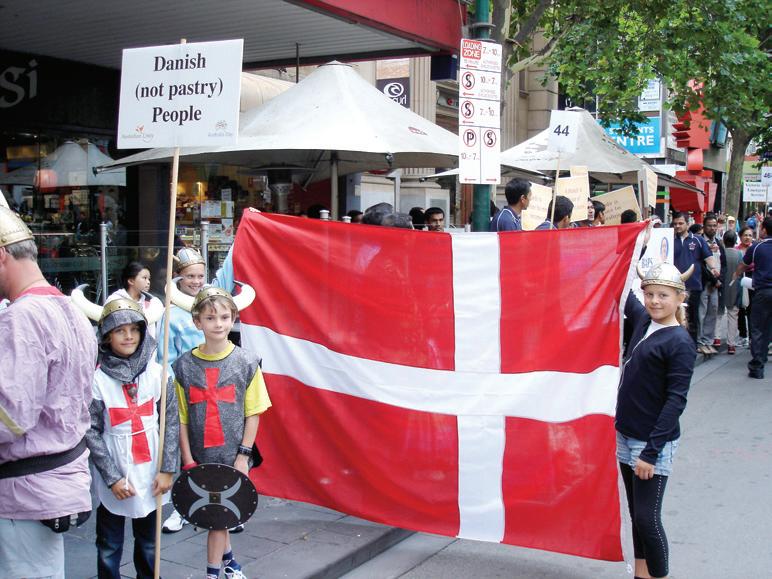
Neeraj and Aditi Kumar from Jamshedpur, Jharkhand, said that after two years in Australia they still didn’t feel completely at home, but they were certainly comfortable here. When asked what they liked most about life in Australia, the couple commented that it had provided them with opportunities that they would not have had back home. “The infrastructure and order allows more opportunities,” said Neeraj. Meanwhile Ramesh Kathirvelu of Chennai has been in Australia for three and a half years, and said that he feels at home. Also citing the
opportunities which life in Australia had presented him, he said that the most outstanding aspect of life in the country is the kindness of the people; “I’m really happy living here” he enthused. When asked about what Australia could improve, he claimed that the tax system is not necessarily fair, especially in relation to migrants.
Salima Abdul, of Dhaka, Bangladesh, said that she established herself in Australia quickly by meeting lots of people at her university. After eleven years here she now feels at home, and said that the South Asian community in Australia was important in making the transition. Raj Suresh who moved from Chennai to Australia nineteen years ago, said that he had seen major changes in the Australian Indian community in the time he had been here. “Absolutely, the population has increased, and awareness has increased in the wider community,” he said. When asked why he moved to Australia, the father of two echoed sentiments similar to others, citing “better opportunities”. “India and Australia are actually similar in some ways – so I felt at home very quickly,” he related. Celebrations were capped off with a fireworks display at Federation Square in the evening. In defining Australia Day, Indian Australian Raj Suresh makes an important point on unity. Perhaps the bigger picture of unity is defined by the smaller examples of it; while Australia Day and Republic Day being held on the same day is somewhat symbolic, it is even more symbolic that while both Australia and India are heterogeneous societies, both are examples of harmony in diversity.
FEBRUARY (1) 2011 <> 27 NATIONAL EDITION
1. Falun Dafa
2. Iranian Community
3. Turkish Community
4. Sicilian Community
5. Indonesian Community
6. Slovak Community
7. Korean Community
8. Danish Community
1 2 6 7 8 9 3 4 5
9. Filipino Community









28 <> FEBRUARY (1) 2011 INDIAN LINK Restaurant for Urgent Sale 80 Seater, Good Bar, Fully Licenced, Fully equipped, Nothing to Spend East Sydney Genuine Buyer Only (95,000 Negotiable) Please call on 0402 968 475 Indian Link Radio 24/7 Subscribe to Indian Link Radio for $9.95 each month. 24 hours, 7 days Indian Link Radio Minimum 12 months subcription, $50.00 refundable deposit




FEBRUARY (1) 2011 <> 29 NATIONAL EDITION Lowest Fee Guaranteed IELTS IELTS GURU Suite -1, 71 A Macquarie St, Parramatta, Phone 0411 520 546, 9687 9741 www.ieltsguru.com.au • Power Packed Sessions. • One and Two Weeks Crash Courses Available. • Money completely refundable, if not satisfied with the first tuition session. Unique Education and Migration Education Consultant (For Student Admissions) E-visa Facility Available

30 <> FEBRUARY (1) 2011 INDIAN LINK

FEBRUARY (1) 2011 <> 31 NATIONAL EDITION
Thank you for the food we eat…
The aroma of sweet rice wafted through the air… it was Pongal, Perth style!
The sight of dozens of pots with bubbling rice on crackling fires - with men and women stirring away with long ladles - must have made for a unique experience for those watching at the Hindu temple in Perth, on 15 Jan.

Was this some sort of Indian cook-out, or a camp dinner in the making?! It was, in fact, an ancient southern Indian ritual, to say, thank you for the food we eat. This was Pongal, a harvest festival of the farming community.
To symbolize a bountiful harvest, rice, milk and jaggery are cooked - in brand new pots - till they boil over. Some of the rituals performed in the temple include the preparation of rice, the chanting of prayers and the offering of vegetables, sugar cane and spices to the gods. Devotees then consume the offerings to exonerate themselves of past sins.
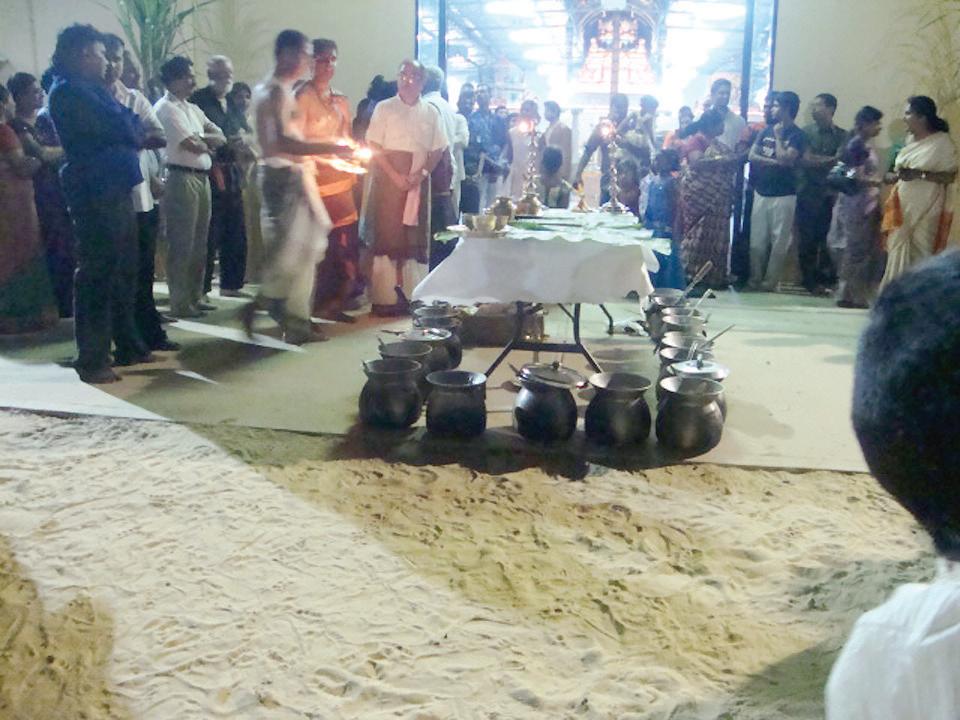
Pongal signals the end of the traditional farming season, giving farmers a break from their monotonous routine. Farmers also perform puja to some crops, signalling the end of the traditional farming season. It also sets the pace for a series of festivals to follow in a calendar year. In fact, four festivals are celebrated in Tamil Nadu for four consecutive days in that week. ‘Bogi’ is celebrated on January 13, ‘Pongal’ on Jan 14, ‘Maattuppongal’ on Jan 15, and ‘Thiruvalluvar Day’ on Jan 16. On Bogi, old clothes and materials are thrown away and fired, marking the beginning of a new life. The second day, the Pongal day, is celebrated by boiling fresh milk
early in the morning and allowing it to boil over the vessel - a tradition that is the literal translation for Pongal. People also prepare savouries and sweets, visit each other’s homes, and exchange greetings. The third day, Maattu Pongal, is meant to offer thanks to the cows and buffaloes, as they are used to plough the lands. On the last day, Kanum Pongal, people go out to picnic. A festival called Jalli kathu is held in Madurai, Tiruchirapalli and Tanjavur, all in Tamil Nadu, on this day. Bundles of money are tied to the horns of ferocious bulls which the villagers try to retrieve. Everyone joins in the community meal, at which the food is made of the freshly harvested grain. Originally a festival of the farming community, today Pongal is celebrated widely by all.
For the families gathered at the temple, it made for an enchanting evening of celebration in Perth as a rich cultural tradition found its way here. Devotees lent their strident, enthusiastic and passionate voices in song in praise of the lord. People especially children had come in their most colourful and beautiful traditional dresses. Once all the rituals were over, it was time to feast on some hot freshly prepared rice, sambar and sweet pongal.
The stars and the moon shone down bright, witnessing in a distant corner of Perth, a group of migrants and their families celebrating their culture proudly with passion and fervour, and adding in the process some more vibrant colour to the multicultural hues of Australia today.
Sai Narayan


32 <> FEBRUARY (1) 2011 INDIAN LINK
PERTH
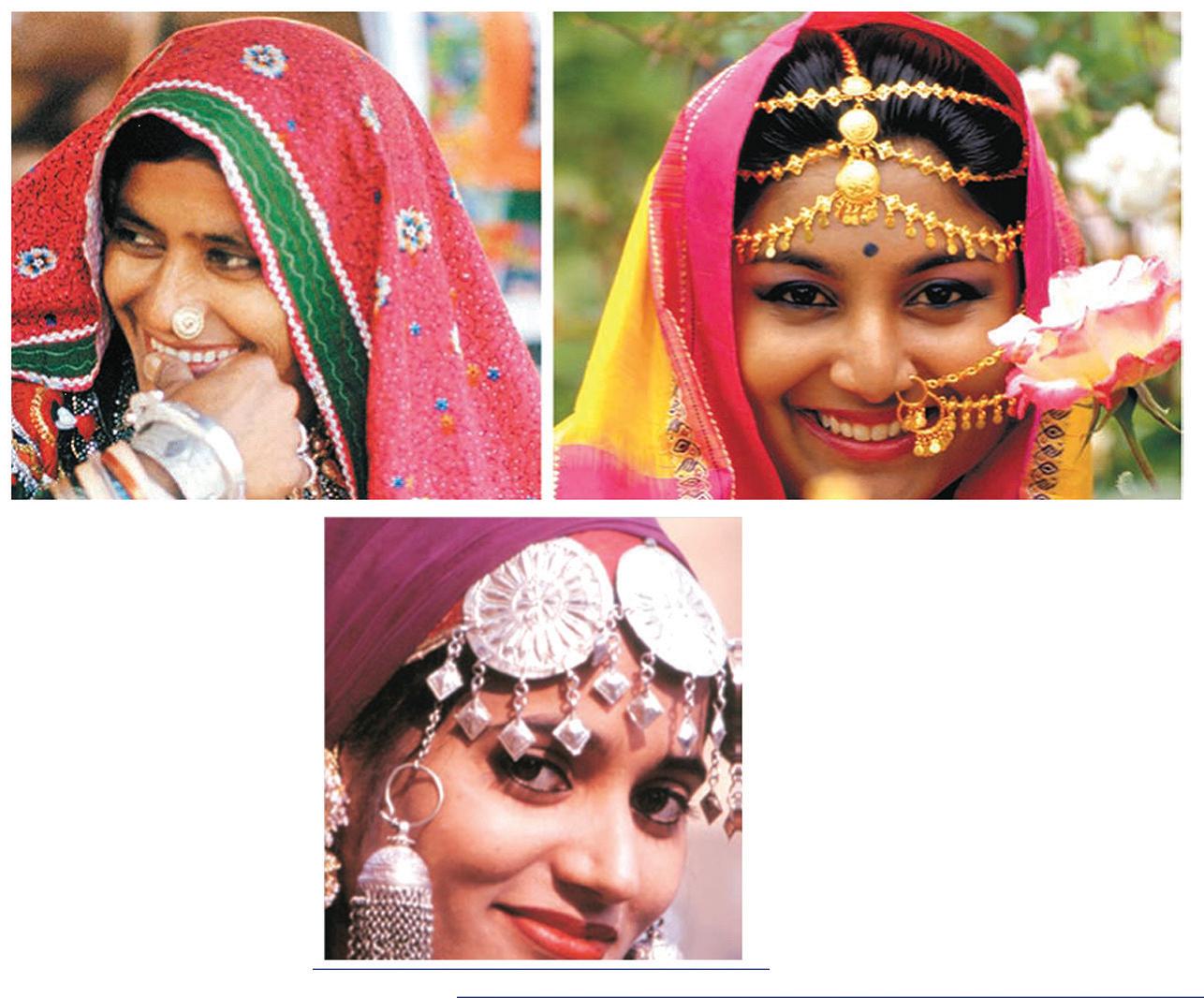




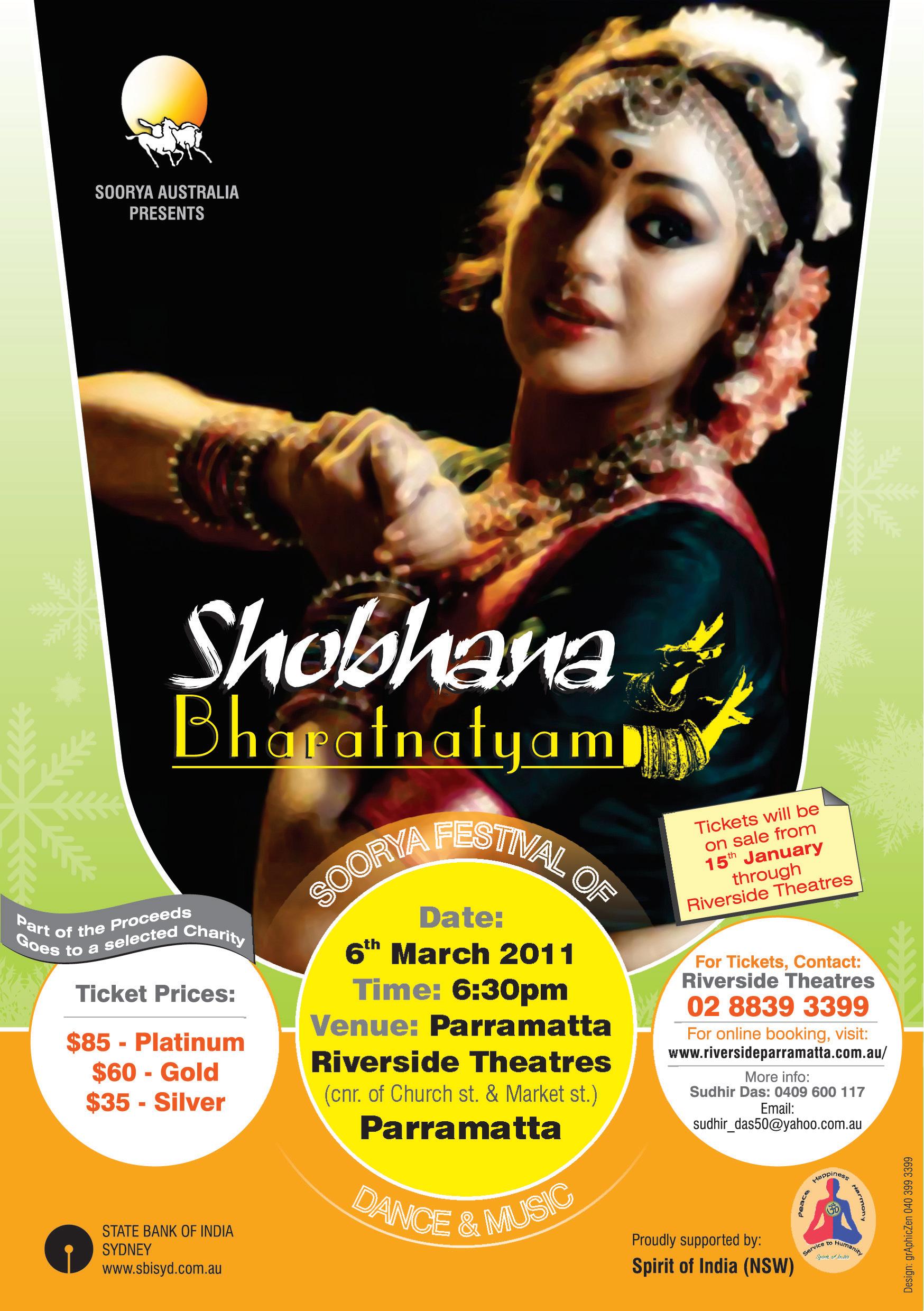
FEBRUARY (1) 2011 <> 33 NATIONAL EDITION Restaurant for sale/ commercial kitchen for lease Golden opportunity, do not miss it!! Call 0404 086 254 (genuine callers only) Well established Indian restaurant and take away for sale in Western suburbs. Excellent brand name with regular catering orders. Low overheads, will suit owner operator who wishes to maximise the growth potential. 5/32, York Street, Sydney, NSW 2000. Tel: (02) 9262 1661 Fax:(02) 9262 1217 Email: ram@ramworldtravel.com.au Web: www.ramworldtravel.com.au ONE STOP SHOP FOR: * Competitive international airfares to all parts of the world *Special airfares to Indian sub-continent *Package and tailor made tours to India and Nepal *Holiday packages to all parts of the world *Round the World Airfares *Hotel accommodation, car hire and guide services *Travel Insurance *DAILY DEPARTURE TOURS OF INDIA FROM: $975 P.P (ask for color brochure) “We always make our travel arrangements through Ram World Travel for its excellent service and best price!”

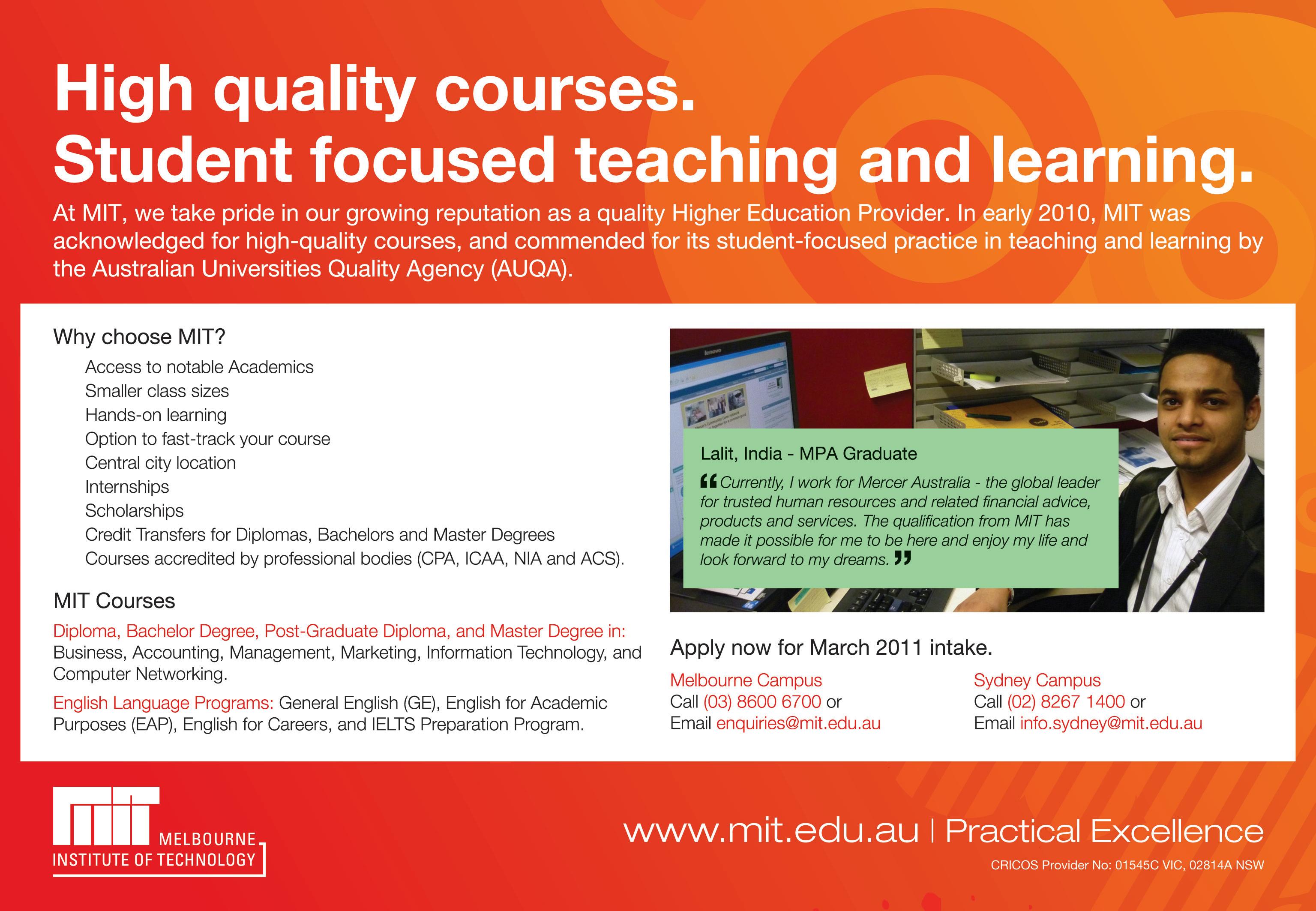
34 <> FEBRUARY (1) 2011 INDIAN LINK


FEBRUARY (1) 2011 <> 35 NATIONAL EDITION Singh Food and Spices Quantity Quality Service A spice shop with a difference Super Wednesday BULK Discount across the board on: Lintels Spices Ghees Atta & 5Kg Rice DVDS Pickles Papads Cosmetics Pooja items Sweets Hampers Frozen Items Snacks Tea/ coffee *Conditions Apply 143 Stephen Street (cnr Sackville Street), Blacktown Phone 02 9676 4677 Fax: 9676 4688 enquiry@singhfoodspices.com.au : www.indianspices.com.au Blacktown
Cultural as well as military might unfold at Republic Day parade
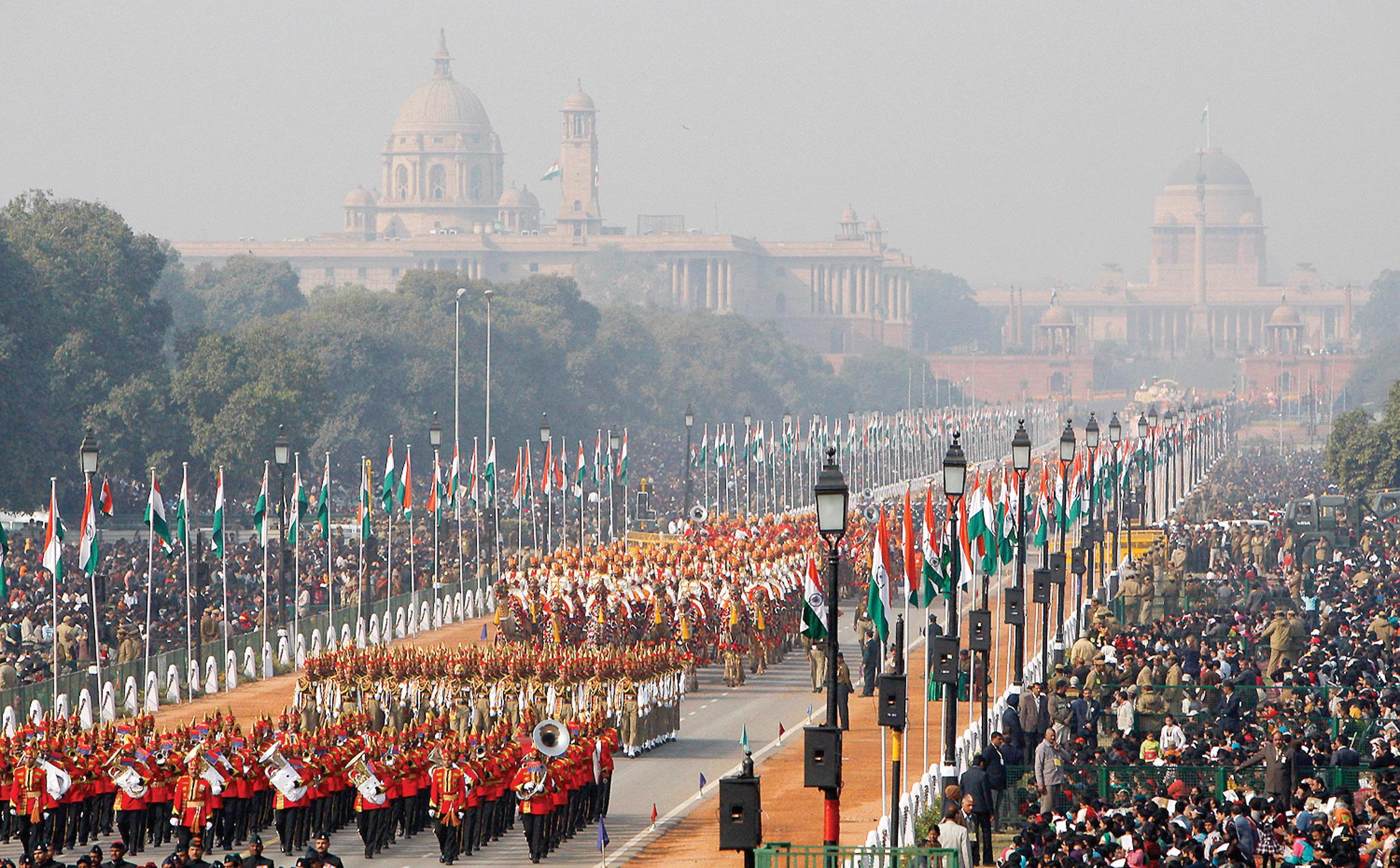
India celebrated its 62nd Republic Day on 26 Jan, displaying its military might and vibrant cultural diversity in a stunning parade down New Delhi’s Rajpath. The annual spectacle was witnessed by the country’s who’s who and tens of thousands of enthusiastic commoners on a grand boulevard in the heart of Delhi.
Among those who watched, were special guests Indonesian President Susilo Bambang Yudhoyono and his wife Ani Bambang Yudhoyono. Yudhoyono is the second Indonesian chief guest on the occasion after Sukarno who graced the event in 1950, on the very first Republic Day, when Rajendra Prasad was sworn in as the first president of independent India at the Irwin Stadium, now renamed National Stadium.
President Pratibha Patil, commander-inchief of the armed forces, took salute as military and paramilitary contingents.
As a bright sun shone down on the city, the country’s cultural and religious diversity was represented by folk artists and dancers on colourful tableaux.
Martial music from various military contingents -- including the ever popular Sare Jahan Se Achcha -- filled the air.
The parade
The event displayed indigenous military hardware. Taking centrestage and vying for attention were the new Light Combat Aircraft Tejas, T-90 main battle tank Bheeshma, BrahMos supersonic cruise missile, advance light helicopter Dhruv, armoured vehicles, multi-barrel rocket launcher Pinaka and a stateof-art radar.
The star was the two-seater Tejas aircraft, unveiled for the first time.
The tableaux unfolded a cultural spectacle from various parts of India -- from Jammu and Kashmir in the north to Kerala in the deep south.
The Kashmir tableau showcased the valley’s dying folk culture. The replica of a Sufi shrine, a hut carved in wood, a Chinar tree, folk
artists - a typical Kashmiri village came alive. With song, dance and drama, artists dressed in traditional clothes performed the Bhand Pather - Jammu and Kashmir’s folk theatre.
Be it Sufi traditions or Bidri art, India’s Islamic heritage was highlighted too. The Sufi shrine of Maner in Patna was depicted in the tableau of Bihar, which is better known for its Buddhist pilgrim sites.
As the tune of Amir Khusro’s Sufi verse Chhap tilak sab chhini re played in the background, the float showed the shrine of 17th century saint Makhdoom Shah Daulat at Maner.
Karnataka displayed Bidri-ware, a decorative art form which originated in Persia and was brought to India by the followers of Khwaja Moinuddin Chisti.
Gujarat is not so well known for its Buddhist connection, but that is what the state chose to highlight. The chants of Buddham sharanam gachhchaami filled the air. The tableau was a reproduction of a fourth century Buddha statue found in Dev-Ni-Mori, along with Buddhist ‘mudras’ (symbols) found at Vadnagar and a bust of Buddha in meditation.
Delhi portrayed its multi-religious culture. The iconic Bahai temple in the capital was the main motif while the tableau also showed Dusshera celebrations with an effigy of Ravana, and the famous Phool Walon Ki Sair festival, celebrated by Hindus and Muslims.
The Central Public Works Department float had giant flower sculptures of two tigers along with two cubs. The entire central boulevard resounded with the roar of the tiger, underlining the threat to the national animal. Only 1,400 of them roam the wild in the country today.
Poet-philosopher Rabindranath Tagore made an appearance not once, but twice - to the delight of leaders from West Bengal who were watching the floats roll by at the Republic Day Parade here.
A huge sculpture of Tagore rumbled past to the famous song Jodi tor dak shune, penned by the Nobel laureate.
Minutes later came the railway ministry tableau, again with a giant statue of Tagore at its head. This time the song was Oi mahamanobo ashe!
The camel-mounted band of the Border Security Force (BSF) troopers, said to be the only one of its kind, drew loud cheers. The camels, gaily caparisoned, swayed as they marched. So did the personnel astride them - all more than six feet tall and sporting long, thick moustaches! BSF units in Rajasthan’s desert and Gujarat’s Rann of Kutch use the camels to traverse inhospitable terrains. The unit has been instrumental in successfully tracking down smugglers as well as extremists.
The daredevil bikers from the army’s Corps of Signals displayed breath-taking formations on their Enfield motorcycles.
People craned their necks to see Captain Ankur Deewan, who led the team of 100, standing on a running motorcycle for more than half a kilometre.
With five world records to their credit and six in the Limca Book of Records, the team has performed over 1,200 displays since 1965.
Among the stunts to be showcased by Enfield Bullet bikes, were the famed “rocket”, “shatrujeet”, “fighter” and “lotus” formations. In one stunt, 35 of the men formed a human pyramid on nine motorcycles. It was daredevilry at its best. An announcement came on asking people not to imitate the act as the Delhi traffic cops would levy a fine. The crowd burst into laughter, and Delhi policemen men in the security wing also smiled.
Major Laishram Jyotin Singh, an army doctor who died fighting a suicide bomber in Kabul, was conferred the country’s highest peacetime gallantry medal, Ashok Chakra, posthumously at the 62nd Republic Day parade. A family member received the medal from President Pratibha Patil.
Fly-past
The parade ended with a spectacular fly past by the air force, with 28 aircraft and helicopters
staging stunning manoeuvres. Front line fighter jets, including Russian-origin Sukhois and MiG-29s and Anglo-French Jaguars, set the skies ablaze.
The star attraction was the Sukhoi air superiority fighter jets -- the most potent combat plane in the IAF inventory -- in their ‘Trishul’ formation flying at speeds of 840 kmph. The lead aircraft then broke away from the formation to carry out its signature ‘Vertical Charlie’ manoeuvre in which it rose high up into the skies and then performed quick rolls right above India Gate.
The IAF also brought out its IL-78 midair refueller for the first time as the lead aircraft of the ‘Big Boy’ formation also comprising two AN-32 medium transport planes and Dornier reconnaissance aircraft.
Among the 13 fighter jets were five Jaguar deep penetration combat planes and five MiG29 multi-role aircraft that flew at 1,000 feet at speeds of 780 kmph.
Apart from these, the IAF also had four MI-171V transport helicopters carrying the national flag and the flags of the army, navy and the air force under their belly.
Related events
Before the parade began, Prime Minister Manmohan Singh paid tribute to the unknown soldier at the Amar Jawan Jyoti memorial at India Gate, a World War I monument.
Congress president Sonia Gandhi was conspicuously absent in the VVIP enclosure and also at President Pratibha Patil’s At Home reception, as she was unwell. Gandhi rarely misses such functions. Her son and Congress general secretary Rahul Gandhi, however, was seen at the Parade at Rajpath, clapping whenever he felt enthused by a marching contingent or a tableau.
Across the capital, security was tight, with police and paramilitary personnel checking motorists. Helicopters hovered in the sky at the parade venue while sharpshooters were deployed on buildings near Rajpath.
36 <> FEBRUARY (1) 2011 INDIAN LINK
IANS
www.indianlink.com.au

FEBRUARY (1) 2011 <> 37 NATIONAL EDITION


















38 <> FEBRUARY (1) 2011 INDIAN LINK
Indian Army has two new mountain divisions in northeast
With an eye on China’s growing military strength in Tibet, India has “fully raised” two new mountain divisions with 30,000 troops in the northeast as a countermeasure and to shore up its mountain warfare capabilities.
“We have now fully raised the two new mountain divisions in the northeast. They are fully functional. Only some support elements may join them soon,” a senior officer at the Army Headquarters revealed.
The two new mountain divisions, raised at a cost of Rs 700 crore/ Rs 7 billion each, will be under the command of the Rangapahar-based 3 Corps in Nagaland and the Tezpur-based 4 Corps in Assam of the army’s Kolkata-based Eastern Command.
The two divisions with 15,000 personnel each will further enhance the tactical strength of the Indian Army in the strategically important areas along the borders facing its traditional rival China, which claims the whole of Arunachal Pradesh as its territory.
The new mountain divisions have come up at a time when India’s security top brass is warily watching the massive upgrade of Chinese military infrastructure along the 4,057-km Line of Actual Control (LAC) - the ceasefire line as there is no demaracated border - in all the three sectors - western (Ladakh), middle (Uttarakhand, Himachal) and eastern (Sikkim, Arunachal).
The other China-specific plans include the raising of the ‘Arunachal Scouts’ and ‘Sikkim Scouts’ that was given the nod last year.
India has also deployed a Sukhoi SU30 air superiority fighter jet squadron in Tezpur as one of the aerial offensive measures apart from upgrading airfields and helipads in the northeast.The Cabinet Committee on Security had approved the raising of the two new divisions in early 2008 and preparations for raising the offensive infantry formations began the same year.
The army, out of its 35 divisions, already has 10 divisions dedicated to mountain warfare and another infantry division earmarked for high altitude operations.
Though the plan for raising the two new formations was to be in two phases over five years, the army has compressed timelines to have them in place within three years, primarily in view of the defence ministry’s focus on building military strength in the northeast, the officer, who did not wish to be named, said.
Under the first phase, the two new divisions’ headquarters, along with a brigade each, have come up, including the headquarters’ support elements such as signals, provost, and intelligence units. Implementation of the second phase will be completed in the first half of this year to make them operationally ready.
The divisions have been armed with state-of-the-art technology such as heavylift helicopters capable of carrying 50 troops each; ultralight howitzers that can be slung under the helicopters for transportation; missile and cannon-armed helicopter gunships; utility helicopters and unmanned aerial vehicles (UAVs).
India is already in the process of
purchasing 140 M777 ultralight howitzers worth $647 million through the foreign military sales route from the US under its Rs 12,000-crore ($2.7-billion) artillery modernisation plan.
The air assets, such as the helicopter gunships and attack helicopters, will provide the two divisions capabilities to carry out manoeuvres for countering the terrain impediments.
“The gunships and attack choppers will be necessary for providing the two formations firepower in a mountain terrain, as the army will not be in a position to deploy tanks and armoured vehicles,” the officer pointed out.
The firepower in the third dimension (air) was required due to difficulties the army would face in using artillery guns in an operation over a mountainous terrain.
2G scam: Telecom company official’s plea disallowed
The Delhi High Court for disallowed a plea for speedy disposal of a petition filed by an official of a telecom company, facing probe in the 2G spectrum scam.
India Director of Etisalat DB Telecom Shahid Usman Balwa moved the court for directions to restrain the central government from making any allegation linking him with underworld don Dawood Ibrahim.
Balwa said that due to the allegations he has been facing “huge embarrassment in social and business circles”.
Justice S. Muralidhar rejected Balwa’s application requesting the court to take up his case as early as possible. The case is fixed for March 7.
The UAE-based Etisalat DB Telecom
company, earlier known as Swan Telecom, is facing Central Bureau of Investigation (CBI) and Enforcement Directorate probes in the 2G spectrum allocation scam. Balwa claimed that the anti-terror squad of Mumbai Police and the Intelligence Bureau have found nothing against him even after an investigation. The central government has failed to file any affidavit so far, he said.
“In view of the newspapers reporting false and incorrect allegations made against me, I am facing embarrassment in social and business circle... As a result of wrongful and defamatory allegations, grave prejudice and loss is being caused to me,” Balwa said in the application.
He said due to the allegations some banks cancelled loans sanctioned to his company and withdrew the credit facility sanctioned to companies promoted by him.
It has been alleged that after getting telecom licence and spectrum at Rs.1,530 crore, Swan Telecom sold its 45 percent stake in Etisalat at a whopping Rs.4,500 crore.
The Foreign Investment Promotion Board (FIPB) rejected the proposal of Etisalat for further investment of Rs.380 crore in India following objections by the home ministry.
The ministry informed the FIPB that Etisalat DB could not be granted security clearance on four grounds, including its presence in Pakistan and Afghanistan.
Following this, Balwa moved the court which has sought a response from the ministry.
Continued on page 40

FEBRUARY (1) 2011 <> 39 NATIONAL EDITION
Continued from page 39
Be aggressive as captain, ruthless as batsman, Kapil Dev tells Dhoni
India’s only World Cup winning captain Kapil Dev has some advice for Mahendra Singh Dhoni: Be aggressive as a captain and get back that ruthless batting of your early days as an international cricketer.
Kapil’s team, which won the 1983 World Cup to bring about a sea change in Indian cricket, wants Dhoni to be a more aggressive batsman. Kapil has paid a handsome compliment to Dhoni’s side, saying they are far more talented than his Devils. He has a rider, though: They will have to work very hard to win the Cup in the tournament beginning on the subcontinent Feb 19.

“I think the current team has more capable players than we had. Even if they fall short on the bowling and fielding fronts, the batting is strong enough to make up for the relatively weaker aspects. After all, one-day cricket is a batsman’s game,” Kapil said in an interview.
“My heart says they should win, but my mind says that it is not going to be easy and they will have to work very hard to succeed. They have everything going for them and they are in an excellent position to win it at home. They should go all out for it.”
Kapil strongly feels that Dhoni should go back to his power hitting that destroyed many an attack when he first came into the Indian side.
“I am a tad disappointed with Dhoni’s approach to batting. When he came into international cricket, his batting was all power hitting, there was unbridled ruthlessness about the way he went after the bowling. That is missing and today he nudges and pushes the ball more. I understand with time you change your style, but the tempo should be maintained. I want to see a more aggressive Dhoni in the World Cup.
“As for his captaincy, Dhoni has all the traits of a good leader. He is bold and is not afraid of handling tricky situations. All in all, he has a lot of plus points.”
Kapil, however, is uncomfortable with the “Mr Cool” tag on Dhoni and insists that a captain should not only be aggressive, but should also be seen to be aggressive.
“I don’t like this ‘Mr. Cool’ tag. A captain should be hard and strong-willed as a lot of youngsters in the team look up to him. He should be cool when handling the pressure and interacting with the media. But in the dressing room and on the field, a captain has to be aggressive,” he said.
Coming to the team, Kapil is clear that there should have been an extra wicketkeeper as a cover for Dhoni.
“We do not have any back-up wicketkeeper for Dhoni. Looking at the squad I get worried, what if he gets injured?
In 1983 we had Yashpal Sharma and in recent years Rahul Dravid, both efficient behind the stumps.”
Kapil is pretty happy with the batting line-up and feels with six big hitters they
should be dominating the opposition.
“Batting is our strength - Yusuf Pathan, Dhoni, Virender Sehwag are all big game changers. Not very far behind are youngsters Virat Kohli and Suresh Raina. Then there is Sachin as the backbone and he knows how to pace a 50-overs game. Come to think of it, we have six big hitters who can ruthlessly go after any attack in all forms of the game,” he said.
“The biggest advantage is playing at home, not in South Africa or Australia. They have pitches and conditions to suit their game. If even three out of our six batsmen perform, we can rustle up a score of 300 plus, which is good to defend on the sub-continental pitches.
“In bowling, I agree we do not have a Brett Lee or a Dale Steyn, but we have a decent attack. We have two batsmenspinners and most of the seniors have the experience of playing in the World Cup. Asked about the one thing that worked for India in 1983, Kapil said: “It was the fun and enjoyment we had on the ground and off it. We were passionate about the game and everybody made a great contribution. Since there were no expectations, our enjoyment reflected in our performance.”
“The present side, too, should have the passion and pride to play for the country. The win will change their lives and the lives of billion others. I know ours changed when we won the Cup.”
Kapil feels the pressure of playing at home should not be an issue. “The important thing is that India should enjoy playing. The home pressure should not be
an issue. The players are professionals and they should know how to handle pressure. The team which can play well under pressure will only win,” he said.
Punjab’s passport office to keep check on ‘holiday marriages’
Thousands of women in Punjab have fallen prey to “holiday marriages”, duped into marriage by non-resident Indians visiting India and then dumped. The passport office in Jalandhar has formed a women’s grievance cell to deal with such complaints and take action against the accused husbands.
“Around 15,000 girls from Punjab’s Doaba region, consisting of Jalandhar, Hoshiarpur and Kapurthala districts, were duped by their NRI husbands during the last few years. Jalandhar has maximum number of such cases,” said Parneet Singh, passport officer of the Regional Passport Office (RPO).
“Therefore, to provide support and justice to these destitute women, we have constituted a ‘women’s grievance cell’. This cell would cater to the complaints from women and depending on the merits of the case, take action under various sections of the Passport Act, 1967,” Singh said.
According to RPO officials, Section 10 (3) of the Passport Act states that the passport issuing authority can impound the passport of such offenders in public interest after issuing them a show-cause notice.
The complainant woman has to produce
40 <> FEBRUARY (1) 2011 INDIAN LINK
Indian workers check a cricket World Cup balloon at a workshop in Hyderabad. The 14-nation tournament, which is also co-hosted by Sri Lanka and Bangladesh, starts at Dhaka on Feb. 19. Photo: AP
the marriage certificate, copy of the Fist Information Report (FIR) and documents detailing the husband’s name, date of birth and address.
“We would first issue a show-cause notice to the guilty and then his passport would be confiscated to stop him from going abroad. Then, he cannot leave the country until the matter is resolved, either legally or through mutual consent. However, if he manages to flee, then we would inform the Indian embassy abroad and he would be immediately deported to India,” Singh said.

“We have also asked district marriage officers to furnish us the details of NRI grooms so that we can tell them to add the names of their wives on the passports. It would take only 24 hours time from our side,” he added.
Singh said they will also discuss the matter with the Punjab government.
“This is a very serious matter. We have decided to take up the matter with the Punjab government. We will give them some suggestions that can be followed while registering marriages to avoid such incidents,” he said.
The Jalandhar RPO caters to four districts of Punjab - Jalandhar, Hoshiarpur, Nawanshahar and Kapurthala.
Local NGOs fighting against ‘holiday marriages’ and working for the rights of women have welcomed the initiative.
“There are countless cases where NRI grooms have deserted their Punjabi wives after taking huge cash and dowry from them. In most of these cases, police are helpless as these errant husbands easily
manage to leave the country,” said Avtar Singh Mullanpuri, senior vice-president of Lok Bhalai Party, which is working for the rights of such women for the last many years.
“Now, we are hopeful that this initiative of RPO would act as a deterrent and keep a check on these incidents. We are ready to impart all help to the RPO and give them all details and proof on hundreds of such cases,” said Mullanpuri.
Tiger rescued from well, to be let off in the wild
A tiger, which had fallen into a dry well near the Chameli forest area in Nagpur, was finally extricated after a three-hour rescue operation, a wildlife official said.
The incident took place in an area about 40 km from the forest area.
The tiger, a full grown adult around four years old, fell into the 40-feet-deep dry well, which was not protected by a wall, said Nitin Desai, Central India director of the Wildlife Protection Society of India.
“From preliminary information available, it was probably chasing some prey like deer or a wild boar and must have accidentally fallen into the well around dawn today. It spent around ten hours in the well without food or water,” Desai said.
The animal’s plight was detected almost five hours later when some tribals and forest officials heard its roar and alerted police and wildlife officials, who then mounted a rescue operation.
Animal experts and a veterinary doctor reached the place around noon with a cage and the rescue operation was taken up. It took over three and a half hours to take out the big cat from the well.
When it was brought up, the tribals and officials erupted into a roar of applause and cheers for the dazed animal which appeared weak and shaken.
An examination revealed that the creature had not sustained any fractures or injuries despite falling from such a height.
Forest officials planned to release it back into the wild later, Desai added.
He said it was surprising that a tiger had strayed into this area which has never reported a sighting in the past many years since it is not a thick forest region.
Though it would take time to confirm, Desai guessed that the tiger may have strayed from either the Bor Wildlife Reserve in Wardha or Pench Wildlife Reserve near Nagpur.
21st century should be century of dialogue: Dalai Lama
Tibetan spiritual leader the Dalai Lama said recently that the 21st century should be known as the century of dialogue.
Speaking here in a Goa government sponsored lecture series in Panaji, the Tibetan leader also said that this century should convince people that any problem in the world can be resolved by dialogue.
“The 20th century was a century of war and bloodshed. The 21st century must be the century of dialogue. This is the
message I am taking to thousands across the world today,” said the Dalai Lama, who won the Nobel Peace Prize in 1989.
“Every problem can be solved by means of dialogue. This is what this century should show everyone,” he said.
“For thousands of years India has been a messenger of ahimsa and religious harmony. This itself is a message to the world,” he said.
The Dalai Lama said that attachment to religion and religious symbols was the root cause of communal disharmony.
“I should not develop too much attachment to Buddhism. If I (do that), I become a fanatic. Too much attachment makes you a fanatic,” the Dalai Lama said.
He also suggested that the numerous temples of worship mushrooming across the country should also house libraries along with statues of deities.
“There should be libraries in temples instead of just statues,” the Dalai Lama said, adding India has been a storehouse of information for the last 3,000 years and that libraries in temples would motivate people towards education and learning and to know more.
“Once someone told me about building a Buddha statue. I told him a Buddha statue does not speak. Instead of a statue, print more books, that is more important,” the Dalai Lama said.
The Dalai Lama has lived in India since 1959 when he fled Tibet after a failed antiCommunist uprising. His government-inexile, not recognised by any country, is based in Dharamsala.
FEBRUARY (1) 2011 <> 41 NATIONAL EDITION
Indian sand artist Sudarshan Pattnaik gives finishing touches to a sand sculpture, created on the theme of ‘Stop Violence in Egypt’ at Puri sea beach, about 65 km from Bhubaneswar city, 05 February 2011.
IANS
Photo: AP
PART PART Aboriginal Kashmiri
Aboriginal art takes on new forms with some Kashmiri influence
An Aboriginal pattern in vibrant colours beckons to me from a loaded table. A long-time lover of the simple but deeply alluring Aboriginal designs, I am instantly drawn into the swanky gift shop.

It turns out to be a cushion cover with an embroidered Aboriginal design, something I’ve never seen before. There are also pillow covers, throw rugs and carry bags, in the most captivating desert patterns which I’ve seen before only on large wall paintings, usually with extravagant prices. But these are simply stunning.
The embroidery on them is distinctly Indian, I tell myself. I look closely, and sure enough, it’s Kashmiri chain stitch, hand embroidered.
On the next table I see more Kashmiri-ware – papier mache jewellery boxes. But the painting on them is not Kashmiri – it is Aboriginal!
Is this Kashmiri stuff on sale, or is it usable Aboriginal art?
Suddenly I realize why I am transfixed: this is a wonderful fusion of Kashmiri crafts and Aboriginal folk art.
And the result is breath-taking.
The cross-cultural collaboration
The undulating patterns of the desert art of the first Australians, lend themselves beautifully to the elegant Kashmiri chain stitch. Just as the Aboriginal art must cover the entire canvas, the Kashmiri chain stitch technique is traditionally worked across the entire canvas, so that the base fabric is not visible at all.
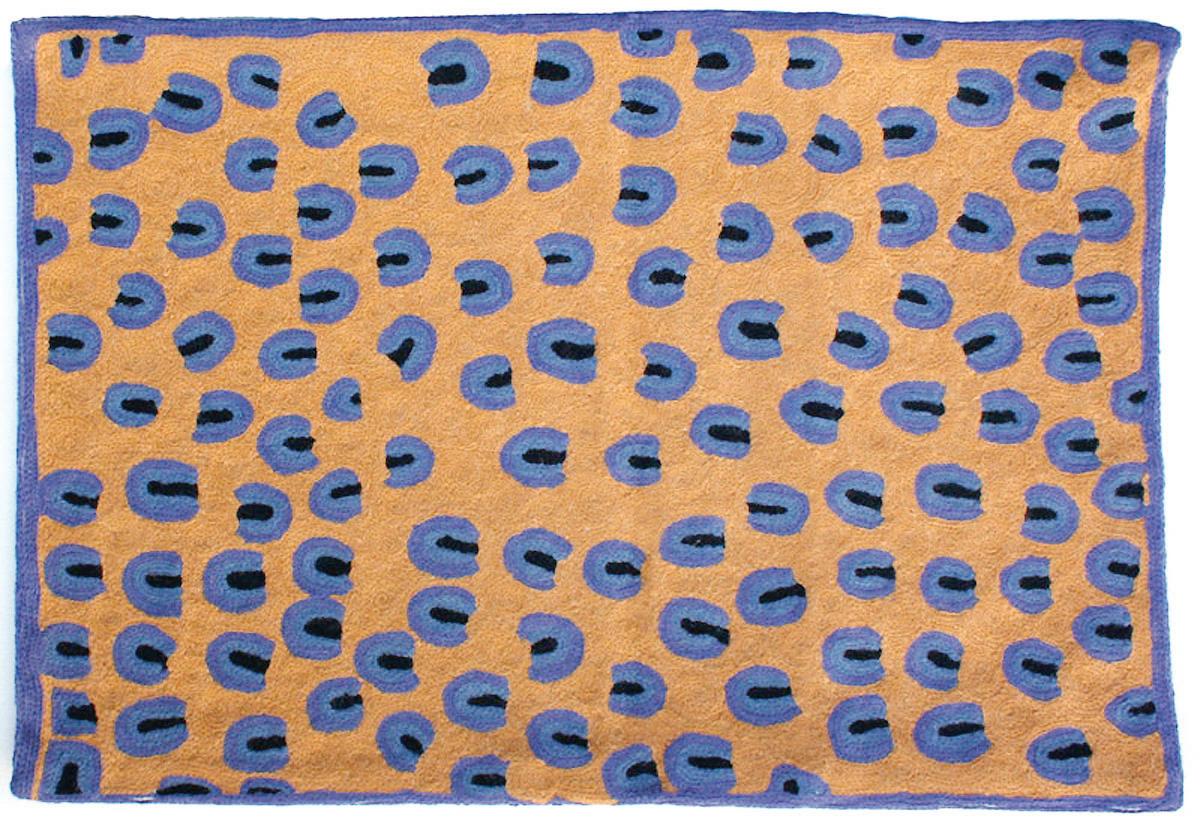

It made perfect sense to South Australian artist Carolyn Wilson when she first encountered Kashmir’s beautiful stitch craft heritage, and she was quick to identify the potential for combining the two art forms.
While both forms are so distinctly different, they are also similar in many ways, not least that they have survived centuries, handed down to artists and artisans from generation to generation. The techniques used are unique to both their regions, and both are
BY MAMATA SALAKAPURAPU

legacies of their culture.
It is this commonality that Wilson seeks out in her work with the arts and when she interacts with people from different cultures - believing passionately that the arts can be used to create a better world. In fact, she even calls her organisation Better World Arts (BWA).
And thus at BWA, a collaboration was born using the cultural craft heritage of the Kashmir region, and the traditional art of the Anangu Pitjantjatjara Yankunytjatjara (APY) Lands of Central Australia.
“In effect, it is Australian Aboriginal art expressed via Indian Kashmiri handicraft,” says Carolyn, who first came up with the idea in 1996.
The Anangu art forms are sent to India, where they take shape into handmade rugs and cushions.

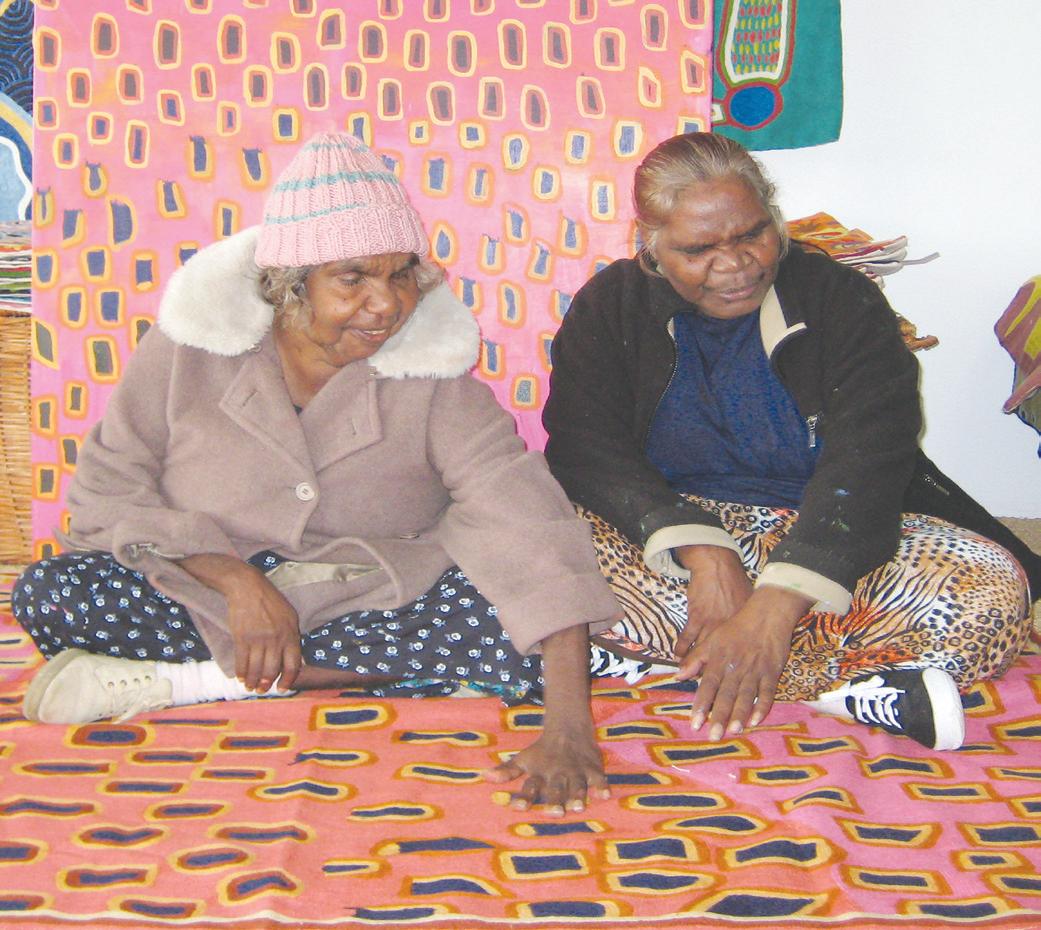


“Much of the work over the past 15 years has been carried out by Sidiq & Sons, who inherited the family business from their grandfather, a Kashmiri woodcrafter of high renown in his times,” Carolyn reveals. “I send them meticulous information through images, about size, finishing, colour-dye accuracy, wool… but Better World Arts would not have come so far if not for the skilled and dedicated craftsmen on the other side. The finesse and subtlety of every stitch that goes into the rugs and cushions, amply reflects their fine skills. The fact that they have lived on the Silk Route for centuries is so very evident from their work!”
And Carolyn’s own fondness for everything Kashmiri is just as evident from her descriptions of the “serene and beautiful” landscapes and people she has met there.
The work is produced in limited editions and every product comes with a certificate of authenticity, which ensures that consumers draw pride in the uniqueness of the artwork and enjoy their possession. The products are then sold wholesale to celebrated Australian art galleries, and profits are shared between Better World Arts, the Australian art centres and the Indian artisan groups.
Royon sheen cushion cover designed by Mulykuya
Handmade cushion cover designed by Karen Kulyuru
Rama Sampson and colleagues at work at Adelaide
Handmade Kashmiri stitch pillow cover designed by
Empowering communities
Better World Arts is not just about arts: it’s also about creating a better world for disadvantaged communities, and as such, it has evolved into a social enterprise over the years.
For the Anangu people, BWA provides an opportunity to move away from predictable commercialised Aboriginal images with these new products. Equally, for the Kashmiri artisans, BWA has opened up an entirely new market.
“Australian Aboriginals do not have a manufacturing culture; and intellectual property is not a known concept in Indian handicrafts,” explains Carolyn.
The motive is to provide culturally appropriate and sustainable employment for everyone involved in the projects, while still ensuring that culture and skills are retained from where they originated.
Some 50 Aboriginal artists are part of the enterprise, and more than 60 Kashmiri artisans involved in producing the rugs and 25 working with the papier mache. Thanks to BWA, they are involved in sustainable, culturally enhancing work, and helping preserve centuries’ old tradition.



The Anangu artists are given royalties from the products. And the role of BWA does not end by simply sharing out the monies. The challenging task is to engage artists within the modern community and ensure that their social needs are met. A share of the profits is put towards community projects as well.



For people who come from Central Australian lands where there is no specific word for art apart from ‘walka’, which loosely translates as “meaningful marks”, the rest of the country often emerges as foreign territory. They need help in every aspect of life like housekeeping, formal education, banking, health, communication etc., and access to these basic services often needs a translator. Though the government provides a lot of support to Aboriginals, many need assistance in effectively utilizing services
from indigenous community centres. This is where BWA steps in and fills the gaps. The staff of BWA go beyond the call of duty to assist the artists in every way to the best of their ability.
Ngura Wiru Winkiku Indigenous Corporation that translates approximately as ‘Better World’ (literally ‘lovely country altogether’) is the result of persistent work by BWA in setting up a location in Adelaide to serve as an exclusive space for Anangu and other aboriginal artists. It is financed from the combined profits of BWA and the Australian artist communities without any aid from the government. Located in the same premises as the retail outlet of BWA on the Commercial Road, Port Adelaide, this is one place Anangu can call and identify as their own.

Recognition
BWA has crafted many product lines from abstract art, and its art pieces are showcased across the country. The business has expanded to retails outlets in Adelaide, Alice Springs, Canberra, Darwin, Fremantle, Hobart, Perth and Sydney. In 2008 BWA was a finalist at the Telstra Business Awards in the Social Responsibility Category. Vogue Living magazine did a major feature recently, and only last Christmas, BWA found its products listed in many “desirable gifts” lists.
The cross-cultural collaboration model has now been extended to Nepal, Tibet and Peru, and the products have diversified into lacquerware boxes, jewellery and handbags.
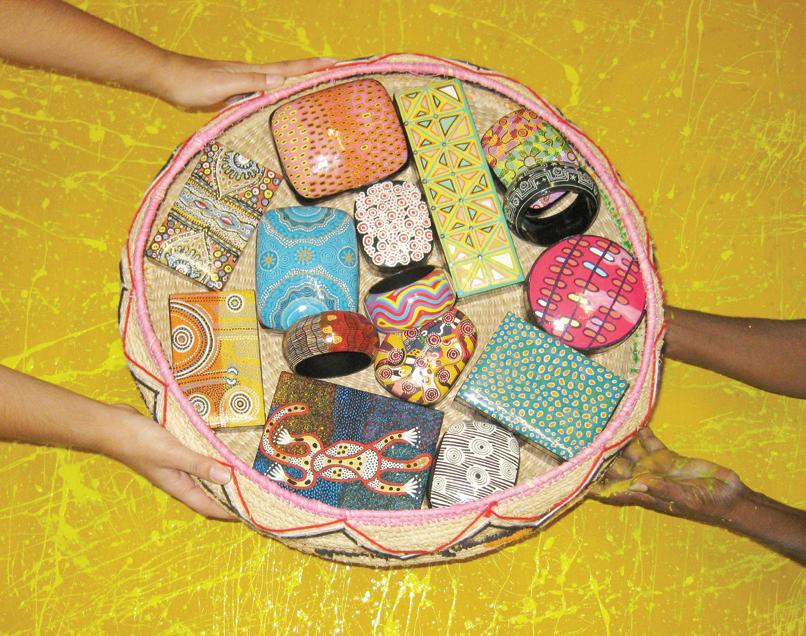
And how do the Aboriginal artists think of their collaboration with Kashmiri artisans, Carolyn?
“They reciprocate with song and dance when they see their abstract art take shape as tangible products! To them, song, dance and art are all integrated in a oneness, reflecting an aspect of their life that cannot be separated. So there’s a story associated with each and every product.”
Mulykuya Ken
Kulyuru
by Mulykuya Ken
Abdul Guli and colleagues at work at Srinagar
Carolyn Wilson with Kashmiri artisans
Kip’s trip
Jaspreet Singh’s book Chef chronicles the return of the prime character to Kashmir, and his unusual predicament that transcends the bounds of human relations
 BY SHIVANGI AMBANI-GANDHI
BY SHIVANGI AMBANI-GANDHI

Canadian author Jaspreet Singh’s debut novel could have easily been a forgettable rehash of much “Indian literature in English”, that has come before. As an Indian-Canadian author (born in Kashmir, later moving to Montreal) writing about his home country, Singh could easily have fallen under the shadows of masters like Rohinton Mistry. The conflict in Kashmir too, which forms the crux of his novel, is familiar material - Indians particularly get an overdose from the daily newspaper and Bollywood war films. The primary character and narrator, Kip (Kirpal Singh) is a chef, and his monologues could have easily been exotica-mongering passages about the spices and smells of Indian cuisine for an insatiable western audience.
However, Singh rises above these presumptive expectations. His writing sits comfortably within the tradition of immigrant Indian authors, and yet it is fresh and stylistically simple, if not crisp. Kashmir and its war-ravaged, hell-inparadise setting is not merely a backdrop,
but a living, breathing character. Particularly the Siachen Glacier is as much a character of the book, swallowing lives, driving some to insanity, freezing all human warmth. His descriptions of Kashmiri cooking and recipes, particularly his hybrid version of rogan josh, reveal the cultural ties between the seemingly insurmountable hostilities of Hindus and Muslims.
The novel begins with Kip - now middleaged and victim to a growing brain tumor - returning to Kashmir after 14 years (must all Indian exiles last that very mythological number?). The long train journey provides ample time to dig into fading memories of his time as an apprentice to chef Kishen in General Kumar’s household. The then 20-year-old Kip is exposed to not only Kishen’s philosophical approach to cooking, but his fiery opinions about women, politics, religion and everything in between. Kishen has some pretty strong opinions about Muslims and is proud of the fact that he made his professional progress because he once refused to serve Muslims. One is worried about the impact this might have on young Kip.
As a Sikh, Kip is initially distant from the sectarian politics underway in Kashmir, but is quickly dragged into the centre of a controversy when he falls for the “enemy
woman”, a Pakistani woman caught at the border river and presumed to be a terrorist. The gentle romance seems to evoke a ruminating side to Kip, as he begins to see the “enemy” differently. At one point he buys a Qur’an for the Pakistani woman, and while cycling back, makes a poetic observation:
“The enemy turned on their lights at precisely the same time, I realized, we turned on the lights on our mountains. Both sides declared night at the same time despite the time difference. I stopped my bike and waited by the railing for a long time, and thought about the kitchens on both sides of the border, the culinary similarities and differences, and I thought about the rain, which was now falling too, on both sides, making the lines fuzzier and fuzzier.”
His (and the readers’) ideas about justice and righteousness get even fuzzier as Kip stumbles into the horrific torture chambers of the Indian Army as well as uncovers some of its most shameful scams. In contrast to Kip’s slow but steady realizations about the situation in Kashmir, Chef Kishen’s explosive revelations on the Siachen Glacier seem a bit over-dramatic, and almost a tad filmy. But for these occasional slippages into the predictable, Singh’s book remains an interesting read.
(Singh’s) descriptions of Kashmiri cooking and recipes, particularly his hybrid version of rogan josh, reveal the cultural ties between the seemingly insurmountable hostilities of Hindus and Muslims.

44 <> FEBRUARY (1) 2011 INDIAN LINK
www.indianlink.com.au BOOKS
India, English and an inferiority complex
There still exists the need to be recognised and commended by major powers before a country can stand on its own merit
BY TANVEER AHMED
Recently a major writers’ festival was held in the city of Jaipur. It was hosted in the historical grandeur of its Pink Palace and organised primarily by the English writer and historian who spends much of his time living in the subcontinent, William Dalrymple. It was meant to be a celebration of Indians writing in English. There was great controversy in the lead up to it after a prominent columnist from the Times of India lambasted the fact that a white man was the key member of the judging panel.
What followed was an interesting national debate, at least among the middle classes who might actually buy books in English. Does India’s self esteem still depend a little on gaining approval from its old colonial masters?
It was captured somewhat by former Booker Prize winning Indian author, Anita Desai. “It’s like Indian writers can always export the pashmina shawl story; we can always export the arranged marriage story. It’s always in fashion. But certain bestselling American authors are never accused of continuing to produce the exotic American novel,” she said.
Obama’s recent State of the Union speech alongside China as the countries that might dominate the upcoming century and challenge American hegemony.
Socially, I have always found the way status is projected in South Asian communities enlightening. There are certainly elite sections of all countries in South Asia where being Anglicised is a sign of high status. It is a trend in all the old colonies, for the best schools, universities and jobs were often linked to the Raj and Anglo-Saxon power. The term for it is, “more English than the English”. It is transmitted through accents, taste in wine and fashion, and even ability to play culturally foreign sports like golf or tennis.
Australia has often been accused of what is known as the “cultural cringe”, whereby we automatically perceive our own creative output as inferior until it is recognised in either the “motherland” Britain or the United States.
It takes some unique turns within South Asian communities, both expatriate and local, for there is no society in the world more status-conscious than Indians. The combination of caste and colonialism see to that.

Customer’s Comments
“I have dealt with so many travel agencies in Sydney, but yours was definitely the best customer service I have received. It went beyond my expectations. In fact, I could depend on you if something went wrong or I needed to make a change, even when I was overseas. I liked the honesty in your dealings and you never tried to misguide me on the price or anything else. I have recommended Travel Hut to a lot of our friends and they are equally happy.”


 - Ruchi Sanghi
- Ruchi Sanghi

COMFORTABLE AND CHEAP TOURS
“There is sadness in India that literature has to be commended by New York or London,” added British-Indian novelist Rana Dasgupta in response. “Many writers feel insignificant, and we can blame the West, but this dispossession is not postcolonial anymore, but a product of globalization.”
This wouldn’t be unique. Australia has often been accused of what is known as the “cultural cringe”, whereby we automatically perceive our own creative output as inferior until it is recognised in either the “motherland” Britain or in the United States.
Back to the Jaipur writers’ festival. The conflict relates some interesting questions about modern Indian power. Will India project power much like European powers may have in the past, by for example trade negotiations, more political clout and a muscular military? India has some unique potential for what is known as “soft power”, more so than China, for its cultural exports such as Bollywood are globally popular, especially in the developing world. And will the emerging, younger middle class, despite being English-speaking, look towards acting more like Westerners to show off their status or will they attempt to find what they might consider more authentic to the native culture?
India has some unique potential for what is known as “soft power”, more so than China, for its cultural exports are globally popular, especially in the developing world.
It is seen as a sign of our perceived insignificance and irrelevance in world affairs.
But India is now far from insignificant. It is being dubbed as an emerging superpower and was singled out by
The answer is likely to be a mixture of both. And it is interesting that, arguably, one of the most influential Indian writers, listed in Time magazine’s 100 most influential people in the world list in 2010, Chetan Bagat, writes in very simple English aimed at the masses. Furthermore, his writing is not about grand narratives on partition or history, but at simple but engaging stories about young people working in a call centre or wanting to rebel against traditions that do not seem to suit the modern world anymore.
FEBRUARY (1) 2011 <> 45 NATIONAL EDITION
www.indianlink.com.au OPINION
FECCA’s new policy is divisive
Many aspects of the National Multicultural Agenda have a specious definition of integration, equality and cultural differences
BY NOEL G DE SOUZA
Medical surveys find that migrants develop similar health patterns to mainstream Australians with regard to diabetes, hypertension, heart disease and cancer as they adopt local food habits and lifestyles. Ethnic groups are cultural entities that originated in certain geographical locations. A child born into one ethnicity but brought up in another place will absorb the culture and lifestyle of the place where it is brought up.
The Federation of Ethnic Communities Councils of Australia’s (FECCA) proposed National Multicultural Agenda (Different But Equal) aims “for renewed political and social commitment to multicultural Australia”. Multiculturalism raises apprehensions in certain quarters within Australia, Europe and Asia. The document states that “it is not ‘multiculturalism’ that has failed, if indeed this is the case as argued by many European nations, but the lack of an authentic and courageous engagement with cultures and their many aspects including religion and customs.”


The document emphasises that the proposed Agenda “is not a nostalgic reinvention of past policies”, but it does give that impression. The Agenda’s “core principle is the notion of equality between all cultures.” This idea is very difficult to sell in either Australia or elsewhere. Almost daily we hear about cultural oppression in diverse places and of the affected individuals seeking refuge in other countries.
The notion all cultures are equal is an unprovable supposition. Rather, what should be expected is that people from all cultural backgrounds are treated equally under Australian laws. That is the essence of nondiscrimination. The document, quoting the August 2009 paper of the Settlement Council of Australia (SCOA), states that “tensions generated by the arrivals of new immigrants ….. require interventions by government to moderate the potential conflicts and ensure economic, social, cultural and political integration.” The proposed National Multicultural Agenda unfortunately, does not promote integration.
The proposed Agenda “rejects the framework of cultural hierarchy inherent in labels such as ‘mainstream culture’ or ‘host culture’”. Those two terms are not implicitly hierarchical. Every country (such as in Europe and Asia and every large state in India) has a mainstream. In Australia, the mainstream has grown by integrating individuals from several ethnic groups. It has also absorbed cultural elements from many cultures such as in music, food and literature.

The “equality” question is clothed in the Agenda with such strange statements as “there must be equality of ‘cultural circumstance’
as much as equality of opportunity.” The explanation given is “that while we may be ‘different’ as individuals, communities and cultures, we aim to achieve equality without relinquishing difference.” Who are “we”? Can FECCA speak for all ethnic Australians? The Agenda’s objective seems to be to blatantly maintain cultural differences, thereby rejecting integration within Australia.
The Agenda uses a lot of prescriptive language. For example, “it expects from all Australians the obligation to be proactive in cross-cultural and intercultural dialogues.” Australia is a free country wherein one interacts with whom one pleases. Crosscultural dialogue has been successful in Australia for a long time without imposition.
FECCA “believes that the voices of CALD (culturally and linguistically diverse) communities should lead the shaping of a new multicultural policy for Australia …” The suggestion that CALD communities should lead could be interpreted (perhaps erroneously) as the hijacking of Australia’s cultural agenda. Surely such policies need to be shaped by all Australians. As a recent document (The People of Australia, 2010) from the Australian Multicultural Advisory Council rightly states, for a sound Multicultural policy “all governments and interest groups should be careful not to assume a monopoly of knowledge or virtue.”
An individual growing up in Australia studies, watches television programmes and movies, and listens to songs in English. English is both the language of communication and the principal language of culture. For those who grow up here, English is the language they know best and which allows them to integrate with the mainstream. Higher secondary school results demonstrate how well ethnic students perform in English language studies.
Different ethnic groups have come to Australia during different periods. European continentals came here some two or three generations ago. Their younger generations have become mainstreamed. Inter-ethnic marriages have also become commonplace.
Hung Le, Vietnamese refugee and now comedian, says: “We Vietnamese are very easily integrated – I think we’ve integrated pretty well in Australia.”
FECCA’s valuable contributions over the years to migrant groups have helped newcomers to ultimately integrate into Australian society. Its Different But Equal document is, however, incompatible with its valued work upto now. Rather than labelling this document “the most important social policy vision for Australia”, FECCA should ponder on whether its latest proposals promote divisiveness rather than the integration of diverse cultures into Australia.
The renowned shopping centre magnate Frank Lowy spoke for many when he said, “I don’t know any other country that has absorbed such large numbers as successfully as Australia.”
46 <> FEBRUARY (1) 2011 INDIAN LINK www.indianlink.com.au OPINION
The “equality” question is clothed in the Agenda with such strange statements as “there must be equality of ‘cultural circumstance’ as much as equality of opportunity.”
The debt solution




Australia will be paying for the damage caused by the floods in Queensland for a long, long time, but a solution is at hand
BY MARK SHARMA
It is not exactly the kind of start that anyone would have expected for 2011. Bushfires in Western Australia followed by floods in Queensland, Victoria, Tasmania and New South Wales all but put a dampener to the festivities of the New Year. The death and devastation that these tsunami type floods have caused has hurt every Australian. It has touched all our hearts, as well as millions more around the world. But Australia, they say, is a tough nation. This is a self-made country; a nation that can be knocked to the ground but can never be defeated. The “never give up” Aussie spirit will overcome even the greatest of challenges that Mother Nature throws at us.
Tens of thousands of volunteers took to the streets of Brisbane and elsewhere to clean up the mess that the killer floods unleashed. Not to be forgotten also is the generosity of millions of Australians. Within hours of the first floods, thousands of people pledged money to the Premier’s Relief Fund in Queensland. Schools, offices, tradies, restaurants, corporate groups, sporting teams and hundreds of other professional bodies got together and raised money for this worthy cause. At last count, close to $182 million has been raised and this is expected to go up. It was heartening to see that even smaller nations like Sri Lanka, Tonga and East Timor wanted to help in Australia’s hour of crisis. The Federal and Queensland State oppositions should also be commended on their show of solidarity with the government at this crucial juncture. The cleanup bill is expected to run into billions of dollars and the effects of this devastation will stay with us for months and possibly, years.
to worsen the situation. It is expected that all the gains enjoyed by our Aussie dollar against the greenback will fall spectacularly.
To sum up, Australia is staring down the barrel of another financial crisis. Nobody is talking about it just yet, but eventually it will become an important issue. Already there is speculation that the Reserve Bank will hike up interest rates again, anytime between now and the next 3-4 months.
In short, we need to generate more money and we need it now. Many experts believe that it is our mining industry that will once again rescue us from another disaster. Yes, the same industry that Kevin Rudd wanted to kill with RSPT. But Australia can’t just rely on normal exports. We need to rethink our strategies and look for newer avenues.
cash over three years.
In November last year, Prime Minister Gillard announced a nuclear deal with Russia and called it a “job creator”. It is widely expected that the Labor party will finally get rid of its colonial thinking and embrace new realities by starting talks with India for a similar deal. Indian PM Manmohan Singh is expected to visit Australia later this year and the export of uranium is tipped to be at the top of the agenda. India desperately needs uranium to feed the energy demands of its over 1 billion strong population. Imagine if you had to stay without electricity for hours in 45c sweltering heat?


Over 800 million Indians experience this every year, for which Australia has the solution. It is expected that a uranium deal with India can fetch as much as $1 billion in extra cash over three years.
People in Sydney and some other parts of NSW can consider themselves lucky that they were not directly affected by the water, like our brothers and sisters up north of the border. But this national crisis will eventually hit all of us. Apart from the extra spending on repairing infrastructure, it will also hurt grocery and petrol bills of every Australian family.
The nation is already under a mountain of debt and taking on more is only going
Already the USA, France and Russia have signed major nuclear deals with India. In Australia, the Coalition has strongly supported uranium exports to India. This is the right time for Prime Minister Gillard to show some leadership and agree on another “job creating” nuclear deal. She needs to pick up the phone and call her counterpart in New Delhi with the good news. A nuclear deal with India would be the right thing for the people of Australia, India and the planet. It would provide electricity to millions of Indians, financial strength to the Australian nation and a cleaner planet for rest of the world. Is there anyone listening in Canberra?
NATIONAL EDITION
www.indianlink.com.au OPINION
It is expected that a uranium deal with India can fetch as much as $1 billion in extra
The sleazy side of surrogacy
Will new legislation curb this booming business in India, thriving through exploitation, yet enjoyed by international patrons with money and means?
BY ROY LANGE
The surrogacy debate has been recently reignited with a Melbourne court granting full parental rights to a gay couple with a child born to a surrogate mother in India. Medical tourism has not been all bad. Uninsurable Americans have been getting bypasses in Delhi’s Apollo Hospital rather than perishing on a long waiting list in New York. A triumph of Indian expertise. And enormous revenue for the country. Does surrogacy deserve to be classed in this revolution? Should surrogacy be even legal?
Years ago while I was studying in Delhi University, my Indian guardian Dr. Nina Dey told me with furious
indignation a story from when she was conducting research in Bangladesh. An American company invited her on a jet boat ride to an almost inaccessible island in the marshes of the delta - unaware that she spoke Bengali. The company claimed they were conducting charitable works but it was discovered the islanders were, under questioning from Dr. Dey, in fact guinea pigs in fertility drug trials. Many of them were very seriously ill.
This left an impression on me and I am happy to let it prejudice my views on the surrogacy debate.
Indian wombs are not for sale. India is not a gynecological two-dollar shop.
I feel for infertile couples. Being an unhinged lefty I feel even more sorry for gay couples. But they will have to max out the credit cards, fly to Kentucky and pay a Hillbilly.
India is looking to legislate an industry that by some accounts has 3000 clinics and annually earns the country half a billion US dollars. This has stemmed from innumerable complications.
Starting with the technical. A German couple contracted a clinic for a child. The German Government refused citizenship nor residency for the child because that country does not allow paid surrogacy. The Indian Government simply does not
recognize children born to foreign parents who have donated eggs in the IVF process. Children are caught in this limbo.

A Japanese couple divorced during the gestation period of the Indian mother. They dropped the child like a hot potato. After a protracted legal battle, the child was adopted by the Japanese man’s 74-year-old grandmother.
India has decriminalized homosexual behavior but confusingly, it is still not legal. Press pundits in India have speculated that this may disallow gay couples entering a surrogacy contract.
These are relatively inconsequential. The industry practices demonic behavior.
The Indian mother is locked up for nine months to ‘ensure’ a healthy child. This is just wholly bloody unacceptable. Try locking up a Californian surrogate mum for nine months in a contractual arrangement and you would have even Sarah Palin reduced to tears.
A surrogate mother has often borne many children. Her health may suffer a heavy toll from this. Allowing a system that irreversibly punishes her body for monetary gain is wrong. Allowing a system that punishes her body out of her sheer desperation is criminal.
What happens if a child is born physically or mentally challenged or just not attractive?

You can’t tell me this hasn’t happened in the thousands of surrogate births a year. Do the foreigners reject the child with a satanic quality control?
What eventuates, if the Indian mother gives birth to more than one child or more than what is in the shopping cart? Is that child a surplus to requirements? Is the child killed at birth? Tragically, this could have eventuated in a stone cold business.
If the challenged or ‘surplus’ child is not killed at birth who is to look after the poor soul? The surrogate mother? The clinic that runs the business? These hard questions raise the possibility of widespread infanticide.
The surrogate mothers are almost exclusively impoverished rural poor who are often illiterate, whose scope of choice is minuscule compared to the relatively rich couples that pay for their child.
This hasn’t stopped a wonderfully courageous woman who has petitioned the Delhi High Court to keep her child that she refuses to surrender. How seriously will she be taken? Up against what would have to be a superiorly funded legal team and a judiciary that favours English medium types.
Masters to this repugnant slavery have to stopped. They are the children shoppers and the shopkeepers of these clinics who pay these women as little as USD 500.
48 <> FEBRUARY (1) 2011 INDIAN LINK
www.indianlink.com.au OPINION
India is looking to legislate an industry that by some accounts has 3000 clinics and annually earns the country half a billion US dollars.




FEBRUARY (1) 2011 <> 49 NATIONAL EDITION
Co-operative, coercive not
Co-operative, coercive not
Nostalgia is a good thing in small measures. The 1960s are no more and some still miss those years, but all accept that the era is gone. And yet with 1990s many have difficulty accepting that the 30-year boom is now history; the days of easy money and “free” water are gone, and the days of “free” air are numbered. Or that the days of US dominance may go, and with it could go the “peace dividend” of the single superpower era. China is changing the world using its manpower, market power and money power, but also ‘brute force’ exchange rates and lax human rights.
BY DILIP JADEJA
When Los Alamos was infiltrated to provide secrets of nuclear suitcase bombs to Beijing, despite everything, one knew that Beijing did not have a chance in hell of using that technology without inciting serious consequences. The incident was bad blood, but not on the scale of the Cuban crisis. Since then though, Beijing has caused more damage. Reportedly, it has stolen the hard disks of a force-landed US spy plane; has undone the US listening devices from a Boeing airplane fitted out for the Chinese President; floated quieter nuclear submarines patrolling the oceans of the world; reversed the engineering of a fallen US stealth fighter and flight-tested an early version of a Chinese stealth fighter. It has established a naval presence in some critical countries and ports in Asia, the Middle East, Africa and probably Latin America; established agricultural and mining supply routes from Africa; established energy (oil and gas) supply contracts and routes from the Middle East and Central Asia; built huge stockpiles of Euro and US dollar reserves; established a tight control on mining and export of rare earth minerals wanted, amongst others, by the Pentagon, environmental products manufacturers, car and air-conditioning product makers and so on. China has sold and provided high power defence products to a range of countries including the tinder boxes of Pakistan, Iran and North Korea; done deals with unpopular global regimes in Sudan, Iran, Venezuela and North Korea; confronted the Japanese possession of islands claimed by China; instigated hacking attacks on critical internet assets of a range of countries including Australia, USA, UK, Canada, France and New Zealand to name a few; and so on. One has to conclude from all this public information that China has actually done even more that has not come to light yet.

China is a fine nation of fine people; it has an impressive history spanning thousands of years, extraordinary culinary prowess, architectural influence, stunningly beautiful audio visual sensibility and art…

At best this reflects the fact that China is repositioning itself in the world’s packing order and if so all this is explainable, though clearly unacceptable, to a whole range of countries and interests worldwide. At worst, it demonstrates a serious sense of insecurity by some powerbrokers or stakeholders within China - one of the world’s finest countries that does not need to feel threatened. Up to a point it may be also that China is imperialistic and not only wants to merely strengthen and consolidate its border areas with the central power base in Beijing, but in time, it may want to enforce fresh claims for what it may see as its territories, although those territories have been long held by other countries. In doing this, China may be taking the historical viewpoint – one that a majority of people in the world are increasingly uncomfortable with – that just because some territory was one country’s or culture’s area 100 or 500 years ago, it should still be as it was in those times, disregarding current long standing possessions. This sort of Chinese approach would threaten Japan, Taiwan, South Korea, India, the Philippines, Malaysia, Brunei, Vietnam and Bhutan anf their interests. It may in future become an issue for other Chinese neighbours like Russia, Mongolia, Kazakhstan, Kyrgyzstan, Afghanistan, Pakistan, Nepal, Laos, Burma and Thailand.
That said, unlike Hitler’s Germany, China is not overly imperialistic, not today, and hopefully never. It has the potential to become a paranoid power seeker, if it is not careful about its ambitions. Unfortunately, this is exactly what China does on the economic front. It does not need to be that way however, because China has many other means of assuring wealth, prosperity, peace, growth and sustainable future of all its people by making its new wealth an instrument of not just its own, but the world’s future welfare.
China is a fine nation of fine people; it has an impressive history spanning thousands of years, extraordinary culinary prowess, architectural influence, stunningly beautiful audio visual sensibility and art, the world’s best organisational and execution abilities. It has a very lovable and kind hearted, curious and explorative young generation; vast areas of natural beauty, forest and hinterland; some of the world’s most creative minds capable of taking the whole world onto a fundamentally new scale of ‘pleasure of living and being’; a massive prospect of raising its own standard of living and that of all the poor people in the world. Above all, China has the capacity to become a supremely responsible, self-controlling, self-disciplining, progressive, increasingly open and transparent country to whom the world can then happily say “thank you” for what only China can do – raise the global living standard to an all time high. Germany missed that opportunity last century.
If China was after a lesson that no superpower can be a sole superpower forever, it only has to go as far back in history as the Romans, the British Colonial Empire or the US hegemony of the late twentieth century. China must know, of all other countries, that power is but cyclical – it comes and goes; but the people of a country do not need their land to be an absolute superpower in order to enrich and enjoy their living experience. A cooperative, not a coercive, China is what the world is looking for. In it lies the best course for China’s future and the world’s future. Whether China succeeds at what only China can do, is a ten trillion dollar question.
INDIAN LINK
VIEWPOINT
China can make a world of difference as it emerges into a defining power that can change the world’s future for better or for worse
www.indianlink.com.au



FEBRUARY (1) 2011 <> 51 NATIONAL EDITION
Waist Watchers: Women at increased risk
No matter what your height or build, people with more weight around their waist are at a greater risk of heart disease and diabetes, says Dr Ritin Fernandez from the University of Western Sydney (UWS). Type 2 diabetes (high blood sugar) is projected to become the leading cause of disease burden by 2023, partly attributable to the expanding problem of obesity.
In a collaborative effort by the Australia India Medical Graduate Association (AIMGA) and the DHARMA investigators, people of Indian origin were surveyed at the Australia India Friendship Fair in August 2010. The aim of the survey was to identify the cardiovascular risk factors including waist circumference, body mass index

How to measure your waistline
Measure directly against your skin.
Breathe out normally.
Make sure the tape is snug, without compressing the skin.
Measure halfway between your lowest rib and the top of your hipbone, roughly in line with your belly button.
and physical activity patterns of Indian Australians.
Ninety seven percent of the women and 59% of men who were measured, had a waist circumference greater than the recommended values. Sixty one percent of the participants were classified as being either overweight or obese. Only a quarter of those surveyed stated that they walked for the recommended time of 150 minutes each week. The results show that these people are at an increased risk of heart disease and diabetes.
Body mass index (BMI) has been widely used as a standard measure of obesity. However, current evidence indicates that waist circumference is a more useful
What is considered as increased risk for Indian people
Men: Waist circumference more than 90 centimetres

Women: Waist circumference more than 80 centimetres
(Information obtained from http://www.health.gov.au)
measure because it more closely reflects levels of fat deposits found around the body’s organs including the heart, kidneys, liver and pancreas. Therefore a large waist size is an indicator of excess fat deposits, surrounding the major organs which is reported to be harmful. A large waist circumference is also associated with an increased risk for type 2 diabetes, high blood pressure and cardiovascular disease. Extra weight can also put you at higher risk for these health problems: heart disease and stroke, some types of cancer, sleep apnea (when breathing stops for short periods during sleep), osteoarthritis (wearing away of the joints), gallbladder disease, liver disease and irregular menstrual periods.
What you can do
1. Measure your waist, weigh yourself and write it down. Set some long term and short term goals for weight loss.
2. Have a healthy diet. To do so you will have to
(a) Plan your meals
(b) Plan healthy snacks. Fruit, veggies, yogurt, dried fruit and similar snacks are all good choices.
(c) Find lower-fat alternatives. Adding fruits and veggies is another good way to lower fat intake
(d) Eat slowly
There is strong scientific evidence which indicates that for overweight patients with high blood pressure, weight loss of 3% to 9% of body weight reduces both systolic and diastolic blood pressure by 3 mm Hg. Increasing the amount of exercise and a healthy diet are some changes that people can make to combat the growing waist problem, says Dr Fernandez, leader of the DHARMA project. The NHFA recommends that people should participate in at least 30 minutes of moderate intensity physical activity on most if not every day of the week. Seeing your GP regularly can also help to reduce your risk of cardiovascular disease.
(e) Stop drinking calories. For example soda, coffee, tea, alcohol, juice and other beverages all add up the calories
(f) Drink plenty of water
3 Exercise. Some suggestions are
(a) Walking during lunch hour
(b) Taking a family walk after dinner
(c) Mowing the lawn with a push mower
(d) Playing with your kids or grand children 30 minutes a day
(e) Dancing to music
(f) Walking briskly in the mall
(g) Taking the stairs instead of the escalator
52 <> FEBRUARY (1) 2011 INDIAN LINK
www.indianlink.com.au HEALTH


FEBRUARY (1) 2011 <> 53 NATIONAL EDITION
Ami Tomaay Bhalobashi

A special tribute to Suchitra Mitra, a unique singer who dedicated her life to promoting Tagorean music
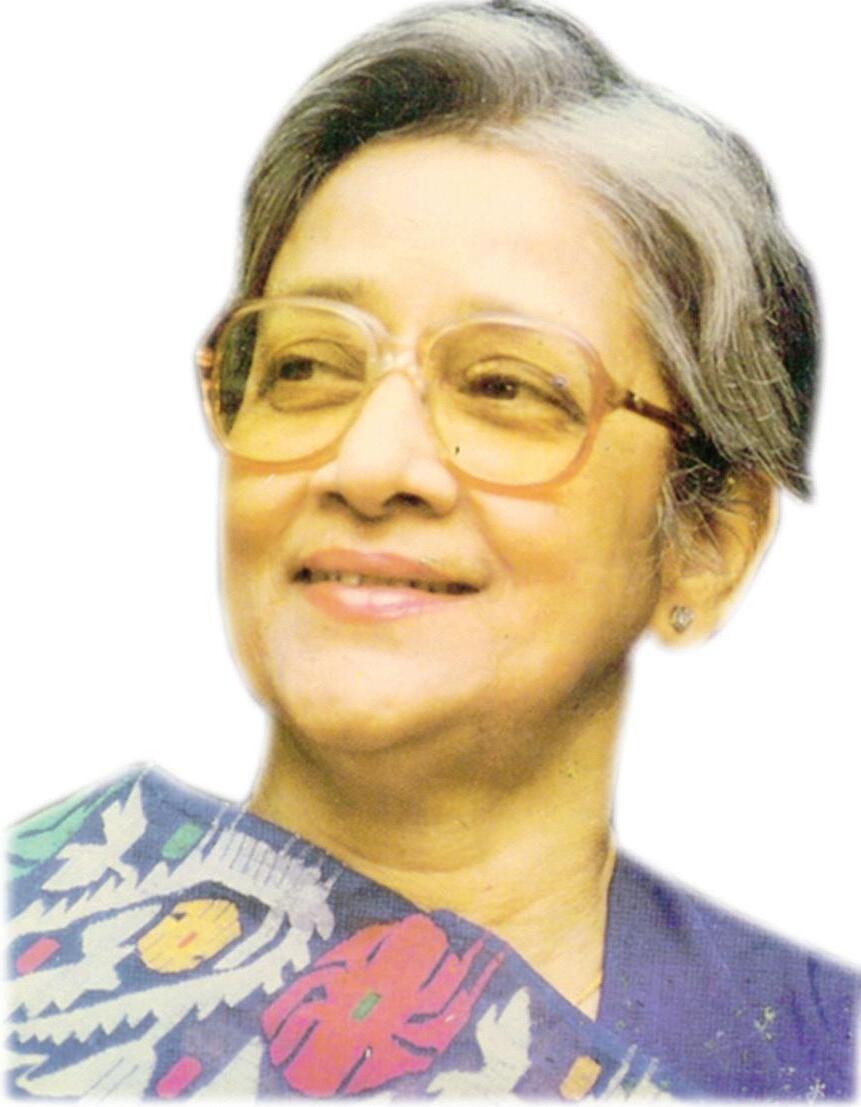 BY MADHUCHANDA DAS
BY MADHUCHANDA DAS


Uncannily true rings the adage that you can never take Rabindranath Tagore out of a Bengali’s heart! Hence, although growing up far away from the land of rossogolla, adda and Tagore, my typical simple living-high thinking Bengali parents felt doubly responsible in bringing us up as quintessentially Bengali offspring. As a result, Rabindra Sangeet (Tagorean music) and Bengali films tiptoed surreptitiously into an unobtrusive corner of my soul. As part of the inimitable babumoshai spirit, I often sought refuge in the rhythm and histrionics of the legendary Suchitra duo – the shining stars of the Bengali cultural scene, Suchitra Mitra and Suchitra Sen. January 3, 2011 saw the passing away of one of them - the legendary Rabindra Sangeet singer, Suchitra Mitra. Thankfully, it was my Ma (who had instilled the love of Rabindra Sangeet in me) and not the Facebook status of a friend, that broke the news to me. Ma, who’s always had her way with words and is an amazing singer herself, asked me if I remembered Suchitra-di’s spirited rendition of Krishnokoli’s Aami Taarei Boli (I call her Krishnokoli). This was the first song that I had ever heard from the artiste, and in no time at all I could picture myself at eight, being enthralled by an uninhibited voice as Bangla lyrics didn’t make much sense then. Even in my constricted, concrete city room, I could fathom the ethereal charm of the solitary, dusky village girl in a pristine Bengal paddy field. Thereafter, this voice never failed to electrify my soul with its Aamar Shonar Bangla Ami Tomai Bhalobashi (I love you, my Bengal, the place made of solid gold). It became an inextricable ingredient of my cultural psyche and I was hooked for life.
When Ma finally broke the tragic news of Suchitradi’s demise, I consoled my shattered eight-year-old heart that Suchitra-di’s physical form had moved on but the fragrance of her melodies would continue to rejuvenate my life, re-ignite my passions and reinstate my often-
wavering faith. Yes, they would continue to resonate in my Bengali being.
This multi-faceted doyen of melody had come to personify the essence of Rabindra Sangeet to me.
I have absolutely no qualms in stating that till date I remain much unlettered about the profundity of Tagore’s musical realm. To this ignorant admirer of Suchitra-di, her music symbolized a sudden burst of much needed showers, soaking long parched lands. Her voice reiterated that no one else could do justice to Tagore’s prose like her… as if she held the sole patent for those melodies, or as if they were created only for her to interpret. Her inimitable gayaki conveyed the mirth, the melancholy and the melodrama of Tagore’s songs like none other. In fact, her music sketched the song’s story for the listener. She fired one’s imagination and inundated the soul with life’s myriad colours. Like her bold rendition of Oyi bujhi kalboishakhi (So that’s the Nor’wester) which succinctly captured the might of the approaching storms. Her energetic execution of Tagore’s swadeshi (patriotic) songs such as Mahatma Gandhi’s favourite Ekla chalo re (Walk Alone) often overwhelmed her audience and moved them to tears. The poignancy of Hridayer Ekul Okul Dukul Bheshey Jaay, O Sajani (Both resorts of my heart are getting flooded out, Oh my loved one) remains timeless in appeal.
Suchitra-di resisted temptations to deviate from Tagore’s original notations and she insisted on preserving the essence of the bard’s lyrics.
Suchitra-di resisted temptations to deviate from Tagore’s original notations and she insisted on preserving the essence of the bard’s lyrics. Her passionate interpretations were further bolstered by her elegant personality and smart persona. My memory is flooded with black and white TV grabs of the lady with the stylishly cut short hair, swaying to the beats of the rhythm with closed eyes… as if in a trance. Her singing and her personality magnificently manifested the seamless unison of the traditional and the modern in Tagore’s compositions.
She was the lady on the move, both literally and figuratively. Born on a moving train in Gujhandi, Bihar, Suchitra-di’s life was marked by relentless creative enterprise as she globe-trotted to share Tagore’s treasures. She also was an active member of Indian People’s Theatre Association (IPTA), the Sheriff of Kolkata, and even dabbled with acting in the Rituporno Ghosh directed acclaimed Bengali film Dahan (Combustion). Her music school Rabitirtha is a leading centre of Tagorean culture, having produced numerous promising stars of Rabindra Sangeet. I was pleasantly surprised to learn that making dolls was a hobby that she fervently pursued till her last days. She indeed lived a complete life in every sense, except for an enduring regret of having joined Visva-Bharati only a few days after Rabindranath Tagore passed away in 1941. Yes, I’m aware that the show must go on as Rabindra Sangeet itself assumes newer dimensions that signify both uncertainty and hope. But undeniably, Suchitra-di has taken along with her a precious chunk of my childhood. Yet, I’m not complaining as I hum Tobu Mone Rekho, Jodi Doorey Jai Choley, Tobu Mone Rekho (Remember me, if you can. In case I go far away from you, still do remember me)
54 <> FEBRUARY (1) 2011 INDIAN LINK TRIBUTE
www.indianlink.com.au
Back in Bombay
India with its charm, tradition and diversity brings forth a plethora of emotions that are hard to control when traipsing through its cities
 BY SHERYL DIXIT
BY SHERYL DIXIT
Going on holiday to India is always an enlightening experience, and as we got airborne from Sydney, I told myself that this trip would hold no surprises and no expectations for me. And so, of course, I was wrong.
Our trip the previous year had been an eye-opener especially for me, since it was over four years since I had been home and at that time I don’t know quite what I had expected, but everything was different. Modern highrise buildings and palatial bungalows stood proud surrounded by streets that were still dusty and had the mandatory piles of rubbish after every few feet. Shopping malls jostled for space, each boasting of high-power brands, vying for a share in the country’s new found wealth, generously doled out by its jeune nouveau riche. Emotionally, mentally, even physically, I found the whole experience overwhelming, and thought that this time around, I would be ready for it. Forewarned is forearmed, I now know it all, I thought philosophically. But India is a surprising country, and perhaps the circumstances that surrounded our visit opened up an entire vista of feeling once again, and I can only liken the experience to that of unwittingly being a part of a commercially successful Bollywood movie, from its moments of slapstick to highly charged emotional scenes, including actionpacked fight sequences, albeit without the physical violence!
I learned a lot, but perhaps mostly lessons in humanity. Perhaps because with such a teeming mass of people, there is so much to observe, absorb and understand. One never feels isolated in India, maybe because even standing in a quiet courtyard at 2am, one can still hear a lorry miles away, noisily and speedily
circumnavigating along an express highway. Or the watchman making his rounds and tapping his baton on compound walls as an indicator to miscreants that he was about and vigil.
Now I rarely watch Indian movies, but the few that I have seen have always completely absorbed me and taken me through a rollercoaster of emotions. I laugh at the funny bits, and cry when the heroine cries, I feel incredible animosity towards the wicked mother-in-law and the larger-than-life villain. And because India also evoked emotions of such variety and ardour, I sometimes felt like I had an impromptu part, actually acting out a Bollywood scene set in reality.
I felt memories rushing back, those of my father, uncle and aunt as we travelled along Goa’s narrow roads admiring the whitewashed facades of its churches, where lies their final resting place. I instantly thought of my father-in-law as we walked into his home in Hyderabad, recalling happy times in his company.
that indefinable air of calm, honesty and a strong sense of duty. My family was just the same, affectionate, confusing and complicated beyond imagination, but I still felt a strong sense of support, pride and encouragement from them. My friends, incredibly talented and well-heeled, but with the same down-to-earth humility, good sense and intelligence that has endured in our friendships for as long as I have known them.
Our pals, a bunch of bad boys still partying through their 40s despite wife and kids, each with a personality that defies description but yet, are some of the dearest people I know.
And there was the lady who worked at my home through my childhood, whose homemade pickles are still the best-kept secret in the family. And the 80+ family gardener who presented my brother-in-law and his bride with a gift of money in an envelope.
Some of the scenes I witnessed were poignant in their simplicity, yet impressed me tremendously. Like a young beggar woman clad in a tattered turquoise sari, her snotnosed child on her hip, pleading for money at a busy intersection. Her ebony complexion was flawless, one which as women, we could only hope to own with the aid of the best cosmetics money can buy. Her expression was ever-changing, sometimes pathetic, sometimes bored, and then slightly animated as she moved hopefully towards the next car who would perhaps be more generous than us.
Learning of the loss of a person whom I had not met in over a decade brought me a pang of exquisite grief, because I could still recall her kindness and cheerfulness, and memories recounted by her family made me realize that illness through the passage of time had not changed her character.

The people I met, whether family or friends were all the same people I had known throughout my life, they had changed very little or not at all. The older ones still had
My sons were enthralled with everything – the taxis in Mumbai, the embellished cow that came to our home in Hyderabad as her owner blew discordant notes on his bugle, even the array of stray dogs that we saw in every city. They played in the dirt, ate a good bit of it, annoyed their grandmothers, irritated their parents and had the best time ever. They were never bored because from keeping company with their cousins and new found friends to splashing in the sea, to misbehaving on a variety of aircraft, they were always resilient, always happy, always occupied and never bored. We traipsed through five cities, a
wedding, three receptions and a reunion, and although I was exhausted by the end of the trip, it opened my eyes to a variety of scenes that I think it’s unlikely that I will experience for a long time to com.
It also made me wonder, and I admit that I am still wondering, if I am some sort of closet sentimentalist. In Australia I am calmer, more rational and sane; I am able to control my emotions and can deal with crisis situations without melodrama. But in India, I seemed to simply fall apart, finding myself on the verge of tears when parting with family, friends, sometimes even locations which held some special significance for me. Emotions seemed to erupt in abundance, with feelings of extreme joy matching those of gut-wrenching grief in the most imbalanced manner, which created a sense of discomfort in a placid life that I have largely taken for granted, I think.
Of course, I have to admit, some of it was not great. I didn’t get a chance to catch up with many people I hoped to meet, and I didn’t eat wada paus in Mumbai. Sacrilegious, I know, but there wasn’t the time or opportunity. I did come across deception, people pretending to be what they were not, living out the lie, scheming and conniving. However, I now realize that it is their sin and their responsibility, and that they are fooling no-one but themselves. And that no matter how hard they try, they are always found out.
And now back in Sydney with memories of the holiday behind me, I feel a sense of contentment and gratitude. That apart from a few glitches, everything went well. That my kids had a wonderful time and that they didn’t need to see the doctor through the trip. That everyone we met was so kind, helpful, generous and that they all spoiled us terribly.
So kudos India, for once again giving me the chance to learn from life and experience the diversity and reality of its people. These memories are the ones that are most important, and I know with certainty that they will remain with me for the rest of my life.
FEBRUARY (1) 2011 <> 55 NATIONAL EDITION
www.indianlink.com.au REFLECTIONS
And because India also evoked emotions of such variety and ardour, I sometimes felt like I had an impromptu part, actually acting out a Bollywood scene set in reality.
An almost perfect reunion
BY GAURAV PANDEY



Mahesh Bhupathi and Leander Peas came together after nine years to deliver a memorable performance at the recently concluded Australian Open, the only Grand Slam missing in their impressive bag of doubles titles. They ended up second best but to many a fan, the journey to that result was as exciting as any of their previous achievements.
From an Indian perspective, it was the highlight of the tournament after Sania Mirza flattered to deceive yet again in her first round match to hand an injury-hit Justine HeninHardenne one of the last wins of her career. Henin-Hardenne eventually succumbed to her elbow injury and retired from the sport for the second time - most likely the last - after losing in the third round. Wildcard Somdev Devvarman’s straight set loss to former world number five Tommy Roberdo was no less heartbreaking.
Notwithstanding such setbacks, the Indian interest in the tournament was kept alive by the exploits of the ‘Indian Express.’ Seeing them together in a Grand Slam after so many years was a trip down memory lane and a peek into the future at the same time. Intact were the camaraderie and the cunning of old. The intensity, though, had given way to subtler emotions: gone were the original chest bumps and animated
11 Grand Slam titles respectively. This was their second final at the Open and they failed to better their record here, losing out to the ‘Bryan Brothers,’ who secured their 10th Grand Slam doubles title. The Americans are now just one Grand Slam doubles title short of the record of the legendary ‘Woodies’ of Australia.
One wonders how the Indian pair would have measured against these greats had they not split at their peak. Sport takes its own course and is as subject to fickleness of temperament as any other vocation. Unpredictability is the reality of sport, and hindsight its delusion. That at this age the duo had the faith in their ability to gel as a team speaks volumes of the kind of cohesion the ‘Indian Express’ enjoys and, no less, of the dexterity required to put on a show that almost got them their career doubles Grand Slam. They may not have played together as much as they should have, but they displayed as exciting and aggressive a style of doubles tennis as perhaps any other pair in the history of the sport.
This year, the Indian pair came into the tournament in good form after winning the Chennai Open title. During the two weeks at the Open, they showed all of the old class in the lead up to the final and no one who saw them slice up their opponents in previous rounds would grudge them their dawdling performance in the final. It took, as Bhupathi

happened during their second round match against Argentine Juan Monaco and Spaniard Feliciano Lopez where on-court banter quickly turned into a serious altercation. Lopez who refused to shake hands with Paes after the match later accused him of being provocative. The argument, as an unperturbed Bhupathi later said, was over the use of word ‘vamos’ - a commonly used expression among Spanish players which means ‘let’s go’. While it may not have amused his opponents, Peas seemed to be at ease in the press conference later in the day. “It’s just one of the words I like to use,” he quipped and added, “Nobody has a patent on it.” Surely, cheekiness is not a quality affected by age.
However, at 37 and 36 respectively, Paes and Bhupathi are not going to be around on the circuit for a long time. While it is great to see them back together, it’s hardly going to be entirely smooth sailing. “Right now we’re looking at one tournament at a time, one week at a time. It will be awesome if you tell us we’re going to get a shot in the finals next year as a team. We’d love to be back,” Paes said after the final at Melbourne Park. A year is a long time in professional sport, especially when the players in question have conquered almost every challenge their sport offers, but one still hopes the ‘Indian Express’ finds enough motivation and strength to come back next January and have another crack at history.
56 <> FEBRUARY (1) 2011 INDIAN LINK
www.indianlink.com.au SPORT
The dynamic Indian duo seem to be making their way back into tennis circles with the same style, vigour and verve of their heyday
Mahesh Bhupathi and Leander Paes in action during the doubles finals of the Australian Open tennis tournament at Melbourne Park.
Photo: AP
Lic No: 206453C Specialist in timber flooring & supply installation • Laminate (variety choices) • Engineering • Floating • Solid pre-finished & Raw • Warehouse Direct to public • Satisfaction guarantee • Free quotes
1/42 Harp Street Belmore NSW 2192 TEL: 02-9787 5630 MOB: 0425-249 877 (Raymond)
BEST TIMBER FLOORING
Showroom:
Gearing up for the World Cup
As global cricketing buffs prepare for the World Cup, behind-the-scenes controversies are coming to light, involving both organisers and players
BY JITARTH JADEJA
There are only a few weeks left before the tenth edition of the International Cricket Council (ICC) Cricket World Cup, an event described by the ICC itself as the sport’s most important tournament and its pinnacle of achievement. After a long drawn out and soap opera style 2007 World Cup, planning for the 2011 World Cup was done years in advance, at least by the ICC.
In late 2007, the format was revamped to one identical to the 1996 World Cup – also held on the subcontinent – with fourteen teams instead of twelve being the only difference. For the 2011 World Cup, the teams have been split into two groups of seven teams each. Australia, New Zealand, Pakistan, Sri Lanka and Zimbabwe are joined by qualifiers Canada and Kenya in Group A, while Group B consists of Bangladesh, England, India, South Africa and the West Indies, with Ireland and the Netherlands taking the other qualifier spots. Each group will be played in a round-robin format after which the top four teams from each group advance to the subsequent knockout stages.




The reasoning behind the change is simple: the early exit of India and Pakistan in 2007 resulted in a significant and severe drop of interest from fans especially in India, and a similar scenario in 2011 would be nothing short of disastrous for the ICC. As a result, steps were taken to ensure that the odd upset
victory by a lesser team would not stop the top eight teams in world cricket qualifying for the knockout stages, and that regardless of whether a team is knocked out in the first round, they will still play a minimum of six matches. Cricket is a business, after all.
As a result the group stages take place over a period of four weeks and the all-important knockout stages – from quarter finals to the final – last only ten days.
Despite years of advance planning, for the ICC it has been far from smooth sailing in the build-up to 2011. The World Cup was initially proposed as a joint-hosting tournament between India, Sri Lanka, Pakistan and Bangladesh, but on April 17, 2009 the ICC stripped Pakistan of its co-host right due to ongoing concerns about the “uncertain security situation”, done down in no small part due to the terrorist attack on Sri Lankan players in Lahore in 2009. It was decided that their allotment of matches would be absorbed by the other three hosts.
… steps were taken to ensure that the odd upset victory by a lesser team would not stop the top eight teams in world cricket qualifying for the knockout stages…
revered of cricketing stadiums in the world alongside Lords and the Melbourne Cricket Ground, isn’t ready for the biggest stage show in world cricket? This is nothing short of ridiculous. The callow, don’t-look-at-us attitude of India’s national cricket board –the Board of Control for Cricket in India (BCCI) – leaves a sour taste in one’s mouth. It is true that the ICC liaised directly with the state cricket associations for each individual stadium, and while the ultimate responsibility does lie with the CAB, the idea that hence the BCCI has no responsibility or say in this situation is a perfunctory way of thinking. It speaks volumes for the internal politics and corruption ever-present in any form of administration in India. It’s hard to imagine Cricket Australia doing the same if the MCG was in the same situation.
playing county cricket with Hampshire.
The West Indies and New Zealand have done their best with what they have to choose from, and Pakistan’s selection policy is about as easy to fathom as the Riemann hypothesis. They are also yet to choose a captain, but given their track records of captains falling from grace, perhaps it’s not so ill-thought after all. There are also a number of new faces in the more settled squads of Australia (John Hastings), England (James Tredwell, Ajman Shahzad), India (Ravichandran Ashwin) and South Africa (Faf du Plessis, Morne van Wyk, Imran Tahir).
Also the news that the most iconic cricket venue in India, Kolkata’s Eden Gardens, has been stripped of hosting Group B’s 11th match between India and England – ostensibly the biggest game of the group stages – due to concerns by a six-man ICC panel that it would not be ready in time, has thrown up further preparation issues. How come the biggest cricket venue in India, the host of the 1987 World Cup final, among the most
However it’s not all smooth sailing on the actual cricketing side of the World Cup either. Injury concerns remain for several teams, including Australia, India, England and the West Indies, with key players such as Ricky Ponting, Shaun Tait, Nathan Hauritz, Michael Hussey, Sachin Tendulkar, Virinder Sehwag, Gautam Ghambir, Tim Bresnan, Graeme Swann and Ramnaresh Sarwan having varying levels of fitness concerns hanging over them. Bangladesh has already lost one of its only two international standard bowlers in Mashrafe Mortaza, and Sean Ervine has withdrawn from Zimbabwe’s World Cup squad to continue

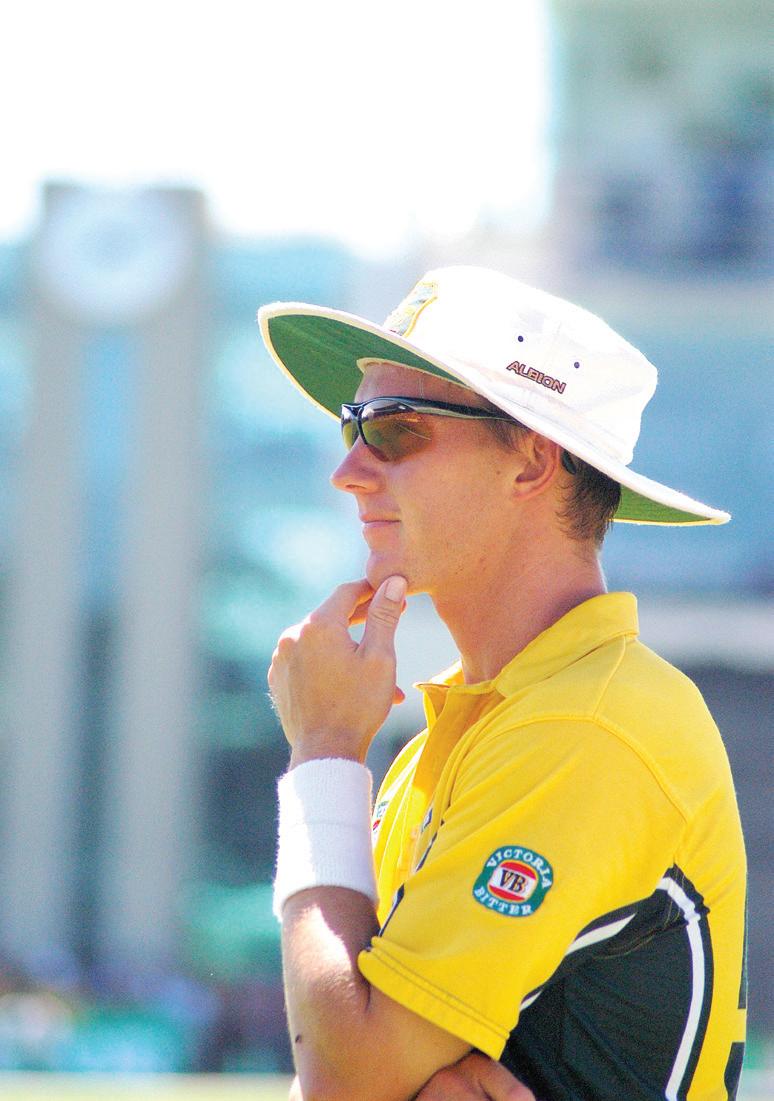
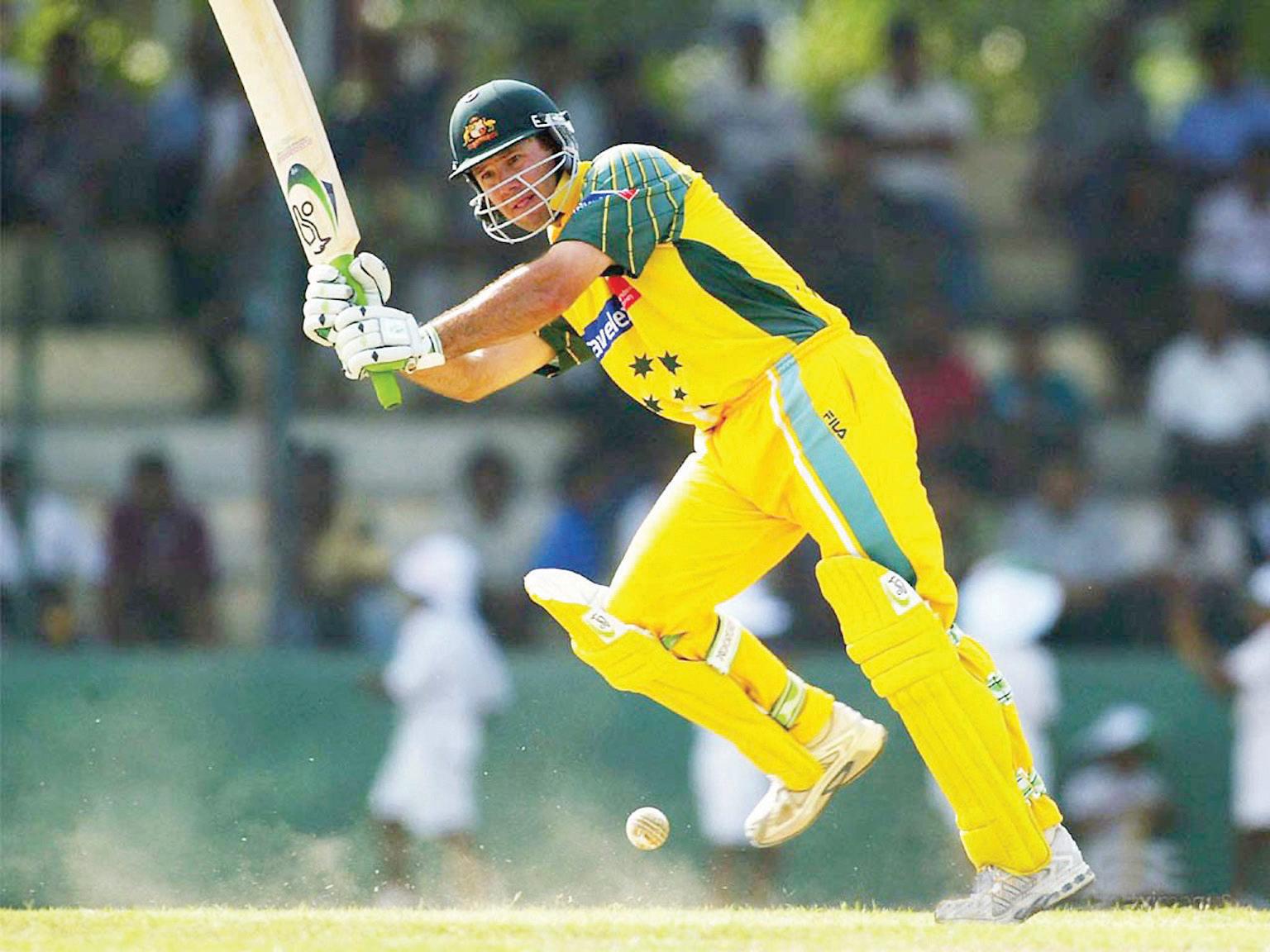
On the flip side of the coin, the leading wicket taker in both Test Matches and ODIs, Muttiah Muralitharan has announced he will retire from ODIs after the World Cup, which will mark the end of his stellar international career. This will also most likely be the last World Cup for players such as Kumar Sangakkara, Mahela Jayawardene, Younis Khan, Virender Sehwag, Zaheer Khan, Andrew Strauss, Brad Haddin and certainly will be the last one for Jacques Kallis, Shoaib Akhtar, Sachin Tendulkar, Ricky Ponting, Michael Hussey and Brett Lee. The 2011 World Cup will also mark the end of Graeme Smith and Daniel Vettori’s reign as captains, and perhaps a few others by the time the tournament is over.
It’s hard to pick just one favourite given the nature of the teams and the format. Barring a stunning run from one of the minnows, the top eight teams should easily qualify for the knockout rounds, and from there it’s almost a coin toss as to who will reach the semis and ultimately the final.
FEBRUARY (1) 2011 <> 57 NATIONAL EDITION
www.indianlink.com.au SPORT
Last appearance for stalwarts (clockwise from top) Sachin Tendulkar, Ricky Ponting, Michael Hussey, Brett Lee, Jacques Kallis and Shoaib Akhtar
Orissa Overtures

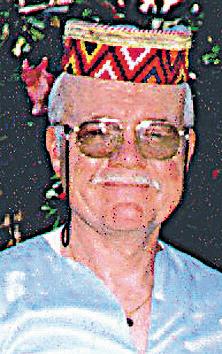
From its pristine rural beaches to its magnificent historic temples and museums, this gem in eastern India is worth discovering
is being planned near Puri.)
BY THOMAS E KING
Two sun-seasoned nolias sit near each on the windswept sands at Gopalpur-on-Sea, mending their nets. It’s late afternoon, yet these local fishermen are still absorbed in work despite having already completed more than a full day’s toil. The nolias of eastern Orissa arise early and set out upon the dark waters of the Bay of Bengal before sunrise in often rather ramshackle wooden boats. Later in the day and back on shore they unload their catch before ready buyers and then start preparing for the next morning. It’s a cycle that’s been repeated for as long as anyone can remember. The duo chats quietly as I crouch low to take photos, trying to capture the flavour of local life in seaside Orissa.
Gopalpur-on-Sea is a sleepy town. There’s not much excitement with little animation apart from the daily activities of the nolias and the constant crashing of waves on the beach. In the tiny town centre, 100 metres or so back from the beachfront, I watch school children wield cricket bats and then furiously wave as I walk by. Elsewhere, veteran vendors try their best to wring the last rupee out of customers buying fish that had been floundering in the brine only a few hours ago.
Gopalpur-on-Sea hasn’t always been so lethargic, I learned. In ancient days it was a port of significance with vast stocks of merchandise traded between this part of eastern India and various Indonesian islands and beyond, to other lands in Southeast Asia. I stood on the beach and gazed in an 180° arc to the expansive and occasionally turbulent bay. Commercial trade is still being carried out but large vessels bypass Gopalpur-on-Sea. On the horizon I could see a string of freighters and tankers laden with cargo shuttling up and down the watery ‘highway’.
The coastline of Orissa swings along the belly of the Bay of Bengal for more than 480 km. Punctuating the seaboard is a series of unruffled swatches of sand. Some beaches like those at Gopalpuron-Sea and Puri to the north are known, with adequate facilities developed for day tripping and weekend visitors. The majority of these are domestic travellers, however, as Orissa has yet to make an entry on the global leisure registry with an international standard beach resort. (During a 10 day tour in December
I learned that the state’s first mega resort, a holiday hub complete with golf course, convention centre, recreational hub and several 5-star rated hotels
Many beaches along the coast only have names; facilities are nonexistent. They remain virgin and untrammelled with only the green ‘fingers’ of encroaching creepers slowly advancing across golden sands. Perhaps they will remain this way as many of Orissa’s attractions are still little-known. This is certainly not the case down the coast at Chilka Lake where boatloads of visitors set off each day to enjoy a cruise and see an open sky aviary of birds nesting on islets in India’s largest body of brackish water.
Chilka is a geologic anomaly: the lake expands and contracts! At year-end when the lake is at its peak, the shallow body of water spreads over 1100 sq. km. Parallel to the Bay of Bengal and back-dropped by a range of evergreen hills, a 60 km sandbar divides the bay from the lake with only a small channel connecting the two. As the state - indeed India - heats up in April and May, Chilka Lake diminishes in size to a mere 600 sq. km. In spite of sweltering conditions, boating is popular then and throughout the year as visitors have constant access to a flotilla of craft in which to navigate the lake.
A boat, in fact, is the only way to reach a lovely shrine in the middle of the blue waters. The lake, as I discovered, protects an island that’s long been a pilgrimage centre. After a 30-minute motorboat ride on the seven seat M.L. Spoonbill we reached Kalijai Island where the diminutive Shakti shrine is dedicated to the goddess of the same name. A celebration is held every year on the tiny isle to honour the deity.
There was no frenzied activity on the day I visited the island along with guide and historian D. Rath. The knowledgeable tour escort pointed out a large tree in front of the shrine. Its lower branches were nearly covered with bands of red string and yarn. Couples come here to pray for children, he said. In the higher branches of the tree, barren of such tangible requests for blessings, birds watched the ongoing rituals below.
The cooler months are the best times for visitors, as well as birds. Chilka’s inviting environs are, in fact, bird central from October to February when up to 150 species of migratory birds descend upon lake-located isles for an extended break from winter. Geese, herons, osprey, pelicans, white-bellied sea eagles and even flamingos from the Persian Gulf are winter stars. With luck, visitors might also see Irrawaddy dolphin frolicking in the placid waters near Satpara, the place where lake meets bay.
The Indian winter is far warmer than where the birds began their long journeys. Departing from Iraq, Iran, Kazakhstan and even Siberia, these high flyers arrive to stay for the winter. For three months they rest and recuperate, feasting on prawns, moss and other lake nurtured delicacies until the advancing heat necessitates a mass departure.
Should the crowds at Chilka overwhelm it’s not far to escape to a haven in the hills. Taptapani is a mere hour’s drive inland from the lake, yet the two places seem to be a million miles apart. Set amid thick forest, Taptapani is more than a rustic retreat. It has a bubbling hot sulphur spring with claimed medical qualities. A temple embraces the source of this magical cure-all.
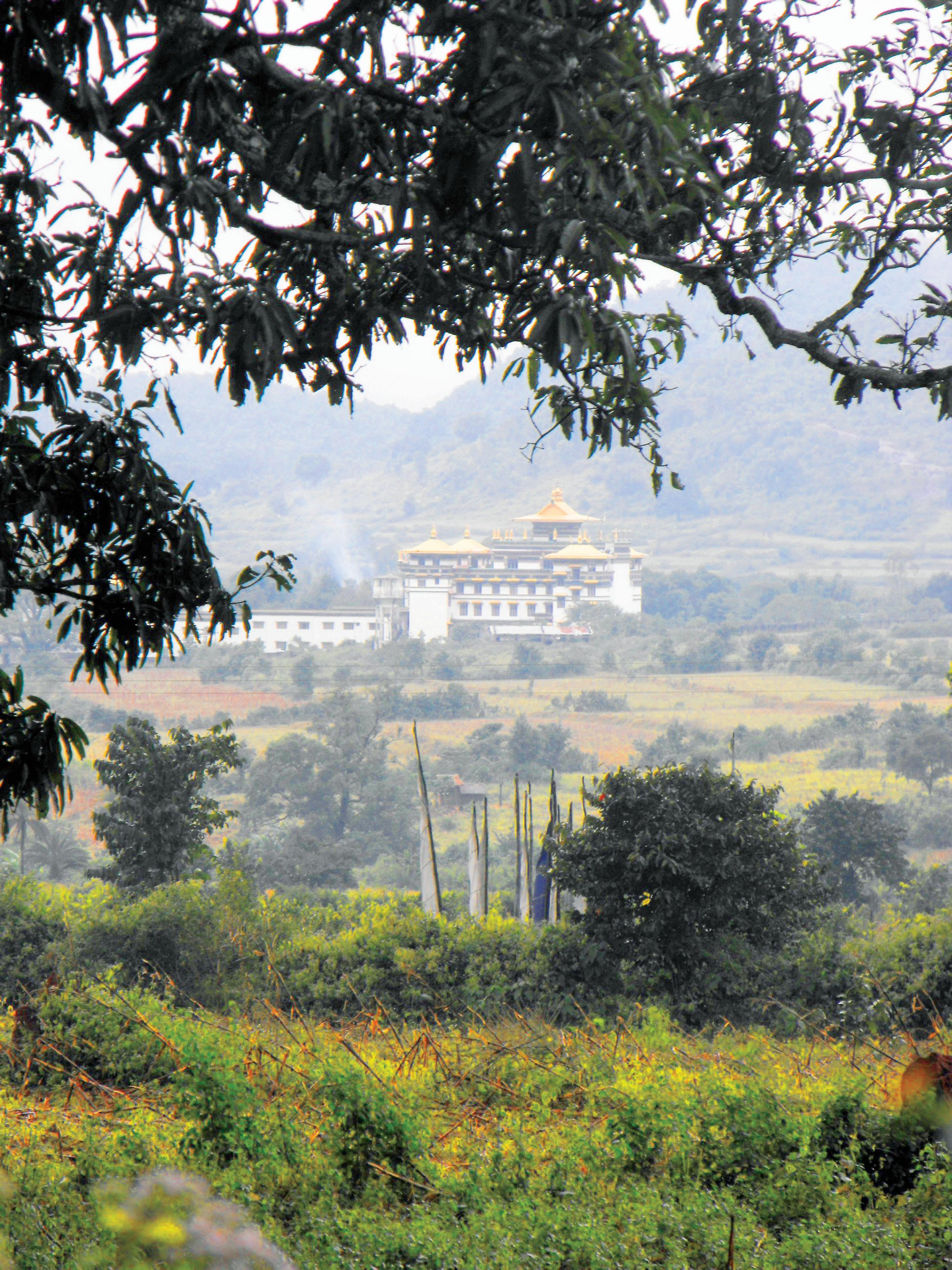

After driving through stands of sal and teak, we reached Taptapani. It had changed little since my first visit in the early 1980s. Taptapani still doesn’t have any brassy resorts or classy hotels. There’s only a simple property run by Orissa Tourism. The one redeeming factor of the lodge is that several rooms have immense bathtubs connected directly to the hot spring.
I did see a few small changes in Taptapani. The road is a little better and, of course, this relatively remote place now has mobile phone coverage and satellite TV with a multitude of channels. The small school is still there, as well as a few roadside tea shops. Fortunately its overall tranquillity remains the same and it was mentally refreshing to be up at dawn and watch the sunrise over the intensely green forest canopy. Cottony clouds waltzed over the jade coloured foliage intensifying the idyllic beauty and reinforcing the tranquillity of this scenic, serene and sublime sanctuary.
58 <> FEBRUARY (1) 2011
TRAVEL
1
In ancient days (Gopalpur-on-Sea) was a port of significance with vast stocks of merchandise traded between this part of eastern India and various Indonesian islands and beyond, to other lands in Southeast Asia.
1. Stop at Pipli where talented artisans specialise in colourful appliqué handiworks.
2. Beyond Taptapani is Lobersing where many Tibetans have settled and built a monastery.

3. In the afternoon, fishermen gather to repair nets on the beach at Gopalpuron-Sea.
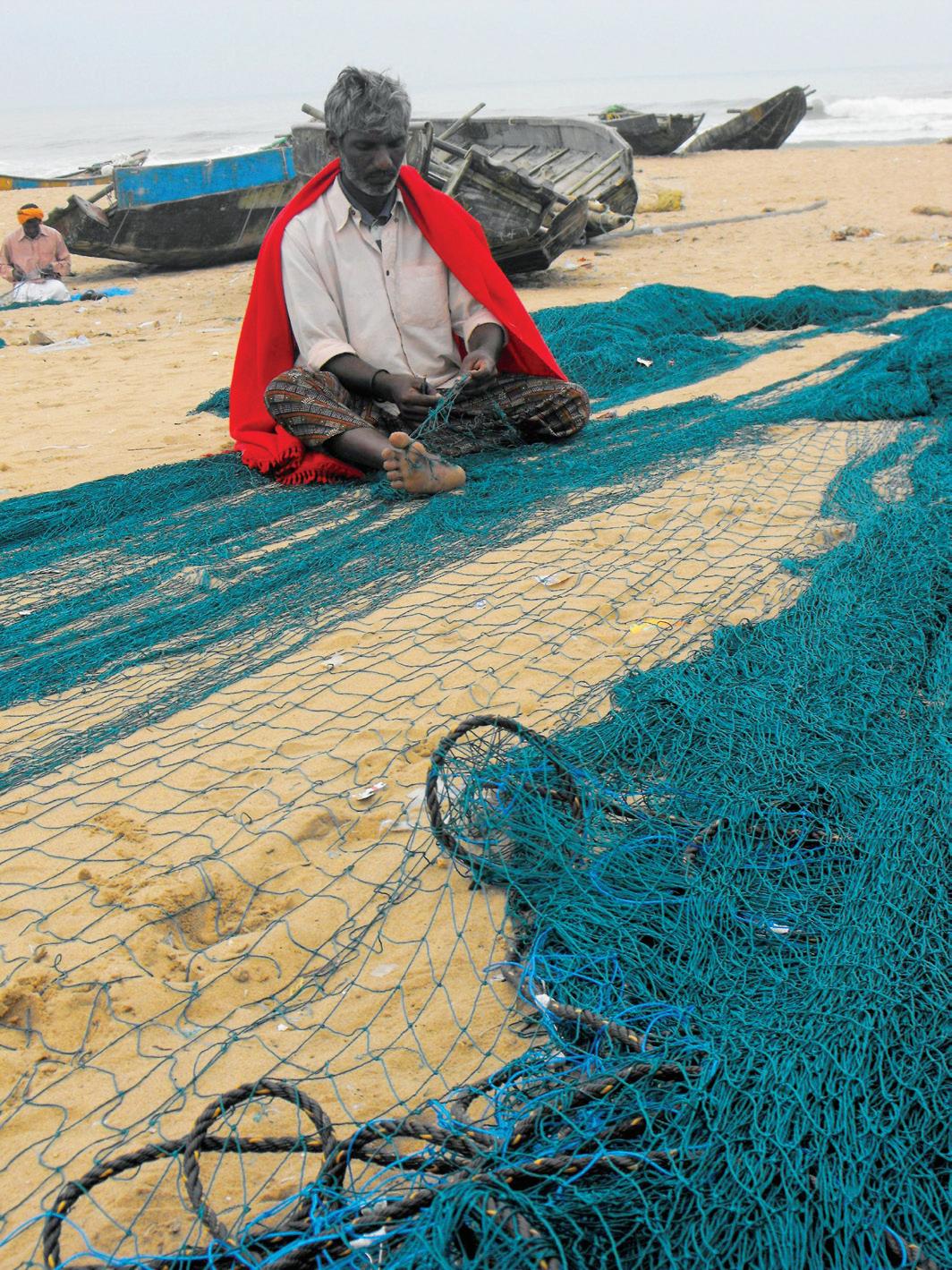
4. Explore Chilka Lake, Asia’s largest body of brackish water, to see islands and birdlife.
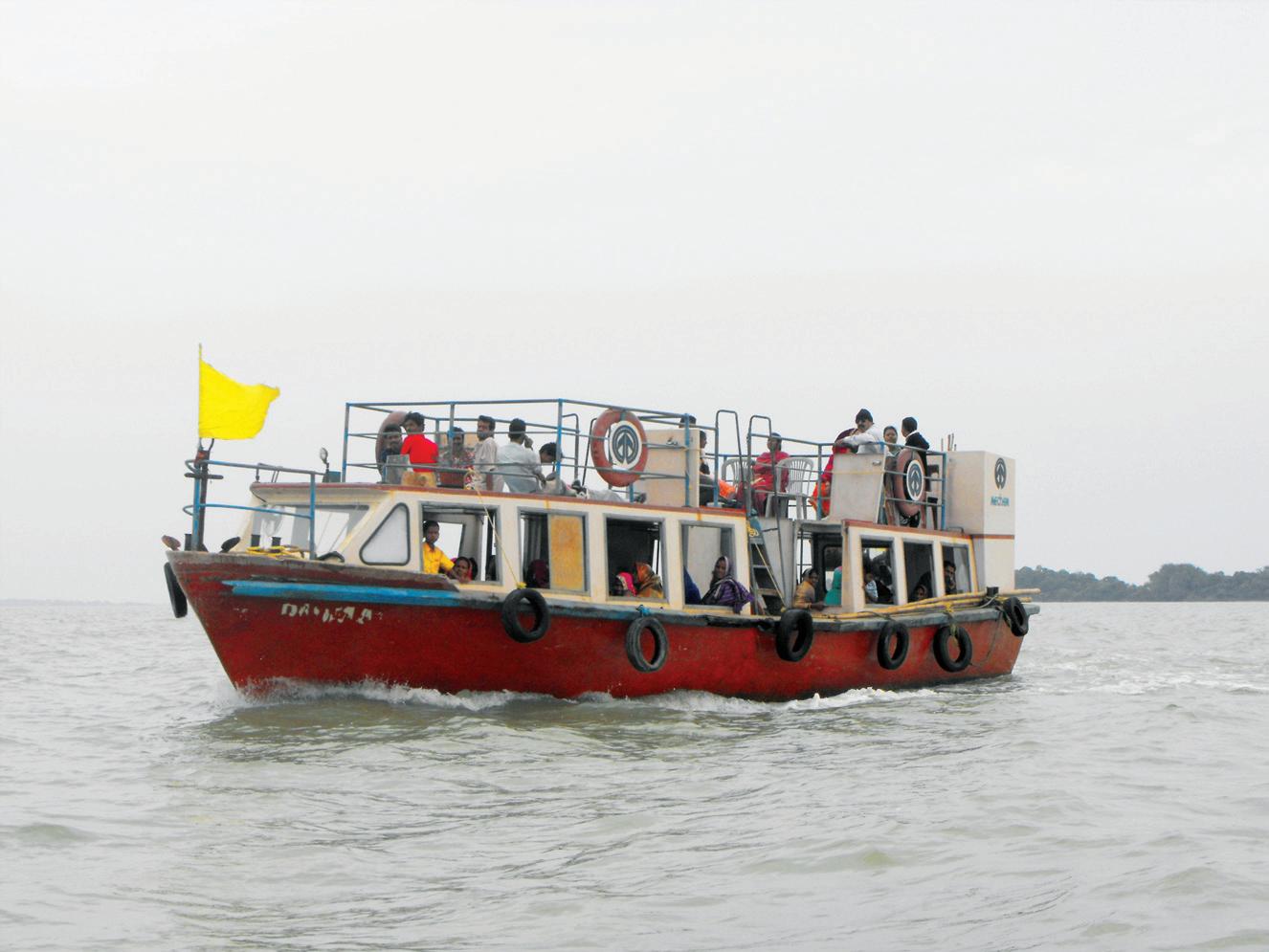
5. Set in dense evergreen forests, Taptapani is a hot springs retreat an hour from the sea.

Travel notebook ORISSA
FLIGHTS
Thai Airways International has 44 flights a week linking Sydney, Melbourne, Brisbane and Perth to Bangkok with daily onward services to Chennai and Kolkata, convenient gateways for Orissa. Contact travel agents for the latest airfare specials and promotions or THAI reservations on 1 300 651 960. See www.thaiairways.com.au
TRAVEL
A customised tour of India can be devised by flying to Kolkata, proceeding by road to, through and around Orissa before continuing on to Chennai for the return journey to Australia. Boutique travel specialist, Beacon Holidays can design customised ‘airport to airport’ tours of Orissa and all other parts of India with English speaking drivers, air conditioned cars and choice hotels. To discuss personal travel interests and tailor make your itinerary in Orissa contact Beacon Holidays by phone 1800667791 or e-mail mytrip@beaconholidays.com.au. See www.beaconholidays.com.au
CAPITAL EXCURSIONS
The magnificent temples and fascinating museums of Bhubaneswar make it imperative to spend a few days in the state capital. Beyond these attractions are striking monuments that reflect a synthesis of Hindu, Buddhist and Jain ideals. Orissa also retains many links with its ethnic heritage. Bhubaneswar is the venue from late January until early February for the Tribal Fair where the art, craft and culture of the state’s 62 ethnic groups is on display. Don’t miss the comprehensive Tribal Museum with ethnic displays.
ACCOMODATION
Orissa’s capital city has a wide range of accommodation from the money-saving OTDC Panthanivas to mini ‘palaces’ of style and comfort like the Trident Bhubaneswar. Set over 14 acres, the garden-sited and architecturally inspiring 62-room Trident is a service-oriented haven of tranquillity dishing up delicious Orissan specialities.
See www.tridenthotels.com/bhubaneswar
INFORMATION
Contact India Tourism Sydney for general information on Orissa. Tel (02) 9221 9555 or e-mail: info@indiatourism.com.au See www.incredibleindia. com. There’s an information-stocked division of the Government of Orissa Tourist Office off Puri Road in Bhubaneswar, and smaller centres in other places of tourist interest. E-mail ortour@orissatourism.gov.in
See www.orissatourism.gov.in. Lonely Planet’s India with its lengthy chapter on Orissa remains the definitive guide to the massive country.
See www.lonelyplanet.com
FEBRUARY (1) 2011 <> 59
www.indianlink.com.au 4 3 2
BY AKRITI GOEL
The thing about a break up is that no matter how prepared you are for the relationship to end, no matter who was the person to initiate the break up, or how much you didn’t like being in the relationship any more, it still takes a toll on you.
The first few days after a break up are always a daze. Just like the post-break up scenes of a Bollywood movie. Things around you are grey and sad, and pretty much every thing you see is a reminder of the ‘ex’, who you haven’t even started calling your ‘ex’ yet!
Now, we’ve seen our share of ‘break’-based movies, be it Hollywood or Bollywood: The Break-Up, The Rebound, Love Aaj Kal, Break Ke Baad... All good entertainers, but what we really think is that movies have humorised, glorified and romanticised break-ups way too much for us normal folks to deal with them realistically when they happen to us!

So here are a few things that will happen after a break up, and here’s how you could deal with them. There are two broad categories:


(a) The Breaker-ups, or the ones who have ended the relationship
(b) The Broken-ups, or the ones who have been told the relationship has ended
Here’s what you do if you fall in the (a) category
1. Take the direct line
Often when you break up with someone whom you have been in love with but aren’t anymore, you tell them everything apart from what you are really thinking. This is mostly because you still care about the person and you don’t want to hurt them any more than you already have. So instead of telling the truth about why you are breaking up (you don’t love them anymore,
you don’t see a future with them or you have given up on the relationship), you say things that sound more like ‘I don’t know’, ‘Maybe it wasn’t meant to be’, ‘I still love you, but it won’t work’, or the famous ‘It wasn’t you, it was me’. Don’t do that. Being direct is the kindest way. It leaves no place for halfhearted, awkward and confusing feelings.
2. No seconds
If you thought that breaking up was the hardest part, think again. Sticking to your decision about breaking up is ten times harder. There will be guilt, second thoughts, you will reminisce about sweet memories and, to top it all, you will feel very sad.
It’s okay, feel what you are feeling, be miserable, but stop the moment you start questioning whether you should have broken up or not. There were obviously reasons strong enough for you to take this step. Don’t forget those reasons. You and your ex both deserve to be with people who are committed to the relationship a hundred percent.
3. No friendship, thanks!
So you probably think that just because you and your soonto-be ex can’t be lovers doesn’t mean you can’t still be friends. Maybe you are right. But not right now!
Breaking up is hard, you realise that; it is actually one of the reasons you want to remain friends with your ex, to help them, to make sure they are okay, to support them through the break up. But the reality is that you can’t help someone through your own break up! It is confusing and taxing and ultimately, someone will get hurt. Again.
So the best thing to do is go your separate ways, and if in the future when you are happy and yourself again, and you still want to be friends, get in touch.
Now for category (b), the ‘Broken-ups’
1. Pity, no entry
Yes, guys have it tougher. You were happy, satisfied and willing to work on whatever problems came up, but from nowhere your partner drops this bomb on you. You break up. So what do you do now? You cry, you get angry, you throw stuff at
them maybe, and then you get over it. When you break up without being the initiator, in other words when your partner breaks up with you, it is natural to feel sad and sorry for yourself. But eventually, you have to remember what an awesome, confident and brave person you are, and that no one is allowed to pity you! Not even yourself.
2. Don’t go back
Do you really want to be with the jerk who just broke up with you? No! Tell yourself that each time you think you should go back and save this relationship. Yes, sometimes you have to be Imran Khan from Break ke Baad and bring back your clueless partner to save them from themselves, but be honest. Is your relationship really that Bollywood? Is your partner really that oblivious, and do you actually deserve to be with someone who can’t find happiness in being with you?
3. You know what you did last summer
You already know what you did, so please don’t fall into the sad and utterly useless pattern of thinking and wondering what you did wrong. Maybe you did everything wrong and maybe you were a perfect angel throughout the relationship, but what you did then holds very little value right now. You have broken up, and regardless of whose fault it was, the real goal is to come out of the break up with dignity and self-respect.
Things around you are grey and sad, and pretty much every thing you see is a reminder of the ‘ex’, who you haven’t even started calling your ‘ex’ yet!
Finally, a note for all those who have broken up, either by choice or involuntarily.
Please know, dear people, that no matter how much it hurts right now and how much you think things could have gone differently, there will be joy in your life again, your wounds will heal, you will smile again. And please believe, without a shadow of doubt, that you will fall in love again.
60 <> FEBRUARY (1) 2011 INDIAN LINK
Breaking up is never easy, I know, but I have to go… It’s a fact of life that relationships fall apart, but dealing with the situation from either side of the fence can be the hardest thing
www.indianlink.com.au RELATIONSHIPS
What’s in a Rose?


Most people look to celebrate Valentine’s Day through the traditional offering of flowers –and roses are the obvious favourite. FARZANA SHAKIR on the message behind the flower

With Valentine’s Day fast approaching I bet everyone is feeling the excitement of love in the air.
Flowers, gifts, cards with secret messages, chocolates and loads of mystery are all part of the Valentine’s Day tradition. Now the rose is considered to be one of the greatest symbols of love and appreciation, so naturally this evocative and redolent flower is the number one choice for Valentine’s Day. Indeed, like they
ROMANTIC RED
Nothing says ‘I love you’ quite like a bouquet of red roses. It is considered to be the traditional symbol of love and romance. The colour red in a rose signifies romantic love, beauty, longing and desire. It can also be used to convey feelings of respect, devotion and admiration. But if you receive a bouquet of red roses from your boss, it can easily mean ‘Congratulations on a job well done!’ There’s a lot in the numbers where red roses are concerned, for example, the ever-popular bunch of a dozen means ‘I love you’ and ‘Be mine’.
ORANGE ARDOUR
With their fiery blazing hue, orange roses signify passion and energy. They convey the message of intense desire and fascination by the sender for the receiver. If you receive orange roses this Valentine’s Day you’d be safe to assume the sender desires you or desires to get to know you better. Second only to red roses as a harbinger of love, the orange rose represents excitement, energy, pride, fervour and romance.

VALIANT BLUE
perfect blue rose is hard to find. It is elusive as it does not occur naturally and is very hard to reproduce, so the interpretation of a blue rose is that of the unattainable or the mysterious. They represent a desire to attain the inaccessible. So if an admirer sends you blue roses, he is admitting and lamenting that he can’t stop thinking about you even though he knows he can’t have you, that you are the object of his desire but something that’s unattainable and impossible. If your partner bestows blue roses on you, he is basking in his good fortune at having bagged someone like you who he considers a rare find.
say, ‘the rose has been a favourite flower of poets since poetry began. Maybe it’s because like a poem, a rose can say so much without saying much at all.’ But with so many different colours of roses to chose from, I’ve often wondered about the unique meaning behind each rose tint. So, this V-Day, to help make the interpretation of true feelings behind every bud or a bouquet given or received more significant, here’s a guide to the particular significance of different colours.
PLEASANTLY PINK
Generally pink roses are used to convey gentle emotions like innocence, appreciation, joy and admiration. Different shades of pink can connote different emotions from the sender. For example, deep pink roses are sent as a thank you gesture, conveying gratitude and appreciation. Regular pink roses represent happiness. Hence if you’re blissfully happy in your relationship, pink’s the way to go in roses for your partner on Valentine’s Day. Light pink on the other hand can mean ‘sympathy.’ So if a friend or loved one is mourning a loss, light pink roses can be used to express condolence.

LOVELY LAVENDER
You have reasons to feel over the moon if you receive lavender roses, because they symbolize falling in love. If someone sends you lavender roses they carry the simple and subtle message that you are the object of their love and they are enchanted by you. Traditionally this coloured rose is used to express feelings of love at first sight. Lavender is the colour of enchantment and that is what it symbolizes in a rose: fascination, adoration, splendour and also a degree of royalty.

BLACK FINALE
Black roses like the blue ones are not easy to find, and many believe they don’t actually exist. One theory is that black roses are in fact really dark red roses that give an illusion of being black. Black is the colour of mourning and death and they signify the death of a feeling or an idea. If someone sends you black roses it indicates the end of a relationship or a farewell of some kind.
HAPPY YELLOW
Yellow roses symbolize friendship, joy and care. Being the colour of the sun it subconsciously evokes warm, happy feelings often shared by friends. If you wish to send flowers to a friend to say that you care for them, yellow roses can be a perfect choice. Similarly, if you receive yellow roses from someone don’t jump to the conclusion that they have a romantic interest at heart; it simply means that the sender is happy and grateful for your friendship which he prefers to keep platonic.

WONDERFUL WHITE
What colour comes to mind when you think of innocence, purity and chastity? Of course, the colour white. And so is the significance of white roses that symbolize all of these characteristics and more. White roses are associated with new beginnings and hence their popularity as bridal bouquets. They are also used to communicate feelings of sympathy and spirituality. When combined with red roses in an arrangement, the two rose shades signify unity. Secrecy, humility, youthfulness and silence are also some traits associated with white roses.
A M I X E D
B U N C H
And then there are bunches of mixed roses. As is obvious by the arrangement, the sender is not quite sure how he feels about you but likes you enough to send you roses. His emotions and feelings are jumbled at present, but given time they could evolve into something meaningful.


FEBRUARY (1) 2011 <> 61 NATIONAL EDITION www.indianlink.com.au LIFESTYLE

62 <> FEBRUARY (1) 2011 INDIAN LINK
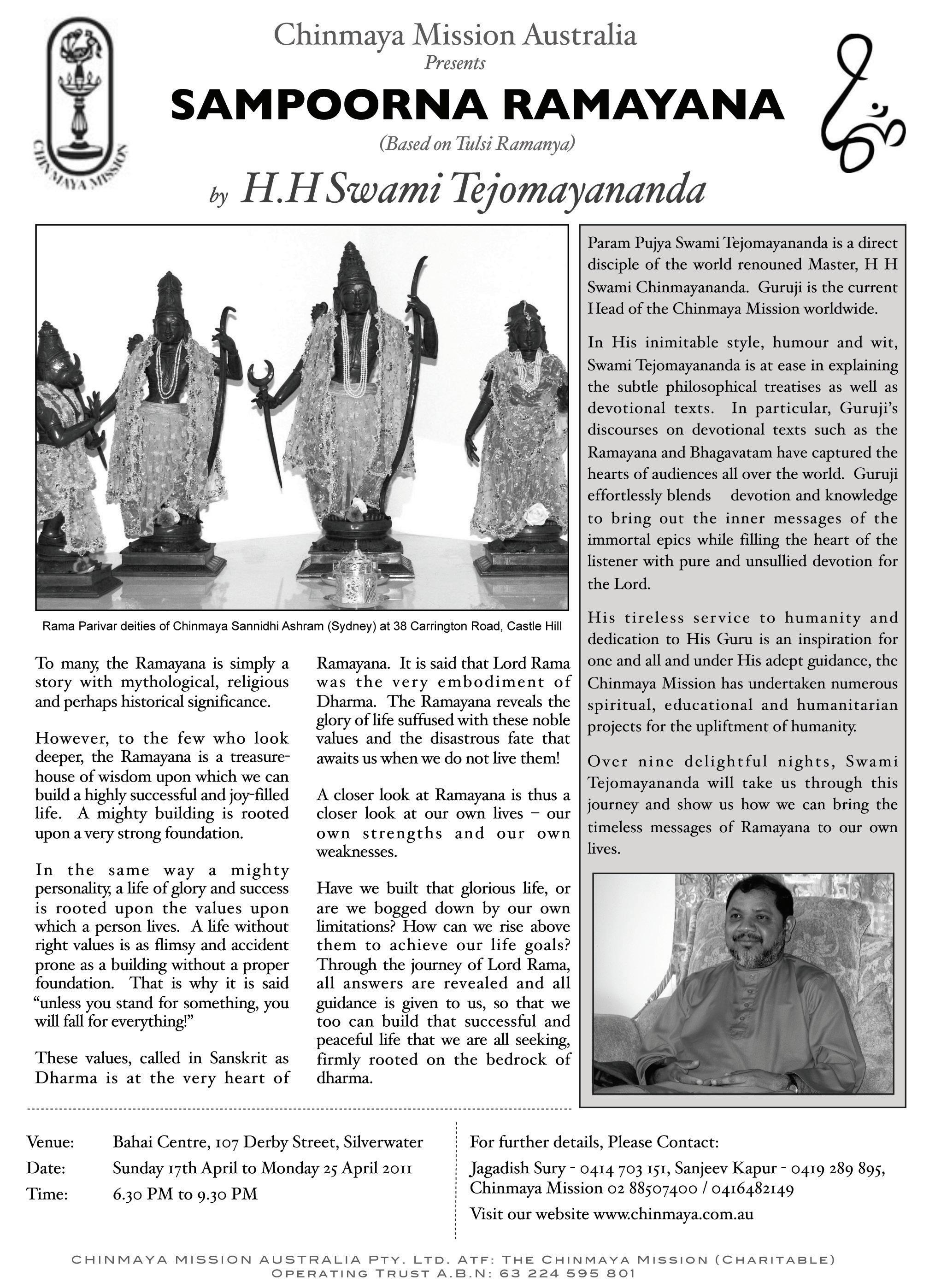
FEBRUARY (1) 2011 <> 63 NATIONAL EDITION
Fiji Marsala
From Fiji, the story of an Indian minority that has stayed true to its roots through marital bliss
government is total rubbish. The army is doing a terrific jobask anyone, they’ll agree.”
By the time we reached the village, Dev had invited me to join the wedding. An introduction to the father of the groom made it official and I was welcomed into the fold.

The big day
‘Girmityas’, were shipped from Bengal and other parts of India home after their contracts expired but most stayed on, forever changing the social landscape of this dreamy South Pacific nation. According to the Fiji Islands Bureau of Statistics’ most
But unlike most migrant groups that settle in faraway lands, Indo-Fijians have wholly retained their genetic and cultural identities. Historians attribute it to the legacy of race-based prevented assimilation between Indo-Fijians and their native
But the argument discounts Indo-Fijians’ love for all things ‘Indian’ and their ineradicable desire to incorporate them in their day-to-day lives. Most have never been to India nor do they aspire to, yet the vast majority speaks Hindi. Many IndoFijian women still dress only in saris, while Hindu temples and shrines pockmark the land. And they’re absolutely fanatical about curries - an affliction they seem to have passed onto their hosts.
But the real buffer to assimilation is their taboo against intermarriage. It took root in the colonial era when the practice was forbidden and has been flamed over the decades by Hindu notions of racial purity. Today, 95 percent of IndoFijians marry their own kind.
A chance invitation
To get a true measure of what it means to be Indo-Fijian, one must attend an wedding ceremony. Wrangling your way into one isn’t overly difficult. They usually take place under canopies on roadside locations and if you wander too close you could be dragged into one - like it or not.
My crash-landing at an Indo-Fijian wedding was less deliberate. I was on assignment the Sabeto Valley - a velvetgreen basin 15km north of Nadi - when I heard a hullabaloo of horns. A cavalcade of cars and buses came speeding down the road, the lead vehicle adorned with a mesh of pink garlands. I stood aside and took in the spectacle until one of the last cars pulled over and an Indian gent stuck his head out. “Where you going?” he asked.
“To next village,” I answered.
“Jump in, I’ll give you a lift.”
His name was Dev Mishrada and he was born in the Sabeto Valley. After studying diesel engineering in Auckland he migrated to Sydney where he now lives with his family, not far from my home.
“When I left in 1980 things were not very good,” he said. “The people were oppressed. There was lots of discrimination. But now the new government is doing everything for the people; you can see how happy and content they are.”
Mishrada’s support for the government of acting Prime Minister Frank Bainimarama - the military headman who seized power in a bloodless 2006 coup and who is considered a pariah by the international community - is not rare among Indo-Fijians. Better said, they positively adore him, crediting his administration for dismantling much of the institutionalised racism that hamstrung racial harmony between Fijians and Indo-Fijians for more than 120 years. They also laud him for improving the lot of the nation’s poorest, a disproportionate number who are of Indian descent.
“It’s the first time in history things have been like this,” Dev enthused. “Crime has fallen to next to nothing; if someone hurts a tourist or messes with a kid, they will be arrested in half an hour. All the children are going to school because it’s free. I promise you, everything you hear about Fiji and the bad
The ceremony began on a strip of grass outside the canopy where, one by one, the bride’s mother, grandmother, sisters and aunties applied kumkum to the groom’s temple and threw flowers over his head to drive away any impure thoughts.
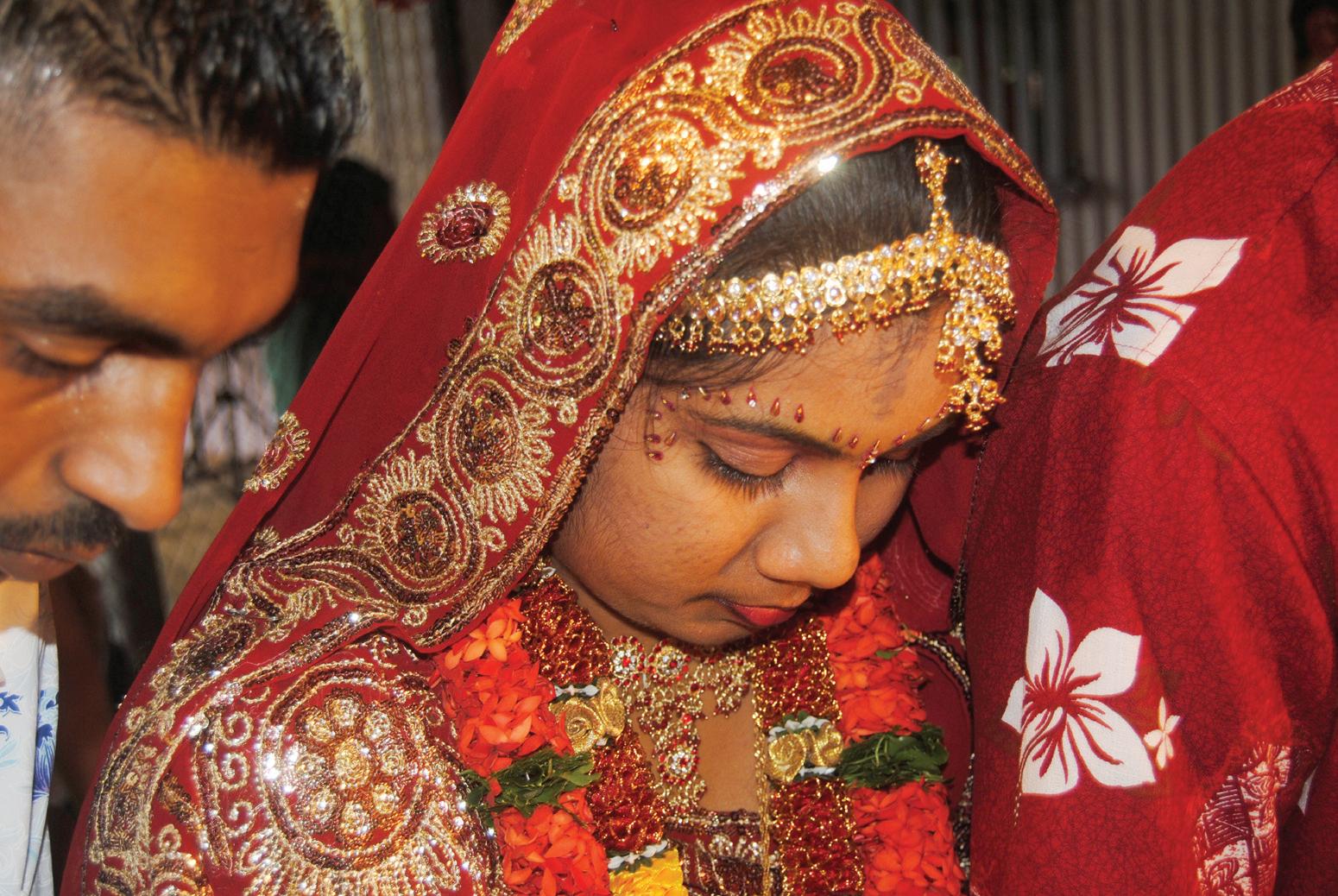
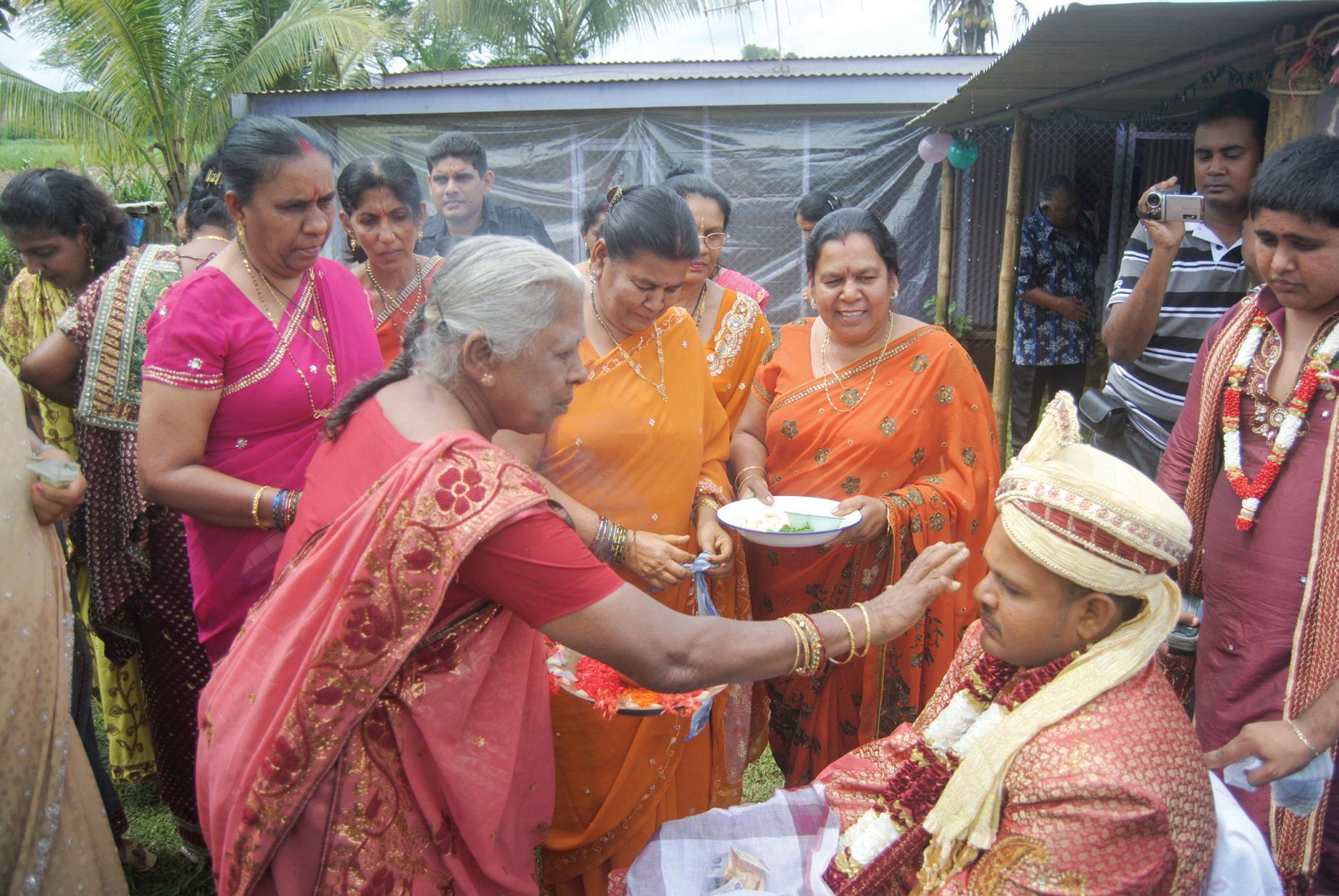
The participation of relatives is dead important here, for a Hindu wedding is more than the marriage of two people. It’s the marriage and merger of two families.
It was followed a private blessing by the Hindu priest in Sanskrit that went on for the best part of an hour. All the while the groom remained tightlipped with a deeply solemn look on his face, as did the bride when she was finally walked down the aisle. Her dour outward appearance did not waiver when she reached the alter – a psychedelically decorated marriage canopy resembling a Jewish hoopa at the centre of which stood a Christmas tree-looking agni, the representation of the sacred fire. Later in the ceremony, the bride and groom would circle the agni seven times, reciting seven promises encapsulating love, loyalty and commitment - the building blocks of their new relationship.
The ceremony was lengthy and elaborate and involved a colourful array of props the priest used to teach the couple about the duties of marriage. Family members sat behind them in rows, cross-legged on the floor, while the guests, about 200 of them, sat on thin wooden benches - women on one side and men opposite. And a loud Hindi band played between religious citations.

The bride’s father put his daughter’s right hand into the groom’s while reciting sacred verses and with that, the couple were officially wed.
After an hour or so I lost the ability to concentrate and sauntered around to the back for a chat with some of the other guests. I learnt how the caste system that so cruelly subdivides people in India along socio-economic lines is non-existent in Fiji, and that Hindu and Muslim Indians, which have long been at loggerheads in the subcontinent - get along famously here. “When my great, great grandfather was brought here with Muslims and Punjabis, they all had to do the same work so they had to compromise and treat each other as equals,” said Salanda Kumar, an uncle of the groom who now lives in San Francisco.
I was also told the official story about how the Girmityas arrived in Fiji - after signing an agreement, or girmit in pidgin English, to work for five years at one shilling per day - is a revisionist version of history. “They were tricked,” explained Vinesh Chand, a local cassava farmer. “They were told they were going to a tropical island a few days sail away and that there were many riches there, but as soon as they walked onto the ships the doors closed behind them. Some of them had to spend months waiting at port for the ship to fill up.”
“When they arrived in this country,” added his neighbour Vinod Prakasha, “they were whipped and put to work on sugar farms. They were not used to the conditions and life was very difficult.”
At the two-hour mark, the children and elderly moved to the dining area to eat. The food was strictly vegetarian but in no way bland: cinnamon fried rice, curried potato and eggplant, mango chutney, cucumber salad, coleslaw and roti baked fresh in a clay oven. The ceremony concluded with the kanyadaan, the giving away of the virgin. The bride’s father put his daughter’s right hand into the groom’s while reciting sacred verses and with that, the couple were officially wed. And while the proceedings would continue for several more days, the brief but colourful interlude gave me Technicolor insight into the strength and vitality of the Indo-Fijian community.
64 <> FEBRUARY (1) 2011 FEATURE







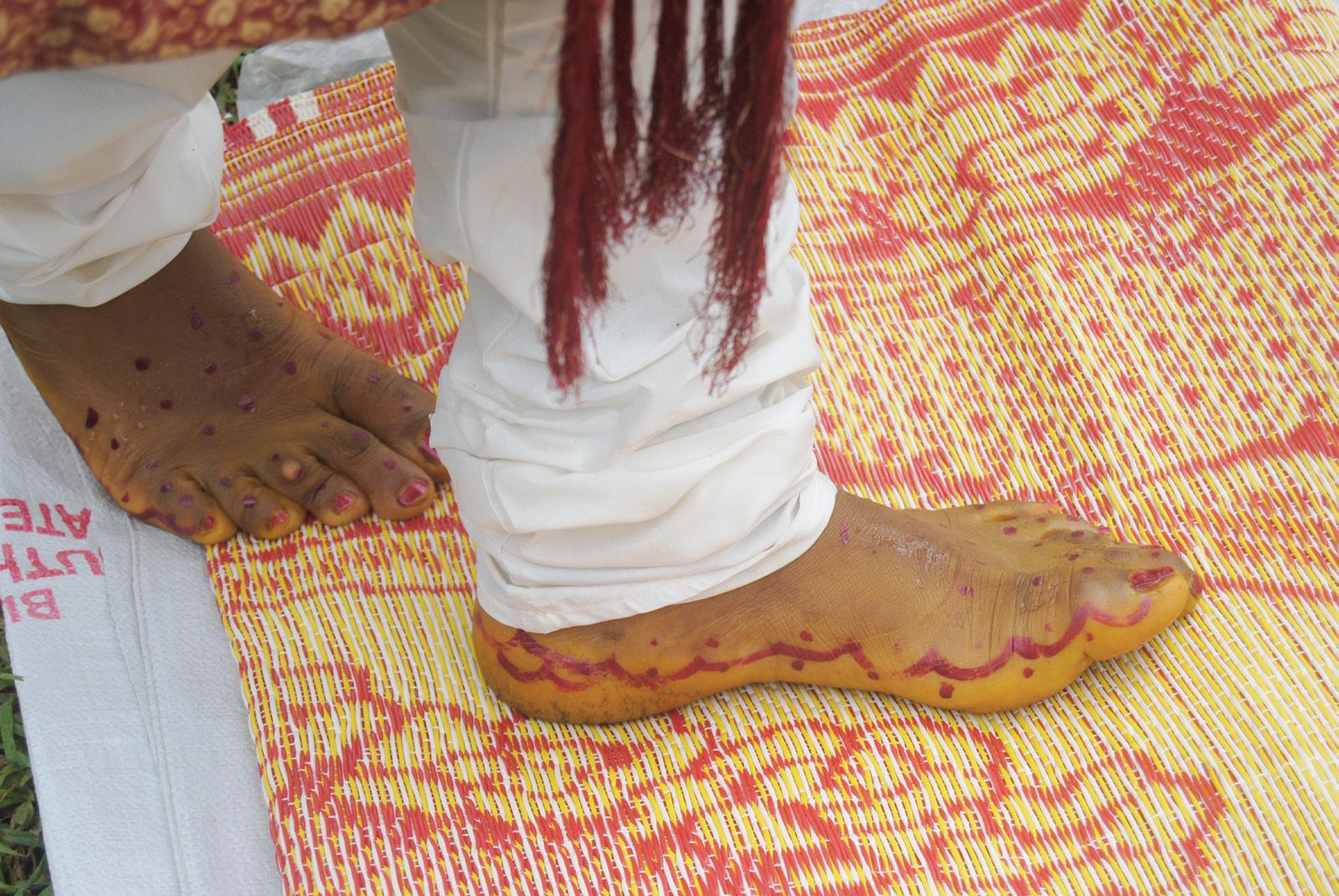


FEBRUARY (1) 2011 <> 65 www.indianlink.com.au

66 <> FEBRUARY (1) 2011 INDIAN LINK



FEBRUARY (1) 2011 <> 67 NATIONAL EDITION

68 <> FEBRUARY (1) 2011 INDIAN LINK
Soothing the sizzle
BY RAJNI ANAND LUTHRA

Sydney’s weather has been unpredictable, to state the over obvious. One week we’re sweltering away in a record heat wave, and the TV shows us images of people soaking in the ocean and spending the night on the beach. The next week we’re hunting out cardigans and jumpers.
But the heat has been stupendous! We’ve OD-ed on yogurt and lassi, and I even tried that traditional Delhi summer drink jaljira which I’m happy to say, my kids enjoyed too, it was that refreshing! Of course I used the store-bought mix, and simply added chilled water and fresh mint, but for those of you who don’t know, this is like a spiced lemonade, a bit extra salty. It is made of roasted cumin, mint and coriander paste, amchur (dried mango powder), rock salt, sugar, ginger and lemon, all of which make it a tangy, sizzling drink that cools you with the very first sip. (The extra salt helps to replenish essential body salts that are lost in perspiration). As a beverage, it can be drunk before meals as an appetizer, during meals as an accompaniment, or after meals as a digestive aid. But it is best drunk when you’ve just got into the house from the hot sun….
To make it even tangier, try making your jaljira with chilled lemonade instead of water. Die-hard jaljira fans will even sprinkle some boondi on top: non Delhiwallahs, you’ll never understand the sheer lip-smacking thrill of this!
If the jaljira has gone down so well, I thought to myself, I must try some thandai

Another traditional summer drink from the north of India, the very word thandai is Hindi for “coolness” and it does its job brilliantly - no need to say much more! Essentially this is a cold almond-milk drink, and as such, is quite decadent. It’s for the classes, let’s say - while the masses drink jaljira
The recipe is provided for you elsewhere on this page.
Serve in a tall glass with crushed ice. Decorate with almond slivers or powdered pistachios, or a clean rose petal.
You could also use other ‘cooling’ seeds like melon seeds ( magaz ), sunflower seeds or pumpkin seeds. The use of peppercorns, black or white, is also common, if you can handle the mix with the sweetness of it all. Or you can make a kaju-pista (cashew-pistachio) thandai instead of a badam (almond) one.
And of course there’s a ‘cheat’s version’ if you don’t want to go to all the hassle. But be warned, it is neither as healthy nor as tasty as the authentic item. Blend the seeds and nuts of your choice with water to make a smooth paste. Mix with 1 litre milk and 1 can condensed milk. Pass the whole mixture through a cheesecloth (discard residue), and chill. Serve with garnish of choice.
Thandai
1/2 cup almonds
1 1/2 cups milk
4 tbsp sugar
1 tbsp fennel seeds
2 tbsp poppy seeds
4 green cardamom
2 tbsp rosewater (optional)
A few strands saffron
2 cups water, or as needed
Heat milk with sugar until sugar dissolves completely. Put in saffron strands and keep aside to cool.
Dry grind fennel seeds, poppy seeds and cardamom to as fine a powder as you can get.
Soak almonds for about 10 minutes, then give them a whirl in the microwave for about a minute or so. Drain, and rub the almonds in a tea-towel to remove peel. Blend the almonds into a paste, adding just enough water. You might find you have to keep stopping to add more water.
When the paste is smooth, introduce the ground spice mix, and about half a cup of water. Blend again till smooth. Strain the mix through a fine strainer or cheesecloth. Retain the liquid.
Put the residue back into the blender, add another half cup water and blend again. Strain again to extract the liquid. Do this once more if you feel there is life left in the residue, or else discard.
Pour almond extract into cold milk, add rose water if using, and chill.
To serve, pour over crushed ice.
RSL TAXI
Taxi plates available for lease to suitable operators at attractive rates.
Good drivers also wanted for growing workload. Free Radio Training.
Call 8338 8955 during business hours 8.30am-16.30pm for further information

FEBRUARY (1) 2011 <> 69 NATIONAL EDITION
www.indianlink.com.au FOOD
Matrimonials
SEEKING BRIDES
Match required for India-born Jat Sikh boy, temporary residence going to apply for permanent residence, 25 year old, 5’10”, fair complexion, BSc (medical), diploma in horticulture, father Govt employee, brother in Italy. Looking for a girl from an Australiasettled family. Call 0430 472 878, or email bali_heer@yahoo.co.in
S eeking well-educated Hindu girl in Australia for 31-year-old, well settled Hindu Punjabi boy in Sydney. The boy has finished Masters in IT from Deakin University Melbourne. For further enquiries contact Nitin Gera (brother) 0401 279 200 or nitingera.work@gmail.com
S eeking a Gujarati girl with good family values, for my son, 35, divorced since 3 years, no children, tax consultant, fair, 5’8”, non-smoker, light drinks, eggetarian, living in Sydney since 18 years. Contact 0402 416 353 or hp11869@hotmail.com.
F iji Hindu, 52, dual Australian / New Zealand citizenship, living in Liverpool, Sydney, seeks Hindu wife from India or Fiji, age 30-45. Please email details / pics to ron_87singh@hotmail.com
M atch for Sydney-resident never married, 28 year old, slim, handsome, fair complexioned, Sood Punjabi boy, IT professional, 5’9”. Seeking Indian girl. Caste no bar, girl’s merit main consideration. Please call 0416 407 496.
citizen living in Sydney, seeks suitable match of honest girl with good family values. Caste no bar. Please reply with photo and details amit4012@hotmail.com or call 0431647402.
Seeking an alliance for Valmiki boy, 36, 5’8”, very well educated, LLB, MIB (AUS) government employee, Australian citizen. Parents are seeking a well educated, homely girl with traditional values. Caste no bar. Respond with photo and complete bio at valmikiboy@hotmail.com or call 0431 159 221.
SEEKING GROOMS
Patel family invites correspondence from upper caste Gujarat family for 1979 born, good-looking girl, 5’4’’. M.Com, government job in India, visiting Australia in March. Brother settled in Australia. Email biodata with photo, dips1988@gmail.com
Alliance invited for a good looking Malaysian Hindu Tamil girl, 30 years, 5’ 4” IT degree working for a bank in Sydney. Seeks Hindu Tamil professional or degree holder of good family background. Family members are Australian PR holders. Contact details 04 7802 4860 or email mahaworlwide@yahoo.com
For an Australian born, well educated and established 27-year-old female with similar values. Please forward a photo and full details to amdm01@hotmail.com
Dr. G. L Gupta settled in Australia since 1970 seeks match for Hyderabadbased grand daughter, DOB 7 Nov 1986, 5’ 4” fair with sharp features. Graduate in Commerce, PG Diploma in Banking and Finance from IFBI and working in ICICI Bank. Coming to Sydney. Seeking Hindu preferably Agarwal professional match. Contact 0401 448 186 / 0404 833 750. E mail giri32@yahoo.com.au
33-year-old Fijian Indian female seeks Hindu male 33-35, never married, Australian citizen, graduate, vegetarian and tall. She is tall, slim, vegetarian, never married, and has an Australian degree. Please send full profile with a recent photo to email arnj01@hotmail.com
Well established Indian Hindu family from Fiji living permanently in Melbourne seek a professionally qualified boy with good career background for their daughter, 28+. Five feet tall, medium complexion, slim, attractive, Australian born, University graduate. Please send in absolute confidence your biodata, telephone number, recent photograph and email address to The Advertiser, PO Box 339, Naree Warren South, 3805.
photograph at 0423 749 793 or email sujayinmel@gmail.com, sanchi26@gmail.com, or rjp5306@gmail.com
Seeking match for 39/165, unmarried, fair, slim, beautiful, Indian Punjabi girl, family oriented and responsible, traditional values, IT professional, brought up in India. Australian citizen. Early marriage. Can relocate. Serious enquiries only. Caste no bar. Email with photo: sydgirl09@gmail.com
Wanted well-qualified, handsome, fair Punjabi Hindu boy, well-settled in Sydney, PR holder/Australian citizen, for a Punjabi Hindu girl, extremely beautiful, slim, very fair, 32 years, 5’3”, MBA (Australia), Australian citizen and a professional belonging to a high status, very well qualified business class family. The girl is an innocent divorcee with a brief marriage. She is a very loving, homely, caring, intelligent and bubbly with a perfect blend of traditional and modern values. She is born and brought up in India. We are God fearing, very well-respected, down to earth and sober family with a positive outlook towards life. Similar profiles preferred. Please send full profile with latest photos to email to.sweet@hotmail.com
3
0-year-old Punjabi Brahmin male, 6 feet, fair, handsome, double degree holder, Reigistered Nurse, Australian

Seeking a 27-31-year-old male of FijiIndian background with strong social, cultural and religious values, preferably a non-drinker, residing in Australia or New Zealand, must be a University graduate, vegetarian and a non-smoker.
Correspondence invited from a wellto-do established young man aged between 31 to 36, for a charming, pretty Hindu girl of 32, working in India in an MNC as HR Manager, Bangalore India. Please contact with profile and recent
Punjabi Arora parents seeking wellsettled/professional match for beautiful, slim, unmarried, 37/ 165 IT professional with strong family values. Brought up in India, settled in Sydney. Australian citizen. Status family. Caste no bar. Early marriage. Email with photo: ausgirl101@gmail.com
70 <> FEBRUARY (1) 2011 INDIAN LINK
A sense ofsurvival
BY RANI JHALA
The water lashed against me, trying to dislodge my grip on the antenna above our roof. My hands were frozen and my wet clothes clung to my exhausted body. Worse, the horrible stench from the polluted water - a mixture of grease, kitchen refuse, human and animal waste - completely surrounded me. The land that I had known from my birth had vanished beneath the swirling waters.

The sun was setting, and the shimmering water made it even harder to concentrate on the task of holding on.
The water had risen with such lightning speed that it had been impossible to react in time, and eventually it had become difficult to save anything but ourselves. As the water rose, we watched our belongings go under. It had not mattered how high they had been piled up, the rising water taunted each item until finally swallowing it into its murky depths.
I am a farmer, and have loved the land on which I had been. That land had been all that I had even known, and it had provided for all that I had wanted. It was this beautiful land that had attracted my wife to tour our area. That’s how we met, at an Australia Day outback get-together. It had been love at first sight. I still remember the look of joy on her face as she saw my modest dwelling. The rambling land that daunted so many, had won her heart. We married six weeks later knowing that we had found the perfect partner in each other, though I continued to worry about how a city girl would cope with the laidback lifestyle of a small agricultural township. But she took to it as a duck takes to water, and we spent the most wonderful ten years together. Our life with our two children, innumerable pets and loving home, was picture perfect. Slowly we built that modest dwelling into a large modernised homestead and converted the ten thousand
acre land into a successful farming property.
And then in January this year, with just one mighty roar, a wall of water raced towards us and destroyed everything. It gushed into the house through the windows and took away every tangible evidence of our past, our history and our material possessions, sweeping them out through the doors.
My wife and children had been airlifted first by a UH-60 Black Hawk. To make room for my son, the SAS trooper had lowered himself back down to my side and kept me anchored as the helicopter flew its occupants to the closest evacuation centre. After it left, we continued to cling onto the antenna, waiting for the Black Hawk helicopter to return for us, while apprehensively watching the water rise foot by foot over the gutter line.
Away at a distance, I could see our car. We had packed it and were ready to leave, but we had gone back in to collects the pets. In hindsight now, it was lucky we didn’t get into the car for the swollen river had literally snatched it from in front of our eyes, carrying it away like an inflated toy, finally throwing it against the wall of the local primary school. I pointed it out to the officer.
“I’d offer to drive us, but I haven’t got my driver’s licence on me at the moment,” he joked and introduced himself as Trooper Michael Matthews.
His humour had been what I needed. During the next few minutes he kept me amused. The only subject he did not discuss was the flood and its destruction. I understood later when the psychologist explained the importance of the mind in difficult times, quoting that “survivors are those that never give up”. Michael had ensured that I did not surrendered to the mighty power of the waters that had already taken so much from me.
Twenty minutes after my wife and kids had been airlifted to safety, the Black Hawk returned. The blades created a gush of wind that tested my remaining strength. A cable was lowered. The trooper secured it around my waist and I was lifted up. Another trooper pulled me into the aircraft. The cable was
lowered again, and moments later Michael’s face came in to view. There was no more time for conversation as they rescued others like me, clinging to trees, poles, rooftops, water tanks or floating in boats and cars. As soon as the helicopter was filled to capacity we made our way to the evacuation centre.
Two hours later our family was reunited. It’s difficult to express the emotions I felt at that moment, for they were so varied. But despite all the tragedy and loss that we had suffered, I remained thankful. Thankful that my family was safe and united, for many had lost their parents, partners or children. I was glad that my wife had left digital copies of our photos and documents with my parents, for others had their past and keepsakes stolen from them. And I was hopeful of the power to rebuild; for unlike so many parts of the world where the unfortunate are forgotten with the downtide, I live in a country that will fight to rebuild the lives of those that had been affected.
We were also lucky that we had family and friends that rallied around us. We moved in with my parents. When I took over my father’s farm, they had moved to higher ground and set up a small cattle farm. They say you can never take the farmer out of a man.
The future ahead is going to be hard. We are older now and do not have the strength of youth to bank on. To rebuild will be a mammoth task, both on the individual level as well the national level. But we still have a future. Those that were taken by the waters, have been deprived that.
Weeks later I watched the news and heard of the waters finding new victims and threatening new areas. If I learnt one thing, it was to “stay strong and never give up”, because as long as you and your family are safe, tomorrow is still there to rebuild. The waters will move on, we will remain.
After what I have been through, people find it strange when I say that I would rather face nature’s cruelty than man’s inhumanity. However viciously nature strikes, she leaves bringing out the best in all of us. When man strikes, they evoke the worst.

FEBRUARY (1) 2011 <> 71 NATIONAL EDITION
www.indianlink.com.au FICTION
Disaster can strike unexpectedly, but surviving its consequences can help you recover and rebuild your life, because after all, you are alive
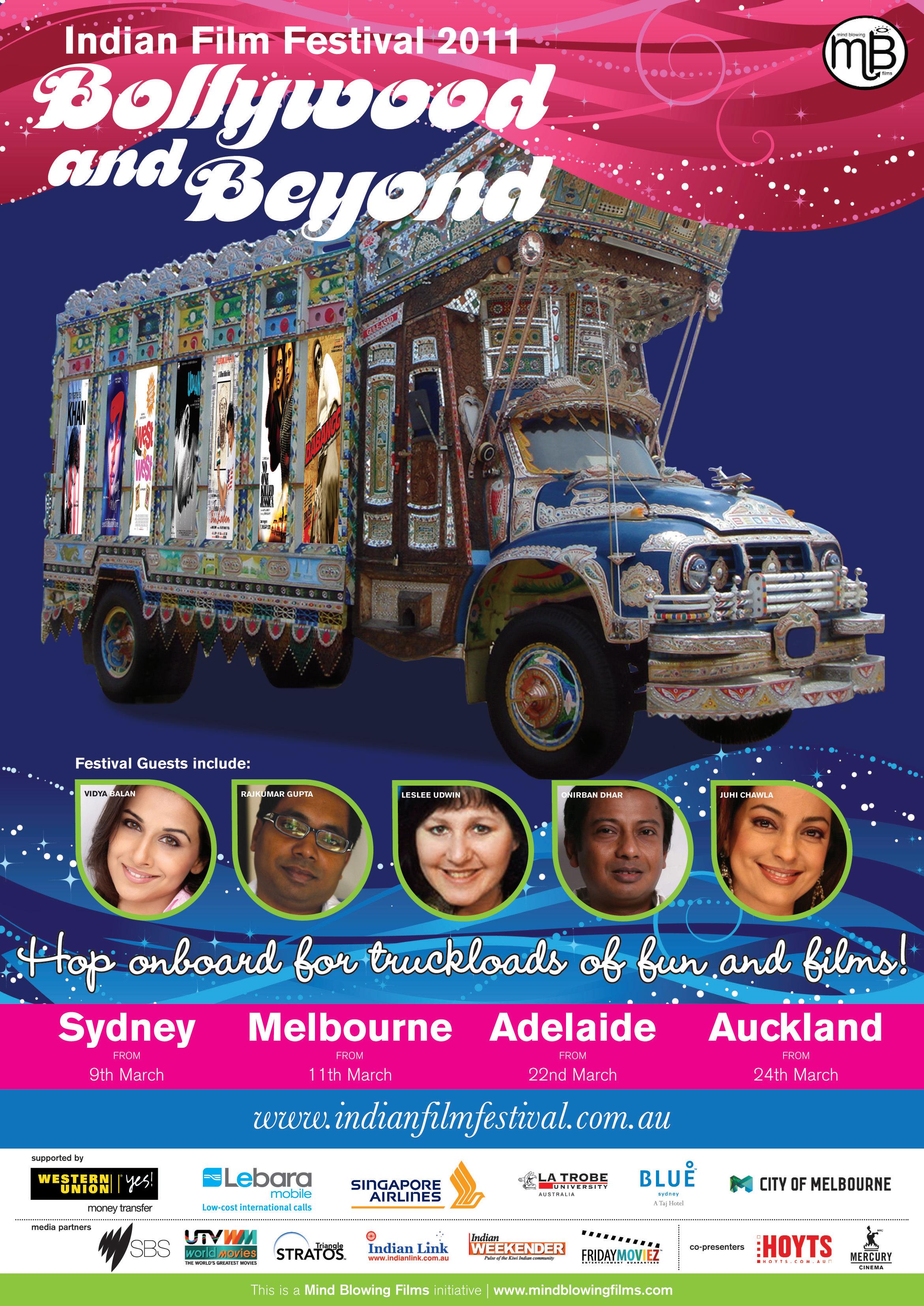
72 <> FEBRUARY (1) 2011 INDIAN LINK
ARIES March 21 - April 19
Tarot ‘n’ You Tarot ‘n’ You
Tarot predictions for February 2010
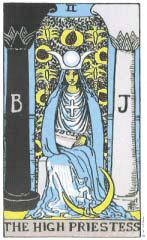

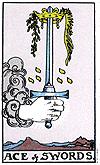

Tarot predictions for February 2011 Tarot








LIBRA September 23 - October 22
By NANCY SOOD
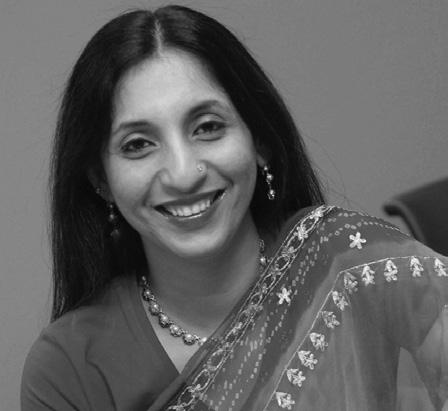
You are on a roller coaster ride of positive self-expression, with an abundance of thoughts and plans. You seem to be charging ahead as usual with many different ideas and energy. In a relationship reading, it seems there is a possibility of a moment of truth and also the chance of a crisis. There is nothing to worry about as you will bounce back as always, as you really need to clear the air this time.
TAURUS April 20 - May 20
You have so much energy at the moment. To add to it, you are thinking positively too, so make the most of it all. There are many inchoate dreams and visions; the full moon will bring in many distractions and your innermost desires and feelings will come out in the open. You have some difficulties at work with a colleague, but your cool, calm behaviour will get you through. You are quite a favourite with your superiors at the moment.
GEMINI May 21 - June 20
You are all wired up in networking at the moment: it will surely bring in many new opportunities. There are many changes around you, as you will do a lot of self evaluation and self analysis. The cards indicate that you are also making decisions about your future course of action and a certain relationship. The month end brings in vibrancy and closer associations with friends and family, whom you may have been neglecting of late.
CANCER June 21 - July 22
You are being sensitive and loving lately and can see the results as things are going your way, especially at work. If looking for work, there are opportunities coming. You will be out and about this month, but will also miss being at home. There may be some issues in the family with the health of an older member being a worry. Towards the end of the full moon, you will find courage to do what you want to do.
LEO July 23 - August 22
There seems to be a lot of ideas of travel and a change of scenery. There seems to be a feeling of wanting to break from the norm and do things differently. You feel quite stuck at the moment and the cards show that you need to give yourself a chance to decide what you want to do. Things are a little hectic around the full moon; be careful not to lose your temper when driving.
VIRGO August 23 - September 22

The mood this month is set to be harmonious, even romantic. Communication will be your strongpoint, so make the most of it, especially towards the end of the month as the full moon approaches. Your partner/ colleague may be stressed out, but you will be supportive and calm. The cards also show that you will pamper yourself with some new purchases this month, so splurging is in order: that is the effect of the full moon.
You are filled with romantic thoughts and feelings this month. That’s good, because things have been a little up and down lately. You will find yourself in a deeper connection (with yourself/someone else) which will give you a lot of peace and harmony. Financially there is some good news, as you will find new contracts and contacts coming your way, so make hay while the sun shines. Health-wise, stick to good eating habits this month, avoid greasy food.
SCORPIO October 23 - November 21
You seem to be very busy this month as there is high activity in your partnership house; you may experience some highs and lows. You are very caring and sharing at the moment but the cards show that you will be tempted to go into retreat mode this month, as you may be a little low on energy because of rushing around so much. There could be a purchase of a new car (Tarot shows the colour red).
SAGITTARIUS November 22 - December 21
You are currently going through a creative phase and your artistic streaks (or inventive ways) are truly amazing. Towards the end of the month, enthusiasm and excitement will reach fever pitch and you will find yourself speaking to many friends and colleagues about matters you have never discussed before. Harness this creative force to your benefit. Try not to be too harsh on someone you do not like at the office, you may regret your words.
CAPRICORN December 22 - January 19
You will feel home-oriented, with your family being a source of both mental and aesthetic delight. You are struggling to ground your creative vision, thus making it a practical reality. Your energy levels will increase and you will feel something deep inside you changing - your attitude, way of life and mode of survival. Things have been very difficult of late, but hone in on all you have achieved, embrace all that is coming your way. Try some meditation.
AQUARIUS January 20 - February 18
You’ve had a busy time lately – a lot to think about, perhaps. Your need for security is becoming stronger. The full moon brings issues of communication to the forefront. The cards show that you could also have a health issue – back pain, perhaps: take care when bending or lifting. There is going to be a holiday planned, as you have been working all hours and need to have a rest. You could take some time off to refresh yourself.

PISCES February 19 - March 20
You are on a communication rollercoaster this month, and your popularity and expansion are both growing. There will be some intimate sharing with loved ones towards the end of the month, and you will pour your heart out, which you have needed to do. You seem to be on a spiritual journey of late and also need to look at what you really want to do in life. Some of you Pisceans are a bit bored… aren’t you?!
INDIAN FOOD TAKE AWAY FOR SALE
Indian Food Take Away for sale in Norwest Business Park.
Shop located in food court of shopping centre with Woolworths and many speciality shops. Shopping centre within walking distance of private hospital, offices and surrounded by land for future development.
Site offers great potential for future growth.
All offers will be considered.
CALL 0408 474 417
FEBRUARY (1) 2011 <> 73 NATIONAL EDITION
STARSFORETELL
www.nancysood.com
www.indianlink.com.au • Available in Goulburn north • Approx 700-1000sqm • Tenant to fit out to your liking • No goodwill money • Just fit out and start making money • Long term lease is sought, very generous • Establishing period ph: 0406 539 308 Supermarket Premises
BUZZThe
Caterina’s cabaret
Bhindi Bazaar Inc. has been making webwaves with its impressive preview on various internet sites. The movie, by London based producer Karan Arora of Highground Enterprises is on the ascend where momentum is concerned.
And one of the reasons for its hype seems to be thanks to Caterina Lopez, sexy-hot cousin of equally sexy-hot Jennifer Lopez, who has done a sultry item number for the movie.

The beautiful and exotic Caterina Lopez has performed a sizzling number as a bar dancer, at a crucial time in the movie. The song marks a turning point in the script, revealing a suspense that shockingly takes the plot to another level. The lyrics of the song, Taan ke seena... ho ja kameena are reminiscent of the cabarets performed in the sixties. Caterina seems thrilled with her work on the item number. “I jumped at it, as this gave me the perfect chance to work in Mumbai and get familiar with Bollywood. The way Jennifer has made her own mark in Hollywood .... I would love to leave my footprints in Bollywood. I am sure this number is going to be 2011’s no 1 item song!” she enthused. Caterina is excited
GUESS WHO
for all the right reasons - she loves being in Mumbai, is a Shah Rukh Khan fan, wants to learn Hindi, is not averse to making India her second home, and finally, to making a career in Bollywood.
The Latin beauty feels that the song was a good opportunity for her to try her luck in Bollywood. “I did have a good idea about the industry here. I thought this song would be a great platform for my Bollywood introduction. I also quite liked the song, and really connected with it,” Caterina said.
Of course, she did have her share of difficulties while shooting the song in Hindi, an alien language for her.
“It was not easy learning the whole Bollywood style of dancing because it’s very different. Learning the song was also very tough but once I got the hang of it, it became better. Honestly, I think I did a good job,” she said.
Bhindi Bazaar Inc. also stars critically acclaimed actors Deepti Naval, Kaykay Menon and Pawan Malhotra among others.
Well, if she’s anything like her glam Hollywood cousin, we can be sure that Caterina’s cabaret will be a hit, regardless of bhindis or bazaars…
Glitz, glamour galore at Imran-Avantika wedding reception
Be it out of love for the newly-married couple or the sheer goodwill their superstar uncle Aamir Khan enjoys, people from every generation in Bollywood, along with bureaucrats, businessmen, politicians and players graced actor Imran Khan and Avantika’s wedding reception.
The party began late in the evening on February 5 at the Taj Lands End hotel, and continued into the morning of February 6, but everyone had a good time. Shah Rukh Khan was the last to arrive late in the morning but he was at his jovial best. Aamir received him at the gate with a warm hug.
His success on the ramp did not translate to the silver screen

(Find the answer under Caption Contest)
Shah Rukh and his wife Gauri are seen as the ideal couple in Bollywood, but the superstar didn’t give any golden tips on matrimony to the couple. “I charge for my advice. I don’t give free advice to anyone,” he joked again.
Asked what he gifted to the couple, he said, “I hugged them tightly with love. I don’t think any gift can be bigger than my heartfelt love.”
Imran married his long-time girlfriend Avantika in early January, and the reception
was held after the couple returned from their honeymoon in Thailand.
Among the first ones to arrive at the gala reception was master blaster Sachin Tendulkar with wife Anjali. Yuvraj Singh and boxer Vijendra followed them. They stayed for few minutes and left after wishing the couple.
From the film fraternity, the whole Kapoor family - Shammi Kapoor and his nephews Rishi Rapoor and Randhir Kapoor arrived together to bless the newly-weds. Kareena Kapoor and Ranbir Kapoor too joined them.
Dev Anand and very surprisingly, Dilip Kumar with wife Saira Banu, too graced the occasion.
Salman Khan, R. Madhavan with wife Sarita, Akshay Kumar with wife Twinkle Khanna, Hrithik Roshan with wife Susanne Khan, Suniel Shettty, Govinda, Jackie Shroff, Bobby Deol, Anupam Kher, Irrfan Khan, Dharmendra, Vinod Khanna, Tusshar Kapoor and his father Jeetendra, Zayed Khan and Sanjay Khan were among the celebrities who attended the bash.
Bollywood beauties Madhuri Dixit, Juhi Chawla, Priyanka Chopra, Katrina Kaif, Preity Zinta, Anushka Sharma,
Rani Mukherji and Vidya Balan too made an appearance. Deepika Padukone arrived with her friend Siddharth Mallya.
Juhi recalled, “I’ve known Imran since he was a kid. He played the role of young Aamir in Qayamat Se Qayamat Tak. I wish them all the very best and a very happy married life.”
Among Bollwood producers and directors, Ashutosh Gowarikar with wife Sunita, Milan Luthria with wife Liane, Sudhir Mishra, Raju Hirani, Imtiyaz Ali, Vidhu Vinod Chopra, Yash Chopra with wife Pamela, Mukesh Bhatt and Farah Khan, all came to wish the couple.
DEEPIKA PADUKONE

74 <> FEBRUARY (1) 2011
ENTERTAINMENT
CATERINA LOPEZ
“We are very happy that all our friends, colleagues and seniors are attending the reception to offer their best wishes to Imran and Avantika. I spoke to Amitji but he is not in town, so he was unable to attend the party,” revealed Aamir.
And as with the rest, we all wish the happy couple a blissful wedded life.
Dhoondo, Deepika, dhoondo!
She is still looking for the right man, says Deepika Padukone who is often spotted with industrialist Vijay Mallya’s son Siddharth, after breaking up with Ranbir Kapoor.

“I haven’t thought of marriage. I still have to find the right man to even consider marriage,” Deepika said recently at Imran Khan and Avantika’s wedding reception, where she arrived accompanied by the faithful Siddharth.
When asked about their relationship,
airport after a shoot in Bhopal to be there.
Let’s hope Imran makes the same effort whenever Deepika makes up her mind or finds her man – whichever comes first!
Marriage venue mayhem for Celina
Celina Jaitly has finally fixed the happy day to tie the knot with Dubai-based Austrian businessman Peter Haag, and the event will be on September 23, 2011. However, her choice of venue for holding the wedding is a bit confusing, as Celina’s decided to marry in Egypt, which is currently going through political turmoil, with a series of protests and demonstrations leaving the country in turmoil. However, Celina remains optimistic that things will settle down by September. “By September I’m sure everything will be back to normal in Egypt. It has to be. A strife of this sort cannot last for more than some days. Peter and I will take our marriage vows in Egypt and nowhere else. We decided that when we


decided to get married. That won’t change,”
Celina is the country’s tourism ambassador
She intends to visit Egypt as soon as the present unrest subsides, possibly to begin plans for what seems to be an extravagant ceremony. “The recent events in Egypt have left us all completely and totally astounded. Whatever happens next will impact Egypt and its people in a big way. My prayers are that whatever the outcome, it should be of a positive nature,” said the actress who last visited the country in “I spent an entire month there until midDecember on a shoot. I attended the Cairo film festival as a member of the jury, and even shot for an ad campaign all over Cairo without a clue about any (such) incident taking (place
Celina has initiated a campaign for peace in Egypt on her official website. “It’s called Pray For Egypt. Twitter followers are invited to offer their prayers for peace in the region,” said the actress who has worked in films like No Entry Golmaal Returns
So will the Egyptians sort out their internal problems by September to accommodate Ms. Jaitley’s matrimonial plans? I wonder….
Hot ‘n’ cold for Hum Dono
The coloured version of Dev Anand’s 1961 Hum Dono has got a mixed response from cinegoers. Middle-aged viewers, curious to see it in its new form, are enjoying it, while youngsters don’t find it too interesting.
“The response has been terrific. It is something unheard that even after 60 years of Dev Anand being in the industry, the film is still running. It is a wonderful and a memorable movie. Our first show ran houseful. I am confident that the film will do well,” said Piyush Raizada, director, Delight Cinema in an interview.

The 1961 black and white classic has been colourised in the US and is in CinemaScope with Dolby Digital Ex surround sound. It was released in 250 screens all over India recently - of them, 101 theatres in Mumbai and 45 movie halls in Delhi viewed the movie.
Directed by Amarjeet and produced by the legend himself, Hum Dono was the last black and white film from Dev Anand’s banner Navketan and he played a double role for the first time.
But the film has failed to attract youngsters.
“People in their forties who must have watched the film in their younger years, are more curious to see the film. Youngsters don’t seem much interested,” admits Amit Awasthi, senior manager (Programming and Operations) Spice Cinemas.
Yogesh Raizada, corporate head (Cinemas) of Wave Cinemas, echoed similar views. “The response has been lukewarm. I believe it’s the generation gap that is keeping youngsters way. I don’t think it would run for long,” he said.
CAPTION CONTEST
What’s the chitchat between Priyanka and Shahid?

Send in your responses to info@indianlink.com.au and win a surprise prize
Last issue Caption Contest winning entry
What are Suneil Shetty and Anil Kapoor saying to each other here?

Kya kool hain hum, even after all these years….
Priya Verma
Armidale NSW
Priya wins a free ticket to new release
Saat Khoon Maaf
Some other good ones
With a bit of plastic surgery and hair dye, we can still give the young actors a run for their money.
Raj Saneja
Sunil to Anil: How could the 24 producers not notice me?
Maninder Sandhu
FEBRUARY (1) 2011 <> 75 www.indianlink.com.au
GUESS WHO :ANSWER Milind Soman
DEV ANAND CELINA JAITLEY
AVANTIKA AND IMRAN
Roti Kapda aur Makaan
Some Bollywood movies deal with a variety of social themes, but a few gems actually tackle this sensitive concept with humour and laughter
BY SHRADDHA ARJUN
Lately, it’s been one scandal after another on the Indian landscape. First was the CWG circus, then the 2G Spectrum scam, followed by the Adarsh Society scandal
Peepli Live (2010)

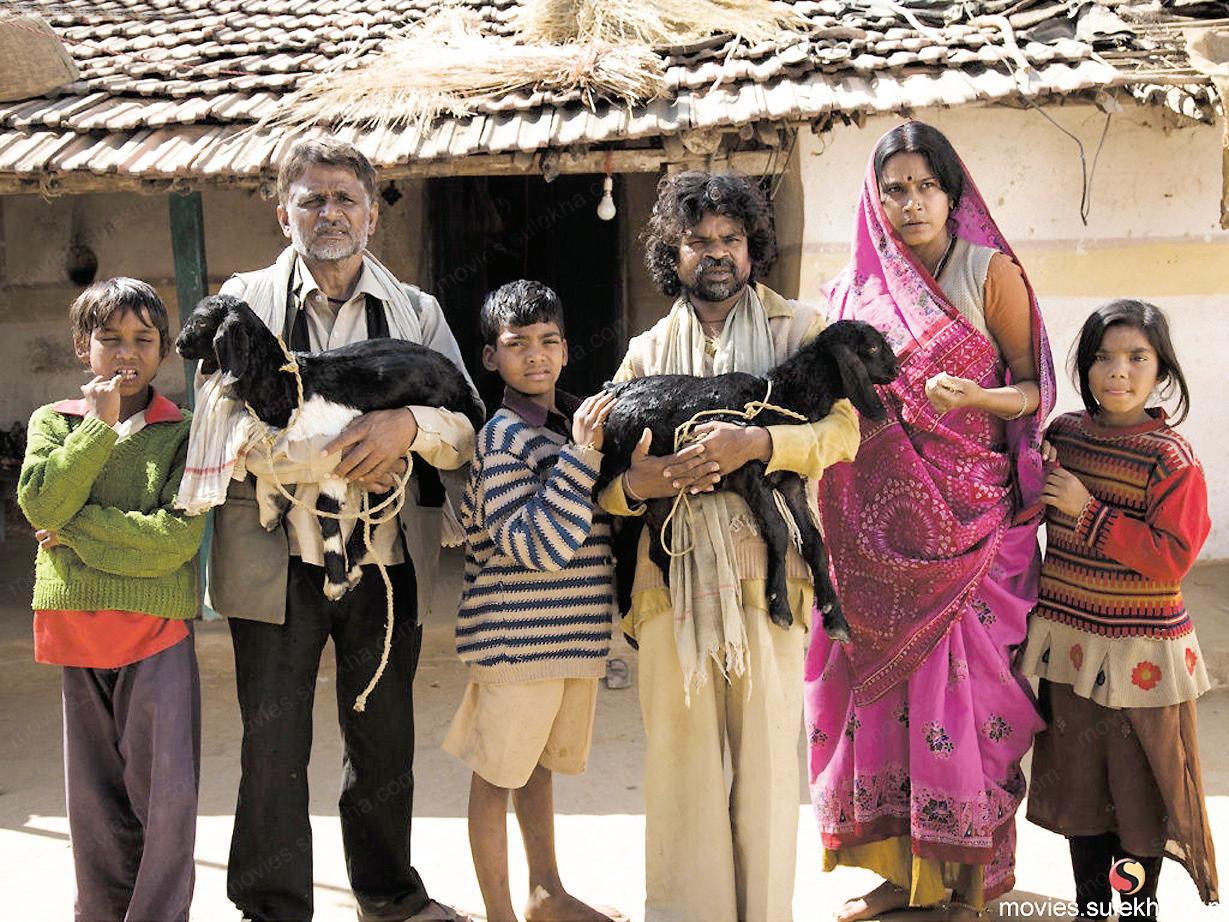
and now, the rising price of food and basic necessities. The common man in India seems to be bearing the brunt of it all. There have been many films made on a very serious note reflecting these realities of society, but only a few films talk about these issues in a lighter vein. Here’s a countdown of films that take a comic look at the problems faced by the common man.
Do Dooni Char (2010)

This film by Habib Faisal starring yesteryear’s sweethearts Rishi Kapoor and Neetu Singh, is a family entertainer that is genuinely heartwarming. Middle class family man Rishi Kapoor does an honest day’s work as a teacher and a private tutor after hours. His dream is to buy his family their first piece of luxury – a car. While touching upon many pressing issues such as match-fixing, corrupt policemen, unaffordable prices of commodities, this simple film does not point fingers at anyone. It also addresses several other issues such as outsourcing (call centres), consumerism and the deteriorating value system that exist in Indian society today. The film is well written and even the grimmest situations are presented with a sense of humour. The best part is the happy ending, where the family is seen cruising the streets in their brand new car.

Khatta Meetha (1978)

This film has been a wonderful example of how a commercially successful film can also gain critical acclaim. The grim topic of farmers’ suicides is presented with a whacky sense of humour, but the message gets home loud and clear. The film also lampoons news organisations for their sensationalism and tendency to blow issues out of proportion. Issues facing rural India are brought fair and square to the forefront, hopefully to the powers-that-be. With Satyajit Ray-like courage, first-time film-maker Anusha Rizvi chose to cast unknown or lesser known actors, and to keep the dialogues raw and unpolished to add to the humour. The film is definitely worthy of the appreciation it has received on the international film festival circuit.
This film belongs to an era when films were made with small budgets and had simple and interesting storylines, and beautiful hummable songs. The movie has the veteran Ashok Kumar in the lead with Pearl Padamsee, Rakesh Roshan and Bindu. The story of two middle class families which unite as a result of remarriage of the parents, there are plenty of laughs as chaos rules in this strange blended household. Yet the issues of unemployment, rising prices and dreams of aspiring to higher levels in society, all crop up, and at one stage, homelessness looms large as well. But the family stick it out through thick and thin, managing to maintain dignity in a manner that is truly heartening. This film is undoubtedly one of the finest films made by Basu Chatterjee.
Munnabhai (2006)
Raj Kumar Hirani is often called the Hrishikesh Mukherjee of the 2k-generation of films. Who else would have had the courage to cast Sanjay Duttwith his bad boy image - as Munnabhai? Both films are about a menacing thug and his transformation into a humane and generous individual. This image makeover did wonders to Sanjay Dutt’s career. The character of Munnabhai is definitely “filmy” so to speak, however the film deals with issues of the man on the street. In the first film we catch a glimpse of the appalling situation of the healthcare system and the tyranny of moneymaking private hospitals and medical institutions. The second film takes a step forward and delves into other issues faced in society such as inequality, corruption and unethical practices. It manages to remind us of

76 <> FEBRUARY (1) 2011 INDIAN LINK
An old British club ENTERTAINMENT
Golmaal (1979)


This is one of those timeless Hrishikesh Mukherjee classics which can be watched often and yet have the same effect at every viewing. (Ask me –I’ve seen it so many times that I can now roll off mouth the dialogues by heart!) It stars Amol Palekar, Hindi cinema’s quintessential ‘common man’, and touches on many issues such as unemployment, generation gap, undue influence of western values, and the disparity between rich and poor. The story as we know it is about an accountant who is willing to do anything to keep his job – to be able to provide for his sister and her wedding. What he does in the process, and the consequences he faces as a result of his actions, are what makes the film funny. There is no dull moment in the film. The comic timing of the characters, especially that of thespian Utpal Dutt and Amol Palekar is impeccable.
Jaane Bhi Do Yaaron (1983)

This laugh-riot is a satire about the “system” which is crumbling. The lead characters Naseeruddin Shah and Ravi Baswani are honest and simple photographers seeking work, who get entangled in a sting operation that backfires. There are impediments to the system galore, such as manipulative politicians, lobbyists and dishonest builders and industrialists who cause damage to the nation and its people. When the media, the fourth pillar of society is misused as well, it makes things worse for the people as they have no other means of gauging the truth. The film captures the sentiments of underpaid and unemployed youth and the helplessness of the man on the street. So how does one make such a dismal subject so engaging and most importantly funny? In my opinion it’s the combination of the right people at the right time, with the likes of Pankaj Kapoor, Nina Gupta, Om Puri and Satish Shah adding to the cast. An absolute delight.
Khosla ka Ghonsla (2006)

Building a house of one’s own is a dream for many. This film directed by Dibakar Banerjee is a humorous take on the difficulties that the common man in India faces in the process. Issues such as corruption and bribery, a failing legal system, the deterioration of ethics, brain drain and that alluring “American Dream”, make up the backbone of the film. Hilarious from start to end, even the direst situations like death, imprisonment and injustice are portrayed in a lighter vein. Veteran actor Anupam Kher is at his comic best; and Boman Irani is equally convincing as the bad guy, and both are immensely entertaining. The manner in which the family makes use of loopholes in the system to turn the situation around in their favour, will have you in splits.
Pushpak (1987)
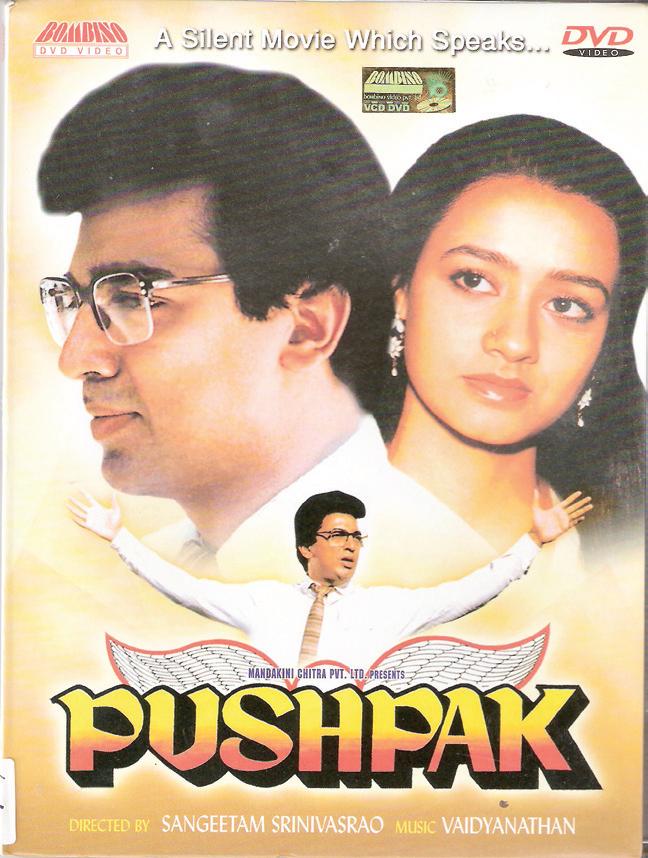
One man who has the audacity to break clichés and stereotypes in cinema, and goes to great lengths to experiment, is Kamal Hassan - an excellent example of an actor who is capable not only of charming the masses, but also stimulating their minds. Having grown up on a staple diet of Kamal Hassan’s films, I’ve seen him try to outdo himself each time. Here he teams with director Sangeetham Srinivas (with whom he’s always created magic) and music director Illayraja. The film is special not only because it has many well-known faces and names, but also because it is a silent film of the genre of Charlie Chaplin and Laurel and Hardy (albeit minus the texts). The film deals with the common man’s aspirations as opposed to the issues he faces. Kamal’s character, an educated unemployed youth, is in dire straits but gets the opportunity by chance to live the life of a rich man. However when he experiences this lifestyle, he turns skeptical, and gives it all up! The bit in the film about a beggar on the street showing off his wealth accumulated by begging to an educated unemployed young man, is a slap on the cheek to the government. Apart from being a comedy, this film also has a romantic track running parallel to the rest of the plot, which is equally interesting. A must watch indeed!
Well Done Abba (2010)

Shyam Benegal is known for excellence in cinema and is well respected as a filmmaker. He has been quite successful at telling stories to audiences of all ages. Though this film was not commercially successful, it brought out many sensitive issues, again presented in a lighter vein. A director of his calibre is more than capable of making such a simple and effective work of art. Boman Irani’s
talent and potential is fully exploited in his role of a driver who hails from a small town in Andhra Pradesh. The film is about a government scheme that provides for digging wells for the residents of the impoverished village. Corruption and bribery at every stage of the process seems to squeeze out the best in him and his daughter (Minisha Lamba) with no outcome at all. So they decide to go on a hunger strike until they are given what they are rightfully entitled to. A positive and engaging film.
City of Clubs
the Gandhian philosophies and principles that are lacking in today’s modern India. Benevolence, compassion and honesty are values propagated by the protagonist throughout the film. The humour is situational, but sometimes philosophical. With the childlike charms of Circuit played by Arshad Warsi, this is one film that’s worthy of yet another sequel.
When English dwellers in Kolkata increased, it was inevitable that they would try and find a place of their own to play sport and socialise in the same way they would have done at home. That gave rise to the idea of clubs and the first to be established, not just within the city but in the entire subcontinent, was the Calcutta Cricket and Football Club, built in 1792. Next followed the Calcutta Racquet Club in 1793, the oldest squash club in the world that still exists at the same location where it opened its doors two centuries ago. The Bengal Club, which is compared to the esteemed Oriental Club in London, was the first social one to emerge on the scene in 1827. Many more followed – clubs for golf, tennis, swimming, rowing and the list went on with several local additions coming later. Thus was Kolkata dubbed the “City of Clubs”. Today these clubs are the playground for the elite, and their style, tradition and etiquette may not be found anywhere else in the world.
All these films have hardship and problems, but the underlying message is that there is also hope! These films bring that message across and tell us not to take life’s obstacles too seriously, that we should not dwell upon them but take them with a pinch of salt and face life with a smile!
FEBRUARY (1) 2011 <> 77 NATIONAL EDITION
www.indianlink.com.au
0
Cine Talk
Funny and moving
Film: DilTohBachchaHaiJi
Cast: Ajay Devgn,Emran Hashmi,Omi Vaidya,Tisca Chopra,Shazahn Padamsee, Shruti Haasan, Shraddha Das
Director: Madhur Bhandarkar
Ummm….Picture to achcha hai jee! Disregarding the rather strenuously upbeat ending Dil Toh Bachcha Hai Ji (DTBHJ) turns out to be quite a charming and clever concoction. Though this time Madhur Bhandarkar, one of the strongest celluloid creators of contemporary times, veers into virgin territory, the trademark Bhandarkar touches, like the almost-incestuous use of sex as a bartering point between the sexes, are evident everywhere in this multi-plot story of love, sex and betrayal during times of laughter music and backchat in Mumbai.
The writing (by Bhandarkar, Anil Pandey and Neeraj Udwani) weaves skillfully through the hearts and conscience of our three main characters who are designed to be a study in contrasts and yet so believable, you can touch their lives by just watching them stumble, fall and redeem themselves in tentative, sometimes funny, sometimes moving ways.
This, then, is the story of three housemates wading through the concrete jungle of Mumbai in search of love, sex and, yes, a sense of belonging. Their homes, hearts and environment look believable.
Though projected outwardly as a comedy, DTBHJ has deeper, darker resonances that we cannot miss even if we are too busy laughing at the protagonists’ clumsy attempts to get lucky in love.
Bhandarkar’s narration communicates that sense of empty enjoyment that you can feel under all the glitz and noise of Mumbai’s racing pulse. Omi Vaidya, who plays the most idealistic love-seeker of the triumvirate, says to the go-getting struggler from Mumbai (Shraddha Das) at a pub, “How can people talk in here?” She of course doesn’t hear him. She’s lost in the pursuit of her wanna-shine dreams that take her further and further out of reach of true love.
Vaidya is in splendid form here, far more in control of his character’s destiny than in 3 Idiots. In the way he hybridizes his yankee accent with Marathi and a sense of earnestness with a subtle tone of mischief, Vaidya is absolutely endearing. So is Emran Hashmi.
Playing the character with the steepest graph, Hashmi goes from Tisca Arora’s toyboy to the new-age Devdas rejected in love by the savvy NRI chick who has social conscience and a
practical attitude to men.
When Shruti Haasan (looking so lovely you know she’s found her metier in Hindi films) turns around and tells the philanderer, “Yeah, so we slept together. So what? It wasn’t your first time nor mine,” you know that Bhandarkar has not abandoned his scathing and savage exploration of urban values which made his heroine-centric dramas from Chandni Bar to Fashion so unforgettable. He’s only added laughter to his cinema.
In DTBHJ, Bhandarkar walks a tightrope. He has to balance the laughter with the dark underbelly of Mumbai’s beautiful, but alas, desolate people. Besides the powerful writing (Sanjay Chel’s dialogues are tongue-in-cheek and sometimes killing in their effectual demolition of the sacred cows of urban conduct) and razor-sharp characterization (barring the caricatured people in Devgn’s office), the film gets high marks for dead-on casting.
Every actor breathes life into the constantly mutating comedy. If we care for all the three love stories that run in criss cross but never crass fashion, it is because the actors go beyond their own personalities in search of the people they play. While Omi Vaidya and Emran Hashmi make a great impact, it is Ajay Devgn, echoing Amol Palekar’s Common Man from the 1970s, who must be congratulated in
the loudest voice for abandoning his 6-pack mean-mirth-machine image to play a mousy middle-aged divorcee with the hots for his comely secretary.
Among the female cast, Shazahn Padamsee is extremely easy on the eyes and fits her bubbly ingenue’s part like a chic glove. Tisca Arora as the bored socialite who strays into a lust liaison with an ever-ready glorified gigolo, lends a certain weight to the proceedings with her fiery eyes.
DTBHJ is a true-blue sex comedy that doesn’t lapse into unnecessary passages of vulgarity and innuendos. Though Bhandarkar has sought inspiration from the romantic comedies by Hrishikesh Mukherjee and Basu Chatterjee, the style of storytelling and the tantalizing merger of libido and urban morality would have flummoxed those celebrated comedy makers.
Times have changed. So have the films. Thankfully we still have filmmakers who believe the story is the hero. This is the world of Bhandarkar’s Page 3 coming together with the laughter of Blake Edwards’ rom-coms. A must-see film with enough meat in the plot to keep us engaged till the end. And three actors who never take off their shirts even when they are sweating in nervous anxiety.

78 <> FEBRUARY (1) 2011 INDIAN LINK
ENTERTAINMENT
Subhash K. Jha
Film: Yeh Saali Zindagi
Cast: Irrfan Khan, Chitrangda Singh, Arunodoy Singh, Aditi Rao Hydari
Director: Sudhir Mishra
A roller-coaster ride not for the weak-hearted
Yeh Saali Zindagi has some terribly funny moments of violence where you shock yourself by laughing at the senseless callousness of the killings. We have ruffians with thick Haryanvi accents who just gun down a man and then wonder why they killed him. In another funny sequence, a goon is asked to kill his own brother-in-law. The goon acts scandalized but instantly pulls the trigger when the price is right.
To be or not to be bad is no more the question. Being evil is fashionably acceptable.
There are hardly any reposeful moments in the narration. The breakneck storytelling replicates the restlessness of the characters. With a maestro’s adeptness, Mishra weaves two love stories into the panoramic view of crime and corruption.
While Irrfan Khan plays a man taken by surprise by the eruption of unconditional passion for a crooner who gives a damn about him, Chitrangda’s gold-digger act is a sophisticated variation of Vidya Balan’s conniving seductress in Ishqiya . Her character has been created with a sensuous vigour that very few actresses in Hindi cinema can boast of.
To describe the roller-coaster ride that is Yeh Saali Zindagi is to attempt to draw the picture of the Red Fort at the seaside. Every attempt to define the plot will be washed away by forces beyond our control. So let’s just say, it is an edgy and raw take on what it takes to make love, loyalty and other related illusions jell in a rapidly-mutating consumerist society like ours.
The film is set in Delhi’s underbelly. Mishra explores the capital’s get-rich sub-culture, revealing a flair for satire even at the most deplorable moments of reckoning. Yup, Guy Ritchie and Quentin Tarantino would approve of Mishra’s humour in the most sanguinary circumstances.
Almost every character in this foul-tongued treatise on love, lust and longing during times of gang-wars, is stricken by a get-rich-quick itch, which eats into the very core of their existence, corroding their sense of propriety.
But Yeh Saali Zindagi is not a film that invites you to watch the characters’ perform. It instead spreads the characters out in a wide, unmanageable net of indeterminate purpose but definite motivations. Get rich, fast, is the magic mantra.
Arunodoy Singh, as the tough Delhi jail-bird Kuldeep, exudes the scent of self-destructive aspirations. Not surprisingly Arunodoy’s character is constantly running through crowded marketplaces and congested roads of Old Delhi, pursuing his angry and defiant wife (Aditi Rao Hydari). Arunodoy furnishes this love story with a sweaty passion, a far cry from his uncomfortable presence in the Aisha.
Chitrangda plays the part-time crooner, full-time wealth-chaser with a robust but feminine cunning. She is a temptress, a fighter and packs a punch into her oomph.
And when she finally surrenders to the overpowering devotion of Irrfan’s character, she transforms into a woman with a conscience.
Conscience is a scarce commodity in Mishra’s films. The characters are wild, boorish misfits who probably bathe once every week and go to the temple only to steal the deity’s jewellery. Indeed gangsterism acquires an extended sense of humour in Yeh Saali Zindagi. But one wishes the film had gone easy on the expletives and profanities.
Garnished with innovative music by Nishat Khan and Abhishek Ray, Sachin Kumar Krishnan’s camera captures Delhi in all its eccentric quirky askew glory. Yeh Saali Zindagi has stand-out performances by Arunodoy, Chitrangda, Aditi, Saurabh Shukla, Sushant Singh and Yashpal Sharma.
But it’s Irrfan Khan who leaves the deepest wound on the bloodied face of this savagely funny film. He is able to put across all the turmoil and confusions of an otherwise-hard-headed man who can’t understand his burst of passion for a woman of dubious means and even more dubious morals.
Yes, the narrative meanders. We often don’t know what it’s looking for. Just like the characters who are lost in a labyrinth of kidnapping, embezzlement and sex. The people in Mishra’s movie are forever seeking selfgratification through means that are quite outrageous from the outside though perfectly explicable from the perspective of the perpetrators.
Yeh Saali Zindagi is like of those nightmares that you have probably seen on a feverish night. The acts of injustice perpetrated by the characters nowhere suggest that they are compelled by circumstances to act as criminals. These people just can’t help being bad.
Brutal, savage, funny and violent, Yeh Saali Zindagi is not for the weak-hearted.

Music still sweeps you away in this old classic
Film: HumDono(colouredversion)
Cast: Dev Anand, Sadhana, Nanda Director: Amarjeet
Abhi na jao chhod kar ke dil abhi bhara nahin…
The anthemic love ballad in Hum Dono, regarded as one of the finest love songs ever composed for Hindi cinema, rings through your heart after the lengthy film is done - and let’s face it, nearly three hours of playing-time for a longforgotten war saga can get tedious when you have the next chapter in the Egyptian civil-war waiting at home.

Yes, Hum Dono is back. The 1961 film about two lookalike soldiers who become friends at war, is as far-fetched in plot as…say, today’s Dabangg or James Cameron’s Avatar
Indeed, the film’s old-world values of valour, integrity, loyalty, fidelity and trustworthiness seem to belong to another era, if not a completely different planet. They are rescued from fading by computer-coloured velocity.
Admittedly even today Hum Dono makes a fairly engaging triangular love story with war at its backdrop. The coloured version that has come to us now leaves us with mixed feelings. Though at first one enjoys the splash of colour that is added to V. Ratra’s outstanding blackand-white cinematography, a lot of the film’s original visual intensity is lost in the new translation.
We are left wondering who decided what colour Dev Anand’s shirt or Sadhana’s sari was meant to be! Did the colour-generating department check with the film’s core team to decide the colour schemes? If not, is it ethical or even legally permissible to tamper with the film’s creators’ original vision?
The Dolby-enhanced sound leaves no room for quibble. Jaidev’s music score, considered by many aficionados to be one the 10 finest Hindi motion-picture soundtracks of all times, heals all the wounds of excessive coloured flamboyance.
Whether it is Mohammad Rafi and Asha Bhosle’s duet Abhi na jao or Lata Mangeshkar’s immortal bhajan Allah tero naam, or those two imperishable Rafi ghazals Kabhi khud pe kabhi halaat pe rona aaya and Main zindagi ka saath nibhata chala gaya… you just can’t help being swept into the sheer melody of the moment.
The casually stylish way the songs are shot, the sharp close-ups being intercut with lyrical poetic long-shots, incidental but intense interludes of passion played out in the visual detailing, all carry the distinctive stamp of Vijay Anand
who wrote Hum Dono
The film’s direction is credited to Amarjeet, who later directed Dev Anand in a film called Gambler.
Ah, Dev Anand…a star beyond any definition of stardom! He shines with meteoric melancholy in the double role of men at war with themselves, much more than for their country. The way this debonair actor enacts the solo numbers by Rafi makes you wonder whether the song came first, or was it inspired by the face that conveys the numbers on screen?
Sadhana (impish, coquettish) and Nanda (tremulously poignant) are lovely supplements to the Dev Anand mystique. What was he thinking when he romanced these beautiful ladies? Surely more than what Sahir Ludhianvi’s love-lorn lyrics describe!
They don’t make stars like Dev Anand any more. They never will. Or for that matter a film so suffused in the splendour of its own cultivated grace - impossibly to come by in today’s era of pelvic passion.
Indeed, abhi na jaao chhod kar…
FEBRUARY (1) 2011 <> 79 NATIONAL EDITION www.indianlink.com.au
Subhash K. Jha
Subhash K. Jha
Renewing romance
that stink,” he’ll say romantically. “Turn off those candles, you’ll burn the house down. And the music too, I want to watch Californication . Where’s my beer? Why are the kids in bed so early?” And of course, the final nail, “What are you wearing? It’s too short, it’s too skimpy…have you put on weight?”
With that kind of response I don’t think I could explain that it’s Valentine’s Day and that we need to show at least a modicum of romantic affection in deference for the day. “Why?” he would ask, and I would, I admit, have no answer.
After knowing him for all these years, romance is taken for granted, if it’s taken at all. Gone are the days when he came over on the first V-day that we spent together, having surreptitiously plucked a wilting bunch of nondescript flowers from the neighbour’s garden downstairs to justify his lack of romantic gyan about the significance of the day. He smiled valiantly on seeing the bright orange oversized shirt from JC Penney that was his gift, and must have worn it, under emotional duress, about twice since.
“What’s that stink,” he’ll say romantically. “Turn off those candles, you’ll burn the house down. And the music too, I want to watch Californication. Where’s my beer? Why are the kids in bed so early?” And of course, the final nail, “What are you wearing? It’s too short, it’s too skimpy…have you put on weight?”
Now we stare into each other’s eyes when arguing, simply because to look away would be a sign of acquiescence, and hey, I’m not going to be the one to back down, specially when it’s your fault!
We do hold hands, when humouring our younger son when he insists on playing ‘Ring-around-theroses’. We do give each other gifts, or rather a budget to spend on something of our choice, after the month’s expenses have been sorted out. So what if its only $5.30, something’s better than nothing! Now romantic purists may argue that there’s no personal touch in such an arrangement, that your partner needs to be surprised, but I assure you, it will be a surprise, albeit an unpleasant one, if you actually decide on buying him something with that amount.
I feel like such a cynic. Seems like my romantic streak has lost itself in the layers of cellulite I’ve been trying to lose for years.
BY SHERYL DIXIT
A friend asked me, “How do you plan to celebrate Valentine’s Day this year?”
I stared at her as if she’d said something quite demented.
“What do you mean?” I finally managed to stutter, sounding like my voice had decided to take a trip down my throat to say hello to my intestines.
“Well, you know, will you get flowers or chocolates? Will you’ll do something romantic together? Will you get him a gift, like a watch or new silk boxers with hearts or something?”
“I don’t think so,” I said, and felt compelled to explain as she cocked her head to one side, gazing at me with a trustingly enquiring look.
“I’ve been married ten years and have two kids,” I blurted out lamely.
“All the more reason to celebrate!” she said complacently.
I said goodbye quickly, resisting the urge to
throttle her with the cord of one of those huge, red, heart-shaped balloons that are currently infesting shopping malls, reminding us that February 14 isn’t far away.
Now I don’t blame her, she’s in her mid-20s, has had a ‘steady’ boyfriend for about six months and they’re just about starting to talk about moving in together. I applaud their intention of going to an expensive resort to celebrate the day, indulging in their common love of red wine and seafood, while gazing into each other’s eyes and gifting themselves iPhones and Louis Vuitton handbags.
But after thirteen years of being with the same man, and spending ten of those occasionally in a state of dubious marital bliss, I feel inclined to give this concocted festival of looooove a miss.

I do have valid reasons, like it falls on a Monday this year. Mondays are not good days to think about love, simply because one hardly has the time between packing lunchboxes, doing the week’s shopping and racing to complete editing deadlines which I have slacked over all weekend.
Also, my husband would be completely bemused if the house was filled with candles, incense and soft music when he returned home from work. “What’s
Perhaps I should make an attempt at finding romance this V-Day, although the thought of our postie’s beer-suffused face and belly isn’t particularly appealing.
So perhaps I should try and bring romance into the home. Like attempt to make bisibelebath like his mom does. Hey, it won’t work, but maybe he’ll notice that I tried. Although it’s more likely that he’ll surreptitiously tip it in the bin and eat two bananas for dinner instead. And down them with a couple of extra beers.
Maybe I should get him a card, one of those mushy ones with lots of verse that he’s unlikely to read, which will be good as it wouldn’t make much sense to either of us anyway…too many words of four syllables. And enclose a large heart-shaped chocolate that he won’t eat. At least I’ll have a V-Day treat.
Or perhaps I should take my young friend’s advice and opt for the silk boxers with hearts on them. He itches in silk at the best of times, and that unique replacement in lieu of his conservative cotton shorts should be a sight worth seeing. Certainly, it’s unlikely that romance will be rekindled, but what the hell, we’ll die laughing instead.
So is humour a good substitute for romance this V-Day? You can bet your $5.30 it is!

80 <> FEBRUARY (1) 2011 INDIAN LINK
www.indianlink.com.au BACKCHAT
There must be innovative ways to rekindle feelings of affection between much-married couples, but sometimes a substitute emotion will do


FEBRUARY (1) 2011 <> 81 NATIONAL EDITION



82 <> FEBRUARY (1) 2011 INDIAN LINK

FEBRUARY (1) 2011 <> 83 NATIONAL EDITION


84 <> FEBRUARY (1) 2011 INDIAN LINK























 BY LP AYER
BY LP AYER






























 BY PAWAN LUTHRA
BY PAWAN LUTHRA



 BY MALAVIKA SANTHEBENNUR
BY MALAVIKA SANTHEBENNUR
















 BY TIM BLIGHT
BY TIM BLIGHT











































































 BY SHIVANGI AMBANI-GANDHI
BY SHIVANGI AMBANI-GANDHI




























 BY MADHUCHANDA DAS
BY MADHUCHANDA DAS


 BY SHERYL DIXIT
BY SHERYL DIXIT
































































































